Apollo 17
Day 5, part 3: Descent Orbit Insertion
Corrected Transcript and Commentary Copyright © 2018-2022 by W. David Woods and Ben Feist. All rights reserved.
Last updated 2022-03-30
090:41:00 - This is Apollo Control at 90 hours, 41 minutes Ground Elapsed Time. We've had Loss Of Signal. As the Apollo 17 spacecraft coasted behind the Moon on the first lunar orbit currently in an orbit measuring 52.6 by 168.6 nautical miles [97.4 by 312.2 km]. It will be up again in about 47 minutes or approximately. The tables are not up on the display here on the next Acquisition Of Signal as to the next time the spacecraft comes around on the second lunar orbit. Change of shift briefing at 3:45 approximately 10 minutes from now in the small briefing room building 1 news room. Participants Flight Director Gerry Griffin, Flight Surgeon Dr. Royce Hawkins, and the EECOM Charlie Dumis. At 90 hours, 42 minutes Ground Elapsed Time; this is Apollo Control.
090:XX:XX Evans: Yes, I don't know. Supposed to be - they say 4 minutes, but - I've got one going here. Thirty seconds.
090:XX:XX Evans: I guess all those switches and things are done, circuit breakers and things like that. SIM bay ESSENTIAL bus?
090:XX:XX Cernan: How do I know when it's out? When that thing goes gray?
090:XX:XX Evans: When it goes to gray.
090:XX:XX Cernan: Did we lose...
090:XX:XX Evans: I'll get all of the photos of the thing. [Garble]. Let's see now. Window 3 and 4. Yes, 3 and 4. And if - if you'll handle the mapping camera and all that stuff now, which is...
090:XX:XX Cernan: Yes, I'll give you the marks on all that stuff.
090:XX:XX Evans: Yes, that'd be - Jack, Gene, could you just kind of...
090:XX:XX Cernan: Hey, you got Omni Delta?
090:41:27 Evans: Gray? Gee, that was a minute and 30 seconds.
090:41:XX Cernan: No, it was longer than that, I bet.
090:41:XX Evans: No, it wasn't. Minute and 45 seconds.
090:41:XX Cernan: I bet it was 2 something.
090:41:XX Evans: No, it wasn't. I started the clock, and it - Either that or my - doesn't work. And I got a minute and 45 seconds.
090:41:XX Cernan: Yes. It was longer than a min - I'll bet it more than - Well, I don't know.
090:41:XX Evans: It's still pretty good. Okay.
090:41:XX Cernan: Okay. Omni Delta, and go minus 5 and 15 for AOS.
090:42:02 Evans: Oh, yes. Manual and Wide. 2 Minus 5, 15.
090:42:XX Cernan: And Delta. Right?
090:42:13 Evans: Yes, Omni Delta.
090:XX:XX Cernan: And you're on High Bit Rate, Record, Forward, Command Reset.
090:XX:XX Evans: Sunrise? Okay. Don't see anything yet. [Laughter.]
090:XX:XX Cernan: Okay. Okay; let's see, we want to get the - let's get the Pan Camera to Standby, Stereo...
090:XX:XX Evans: What time are we supposed to start here - 51, that's 8 minutes...
090:XX:XX Cernan: Are these all separate switches?
090:XX:XX Evans: Yes.
090:XX:XX Cernan: Standby - on Pan Camera?
090:XX:XX Evans: Yes.
090:XX:XX Cernan: Standby? Stereo? I can't - Put Jack's Intercom switch, On, will you, Ron?
090:XX:XX Evans: Okay.
090:XX:XX Cernan: Okay. Standby?
090:43:13 Evans: It's Standby.
090:43:XX Cernan: Stereo?
090:43:15 Evans: It's Stereo.
090:43:XX Cernan: Power?
090:43:17 Evans: It's Power now.
090:43:XX Cernan: V/H.
090:43:XX Evans: You want it now?
090:43:XX Cernan: Yes.
090:43:20 Evans: Okay. Power.
090:43:XX Cernan: V/H. High Altitude.
090:43:24 Evans: Okay. High Altitude.
090:43:XX Cernan: Okay, now. Laser Alt - You want the Laser Altimeter, On, too, huh?
090:43:XX Evans: Yes, but that's pretty much on a time thing yet.
090:43:XX Cernan: Okay. Wait a couple of minutes for that. Here's what we're going to do, Jack. We've got a couple of minutes. We want to put the Laser Altimeter, On, and about...
090:43:XX Schmitt: Did you want to start the pan?
090:43:XX Cernan: Not yet.
090:43:XX Evans: No, we aren't [garble]...
090:43:XX Cernan: No, I've got to start the - start that...
090:43:XX Evans: Go ahead.
090:43:XX Cernan: This thing's got Standby, Stereo, Power, and...
090:43:XX Schmitt: Got it.
090:43:XX Cernan: ...High Altitude.
090:43:XX Schmitt: Got it.
090:43:51 Cernan: Okay. Then the next things we're going to do - Don't do them yet - are Laser Altimeter, On; then Image Motion, On; then Mapping Camera, On; and Pan Camera - I'll give you a T-start on it. And then Image Motion, Increase...
090:XX:XX Schmitt: Okay.
090:XX:XX Cernan: What's BP plus four steps?
090:XX:XX Evans: That's barber pole plus four steps.
090:XX:XX Cernan: Oh, yes. Yes. Okay. And then...
090:XX:XX Evans: I do.
090:XX:XX Cernan: ...That's right. I'll give you all those calls, and they all come one right after the other starting about 48, and it's 44 now.
090:XX:XX Schmitt: Okay. Four minutes, Gene?
090:XX:XX Cernan: And then, Ron?
090:XX:XX Evans: Yes, okay.
090:XX:XX Evans: And then, Ron, yours is Gelley - Gell-oe,...
090:XX:XX Evans: Galois.
090:XX:XX Cernan: Gal-ois. And you want Command Module 3, you want the 80-millimeter lens - intervalometer...
090:44:33 Evans: Oh, there [garble].
090:XX:XX Cernan: ...at 20.
090:XX:XX Evans: Look at that! Look at that!
090:XX:XX Schmitt: Look at that! Isn't that pretty?
090:XX:XX Evans: See it, Gene?
090:XX:XX Cernan: No.
090:XX:XX Evans: It's back here.
090:XX:XX Cernan: What are you looking at?
090:XX:XX Evans: It's the sunrise, terminator.
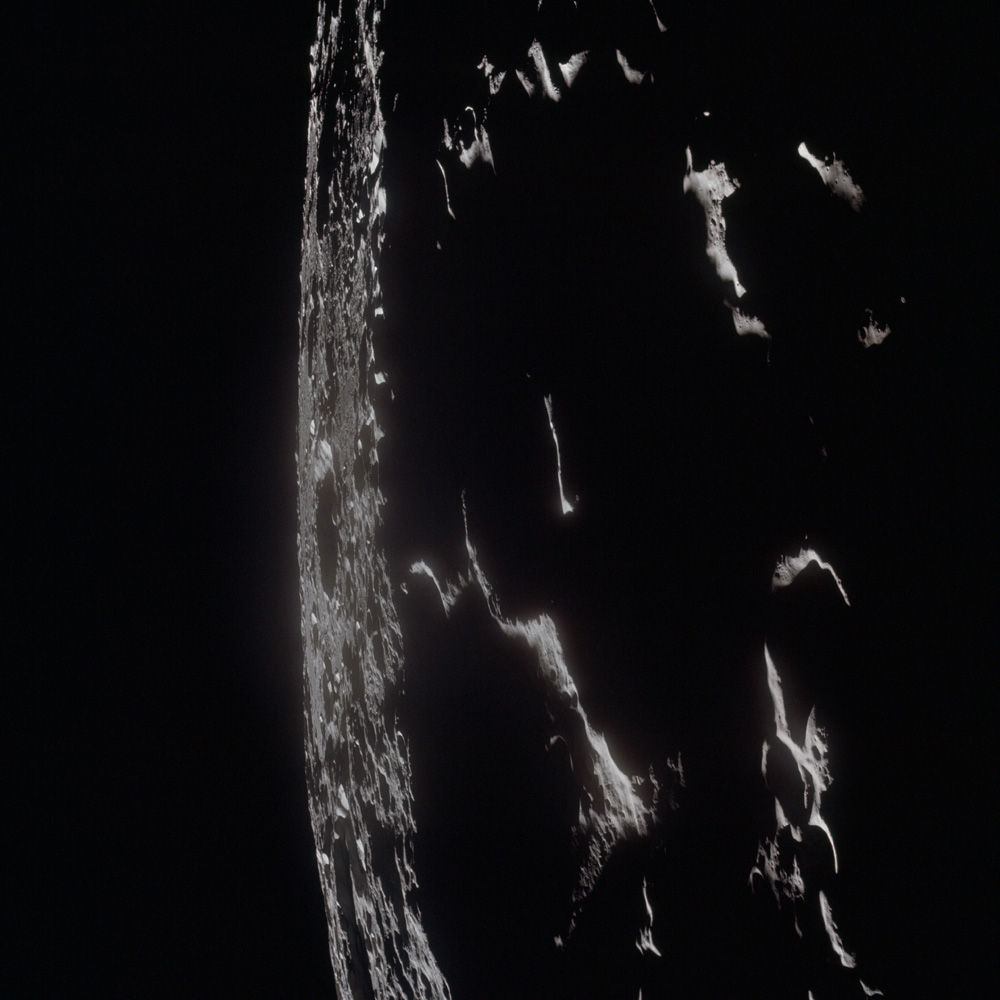
AS17-151-23106 - Crater Galois at the far side terminator - JSC scan
090:XX:XX Cernan: Couldn't see it. I can't see it.
090:XX:XX Evans: See it [garble] back over there.
090:XX:XX Cernan: Can't do it. It's gone.
090:XX:XX Evans: It is?
090:XX:XX Cernan: Gone.
090:XX:XX Evans: Terminator's gone?
090:XX:XX Cernan: I can't even see the Moon.
090:XX:XX Evans: Well, why don't you come over here and look?
090:XX:XX Cernan: Yes, [garble]...
090:XX:XX Evans: Try to see it. Here, put your...
090:XX:XX Cernan: ...okay. Oh! [Laughter.] Shoot.
090:XX:XX Evans: That's what we saw coming in, while ago.
090:XX:XX Cernan: Been snowing.
090:XX:XX Spacecraft [Cough.]
090:45:19 Cernan: Okay. We're rounded out a little bit more now...
090:45:XX Evans: Can you swing out and get - get a shot of Korolev while I go to the next one?
090:45:XX Cernan: Manischweitz! That's Korolev. That's that big ridge, Jack...
090:45:XX Schmitt: That's what it is, yes.
090:45:XX Cernan: ...that we saw coming in, only we're so much closer now. We're rounding off...
090:45:XX Schmitt: We came in from a lot higher - Korolev and on up and around.
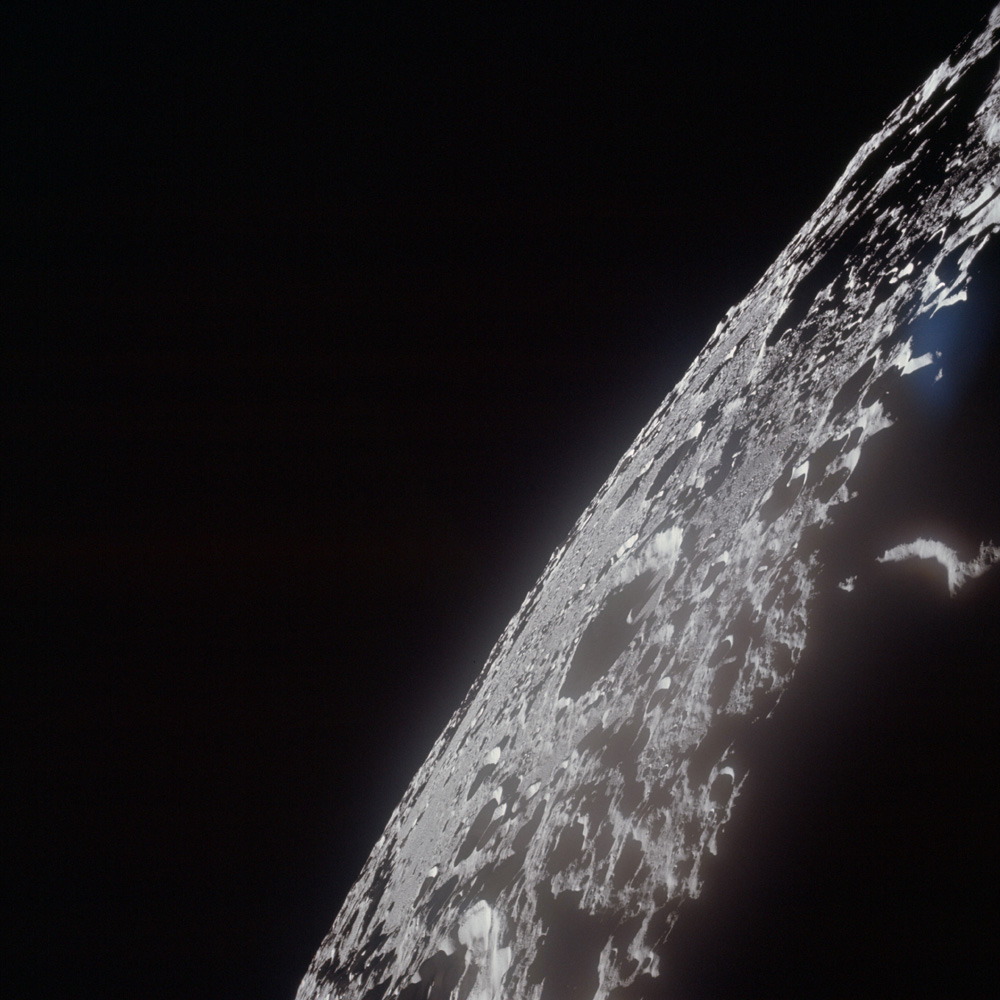
AS17-151-23107 - Crater Korolev M within the large walled basin Korolev - JSC scan
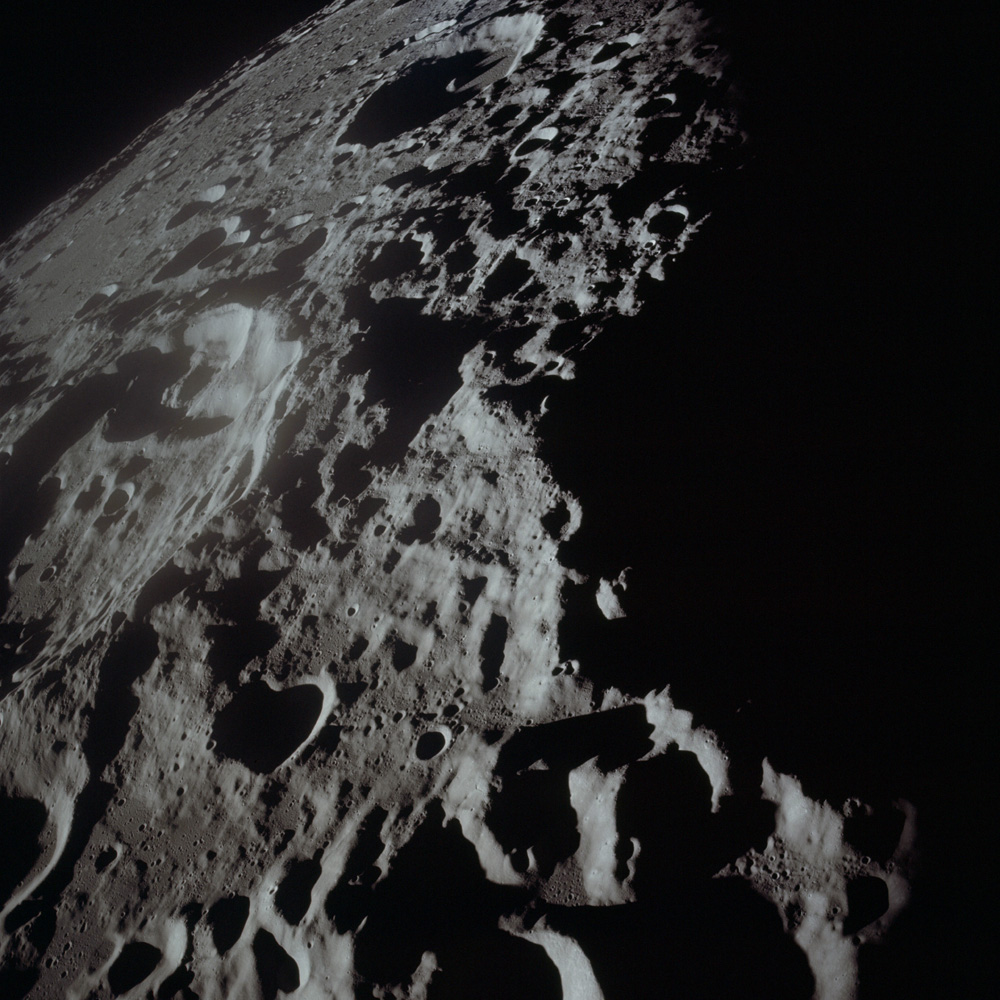
AS17-151-23108 - Crater Doppler (cut off at left) and Korolev M (top centre, within the large walled basin Korolev) - JSC scan
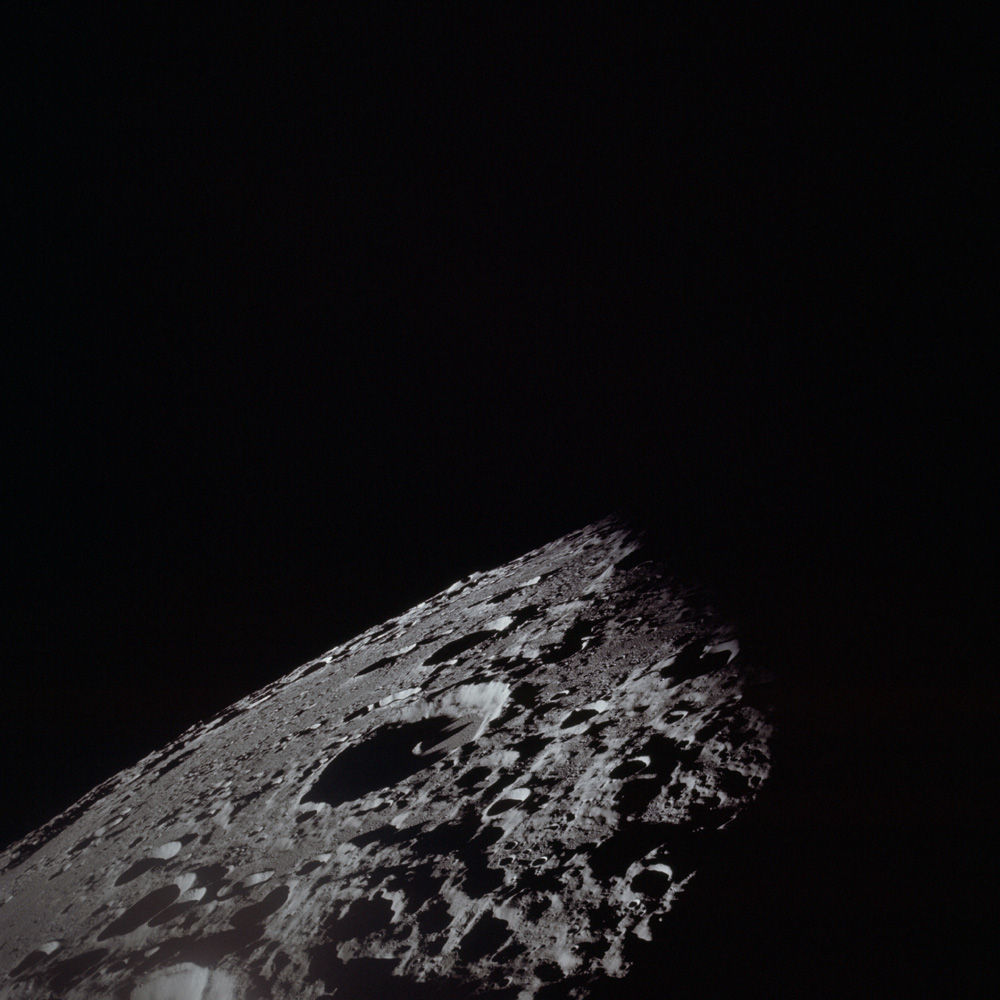
AS17-151-23109 - Crater Korolev M within the large walled basin Korolev - JSC scan
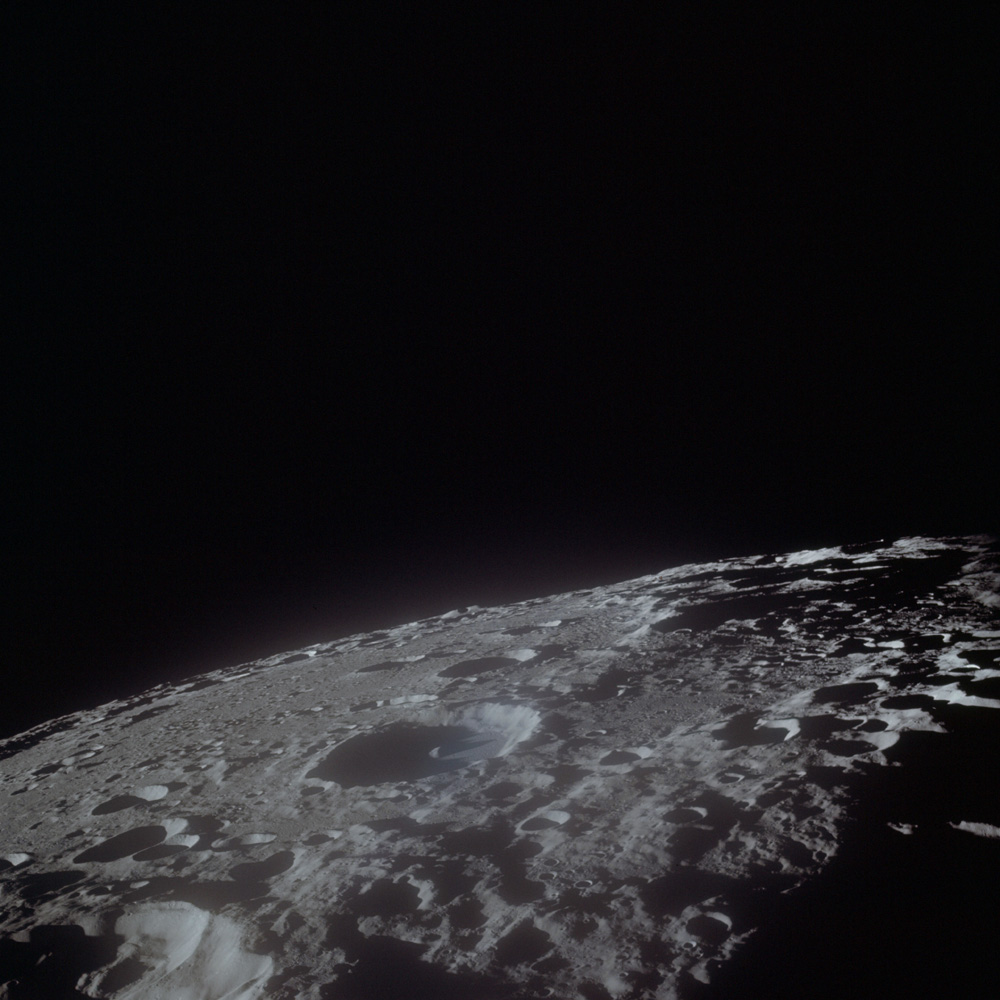
AS17-151-23110 - Crater Korolev M within the large walled basin Korolev - JSC scan
090:45:XX Cernan: Well, that's that - that's that ridge of a - Look at that thing. No wonder it looked like a central - lunar central feature, Jack.
090:45:XX Schmitt: Yes, it is. It's - it's part of a ring, but it - there's only one part of it that really sticks out.
090:45:XX Cernan: Yes. It's snowing out there.
090:45:XX Evans: It is?
090:45:XX Cernan: Yes, how else did it get white? [Garble] get started here.
090:45:53 Cernan: Okay. Let's see. We got another minute or so. Ron, yours is f/2.8 at 1/250, infinity.
090:XX:XX Evans: Okay.
090:XX:XX Cernan: Fifty-eight frames?
090:XX:XX Evans: Yes, pretty long set.
090:XX:XX Schmitt: He's going to be clicking for years.
090:XX:XX Cernan: Hey, I'll give you your changes. I'll try and give you your changes on this - Boy, I tell you - this is nothing but paperwork.
090:XX:XX Evans: Yes, this rev is going to be a good one.
090:XX:XX Cernan: Okay, Jack. You can put the Laser Altimeter, On.
090:XX:XX Schmitt: Say when. Now?
090:XX:XX Cernan: Now. Yes.
090:46:25 Schmitt: Okay. Laser Altimeter, On.
090:46:XX Cernan: Ima - Image Motion, On?
090:46:XX Cernan: Okay. Now hold off. It says at 144, I want the - I want the Mapping Camera out, but I don't know where the heck - 144, Ron, that's about - Let's see, Korolev is right on...
090:46:XX Evans: No, that's right. Just time...
090:46:XX Cernan: I'll do it on time.
090:46:XX Evans: Do it on time. Do it on time. Do it on time. Goes in there somewhere.
090:46:50 Cernan: Another 2 minutes for the Mapping Camera.
090:XX:XX Evans: Okay.
090:XX:XX Cernan: You want to start the center window, Ron?
090:XX:XX Evans: Yes.
090:XX:XX Cernan: Okay.
090:XX:XX Evans: If I can find out which...
090:XX:XX Cernan: [Cough]
090:XX:XX Evans: ...one clicks.
090:XX:XX Cernan: Which what?
090:XX:XX Evans: Okay. Let's see. That's got to be...
090:47:02 Cernan: I'll cue you on time. Oh, that's Korolev with that big central - that ridge. It's really a - I don't think you can quite see Korolev yet.
090:47:XX Evans: Can you?
090:47:XX Cernan: Oh, yes, I think so. That's the same one I was seeing coming in, I'm pretty sure.
090:47:XX Evans: That's Korolev with the big ridge going down through there.
090:47:XX Cernan: Yes. Yes.
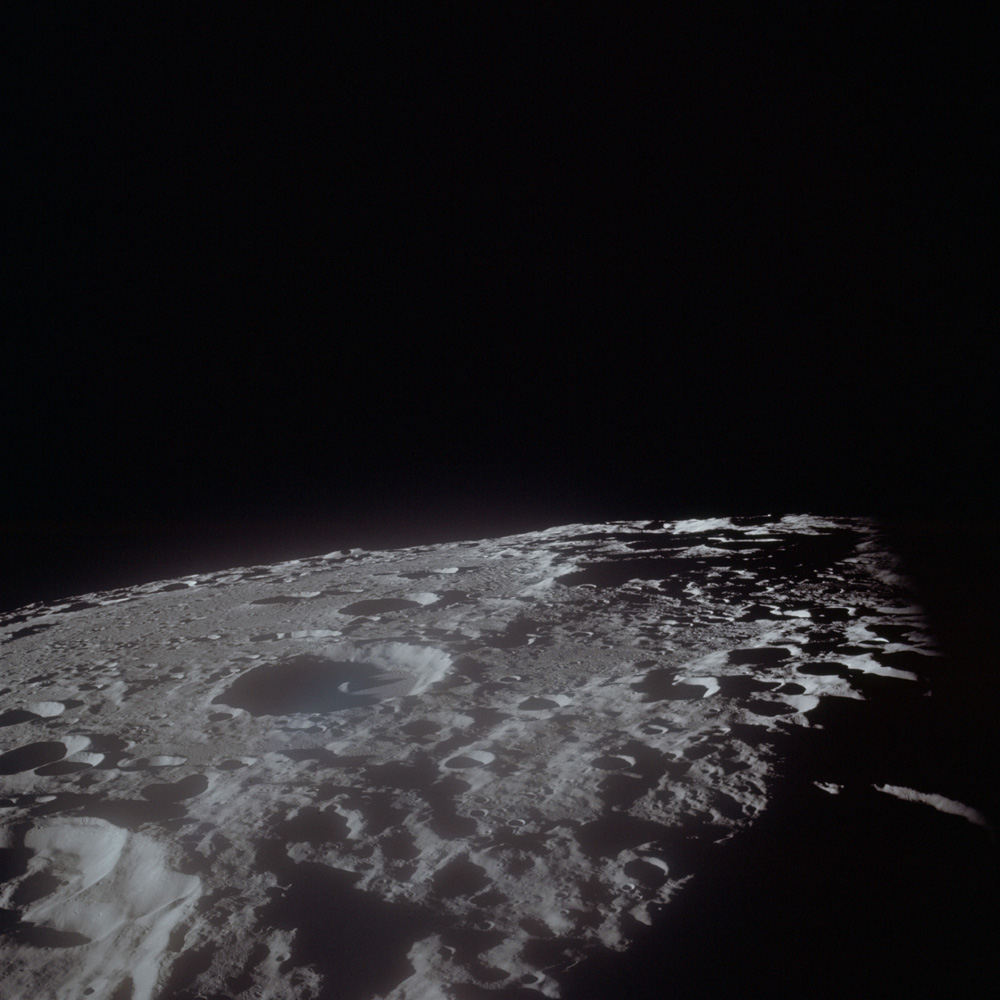
AS17-151-23111 - Crater Doppler (cut off at bottom left) and Korolev M (lower left of centre, within the large walled basin Korolev) - JSC scan
090:47:XX Evans: Okay. Galois is supposed to have a central peak in the thing. Korolev is right on the terminator now.
090:47:XX Cernan: Okay, Jack. You can put the Mapping Camera, On.
090:47:XX Schmitt: [Garble]. No, I think your Korolev - No, I think it's - it's - I don't think you can see it quite yet.
090:47:39 Evans: Mapping Camera, On.
090:47:XX Cernan: Yes, let's just verify all these.
090:47:XX Evans: Yes, sir.
090:47:XX Cernan: Pan Camera is Standby, Stereo, Power.
090:47:XX Cernan: V/H, High Altitude.
090:47:47 Evans: Yes. Laser...
090:47:XX Cernan: Laser Altimeter, On.
090:47:49 Evans: Yes.
090:47:XX Cernan: Image Motion, On.
090:47:XX Cernan: You got the Mapping Camera, On?
090:47:54 Evans: Okay, it's On now.
090:XX:XX Cernan: Okay. And that's at - that's at 47.50. Okay. And Pan Camera, on 1 in 1 minute - no, about 2½ minutes.
090:XX:XX Evans: Okay.
090:XX:XX Cernan: Gosh darn. Son of a gun. Pardon my French.
090:XX:XX Cernan: Actually, I'm looking south now, aren't I?
090:XX:XX Evans: Yes.
090:XX:XX Evans: [Garble] next one here.
090:XX:XX Cernan: Yes, okay. South. I've got it. Mare B, or something.
090:XX:XX Evans: Yes. Okay. That's Crookes right down there at the bottom.
090:XX:XX Cernan: What do I have written in the margin that's for this time here?
090:XX:XX Schmitt: Korolev and Apollo, and then the highlands.
090:XX:XX Cernan: Okay.
090:49:21 Cernan: Okay. We've got about a minute to go for the Pan Camera.
090:49:XX Evans: Okay.
090:49:XX Cernan: About a minute to go.
090:49:XX Evans: Standing by.
090:49:XX Cernan: And then after that, you want to Increase the Image Motion, barber pole plus four steps, and then On.
090:49:XX Evans: Okay. Will do. Image Motion, On, you mean?
090:49:XX Cernan: No, you've already got the Image Motion, On.
090:49:XX Evans: Okay, but the camera.
090:49:42 Cernan: I'll give you a Pan Camera start here. I don't know...
090:XX:XX Evans: Okay. What was that last On on?
090:XX:XX Cernan: And then after that, it'll be the Image Motion, Increase, barber pole plus four steps/On.
090:XX:XX Evans: Okay. Okay. I got it. [Garble] spring loaded. [Garble]. No, Korolev is way on up there yet.
090:XX:XX Cernan: Yes, I think so.
090:XX:XX Evans: Yes, okay. [Garble]. That's Galois then, right down here. Three little craters right...
090:XX:XX Cernan: Watch your clock, Ron. Okay, Jack; 10 seconds for the Pan Camera.
090:XX:XX Schmitt: Okay.
090:XX:XX Cernan: 2, 1 - Mark. Operate.
090:50:33 Schmitt: Operate.
090:50:XX Cernan: Okay. Image Motion, Increase, barber pole...
090:50:XX Schmitt: Okay.
090:50:XX Cernan: ...plus four steps, and then On.
090:50:47 Schmitt: Okay. Barber pole. 1, 2, 3, 4.
090:XX:XX Cernan: Okay, Ron. You're still in f/2.8. Right?
090:XX:XX Evans: f/2.8. Yes, and I'm...
090:XX:XX Cernan: Okay. I'll try and give you a mark on time when you should be hitting - coming up on Doppler.
090:XX:XX Evans: Yes, we all got a window now. Figure out where I am. Let's see, I don't know which one - which is easier.
090:51:22 Cernan: This is Doppler right here in front of you.
090:51:XX Evans: Doppler, right there, hull? Right here in front of me.
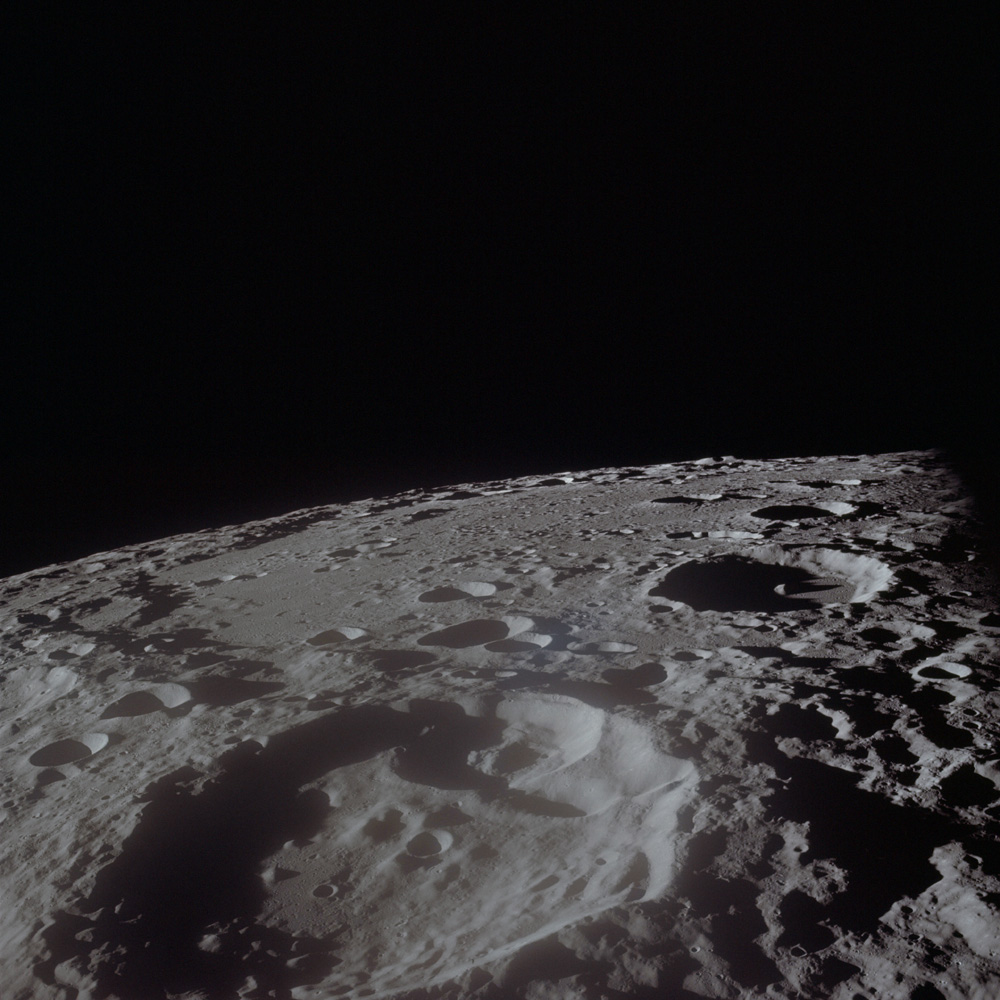
AS17-151-23112 - Crater Doppler (foreground) and Korolev M (right, within the large walled basin Korolev) - JSC scan
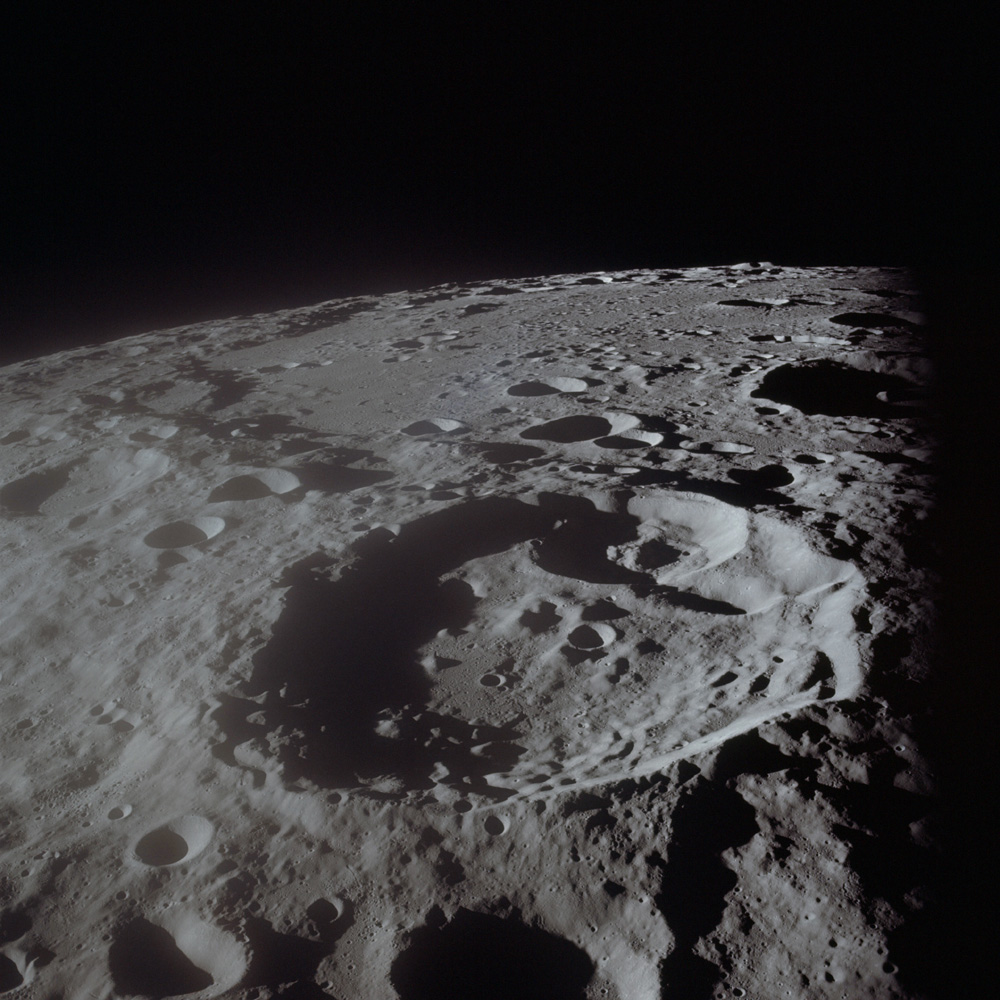
AS17-151-23113 - Crater Doppler (foreground) and Korolev M (right, within the large walled basin Korolev) - JSC scan
090:51:XX Cernan: Yes, I'm looking right at it. That's Doppler. Yes, sir. Before you - you understand f/2.8 - when you come up on it, you want to go to f/4. That should be about another minutes and a half. Yes, this is Dopp - you looking at the same thing I am?
090:51:XX Evans: [Garble]. That's Doppler right there?
090:51:XX Cernan: Yes, it's at the - the - the two craters on the right-hand side over there.
090:51:XX Evans: Yes. Okay.
090:51:55 Cernan: Okay, just before you get to it, there's a little crater. See this little crater at the left of it here at - as you look at it, at 7 o'clock?
090:XX:XX Evans: Yes.
090:XX:XX Cernan: Well, that's the crater he's got marked to come up on f-point - f/4.
090:XX:XX Evans: f/4. Okay.
090:XX:XX Schmitt: What am I...
090:XX:XX Cernan: Pardon?
090:XX:XX Schmitt: Can you give me a fix on what's south?
090:XX:XX Cernan: What is south? Okay. Maybe it's on this. Here, I'll use this. Not a heck of a lot, Jack. Looking up to the left, you ought to have...
090:XX:XX Schmitt: No, I just need a...
090:XX:XX Cernan: ...Sniadeck; and Mohorovicic - vici - Mohoro-vicic. They ought to be coming up, Ra - De Vries - McKellar, De Vries, and Racah.
090:52:37 Cernan: Okay, Ron. You ought to be about f/4, I'd say.
090:XX:XX Evans: Okay.
090:XX:XX Cernan: And the time looks good.
090:XX:XX Evans: Time looks good. Okay.
090:XX:XX Cernan: And about a couple of minutes - Is that thing clicking for you?
090:XX:XX Evans: Yes, okay. Yes.
090:XX:XX Cernan: Look at that rille running right up towards Crookes, I guess, huh?
090:XX:XX Evans: Yes, it's going right up towards Crookes.
090:XX:XX Cernan: Yes. Crookes has got that little breached side. See it right over here?
090:XX:XX Evans: Yes.
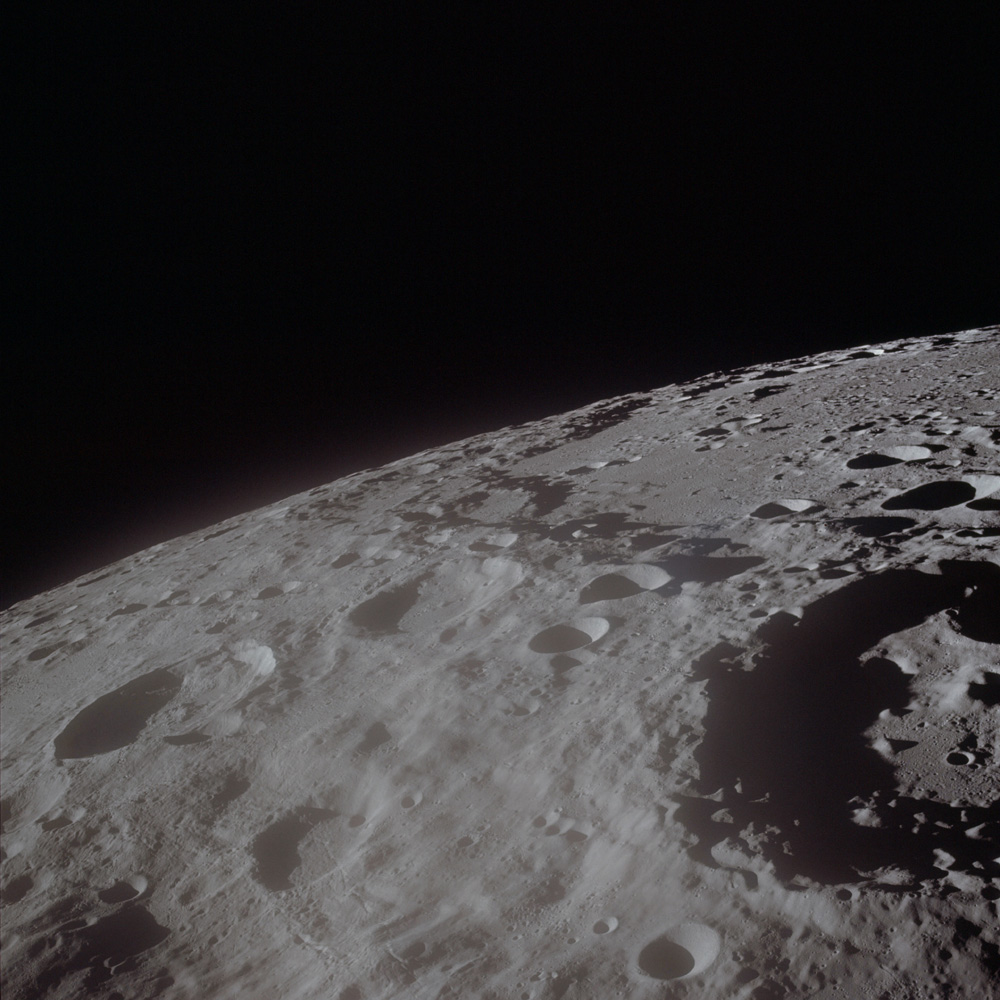
AS17-151-23114 - Craters Crookes (left) and Doppler (cut off on right). The western half of the large walled basin Korolev is beyond on the right) - JSC scan
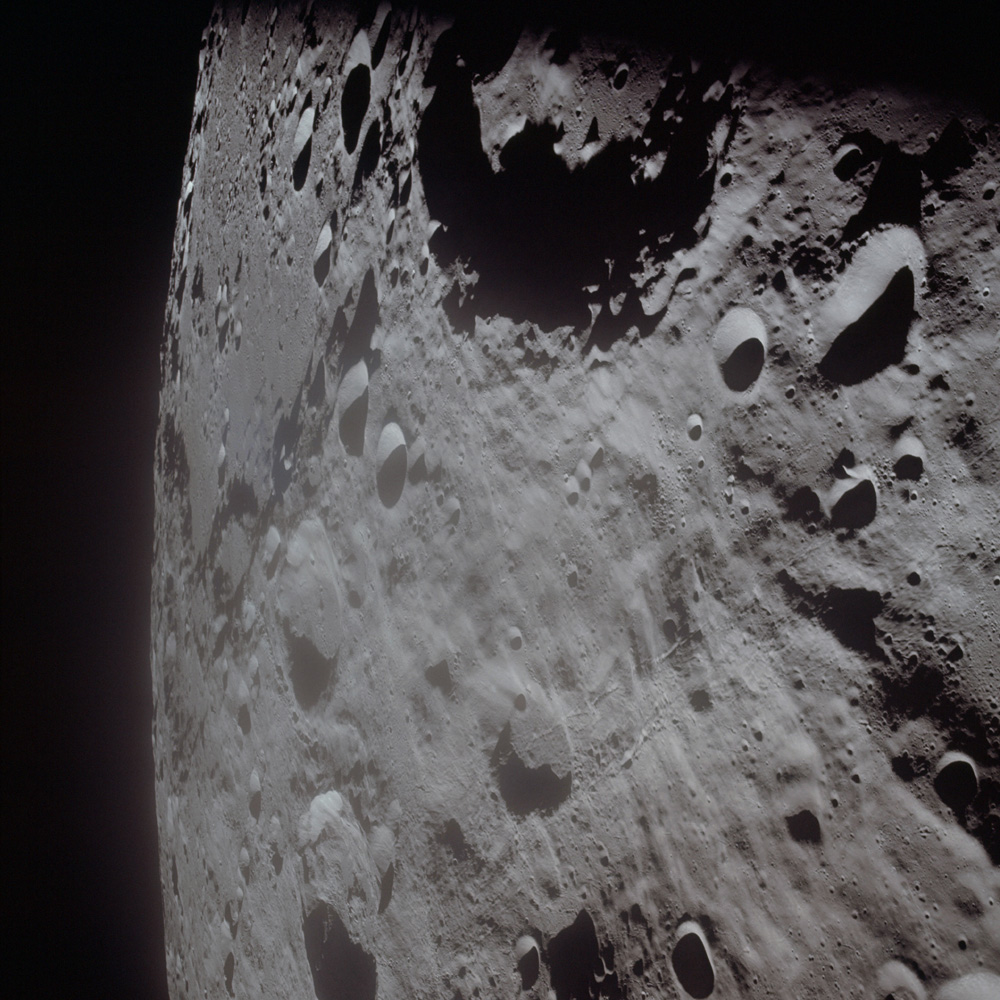
AS17-151-23115 - Craters Crookes (cut off bottom left) and Doppler (cut off top of frame). The western half of the large walled basin Korolev is beyond on the upper left) - JSC scan
090:XX:XX Cernan: Look at the steepness of the sides of that crater! From here, they - on the far side, the shadowed side, they look like 60 or 70 degrees.
090:XX:XX Evans: Oh, that son of a gun.
090:XX:XX Cernan: Just yell when you need to get over here, Ron.
090:XX:XX Evans: Okay.
090:XX:XX Cernan: Okay. It still calls for you to be at this window, Ron. Jack, at about 90 - at about 58, we want to put V/H to Low.
090:XX:XX Schmitt: 58.
090:XX:XX Cernan: Yes.
090:53:34 Schmitt: Okay, 5 minutes.
090:XX:XX Evans: What? Do we change at Crookes?
090:XX:XX Cernan: Keep going until you pass Crookes.
090:XX:XX Evans: Past Crookes and then 560.
090:XX:XX Cernan: Yes, you're looking at Crookes, aren't you?
090:XX:XX Evans: Yes.
090:XX:XX Cernan: The one with the breached crater on this side?
090:XX:XX Evans: Yes. It's got a breached crater on the side of it?
090:XX:XX Cernan: Yes.
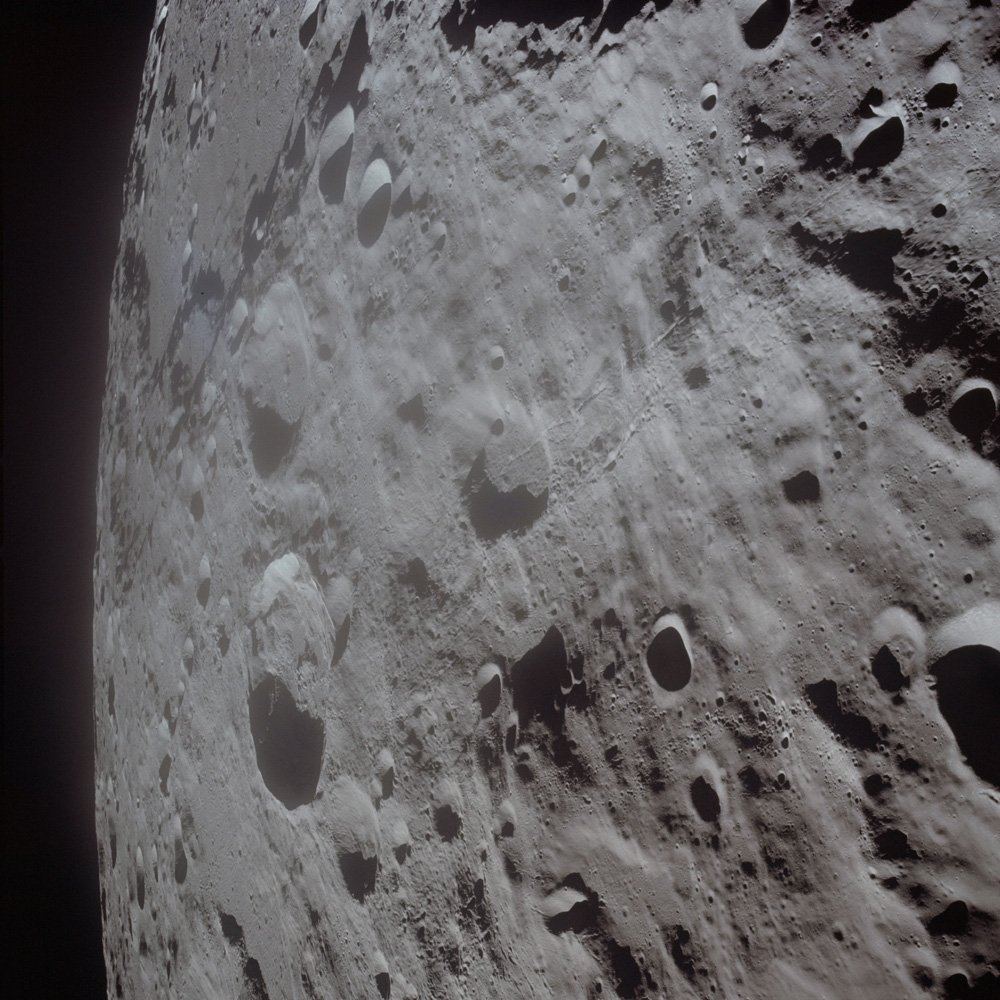
AS17-151-23116 - Crater Crookes (lower left). The western half of the large walled basin Korolev is upper left - JSC scan
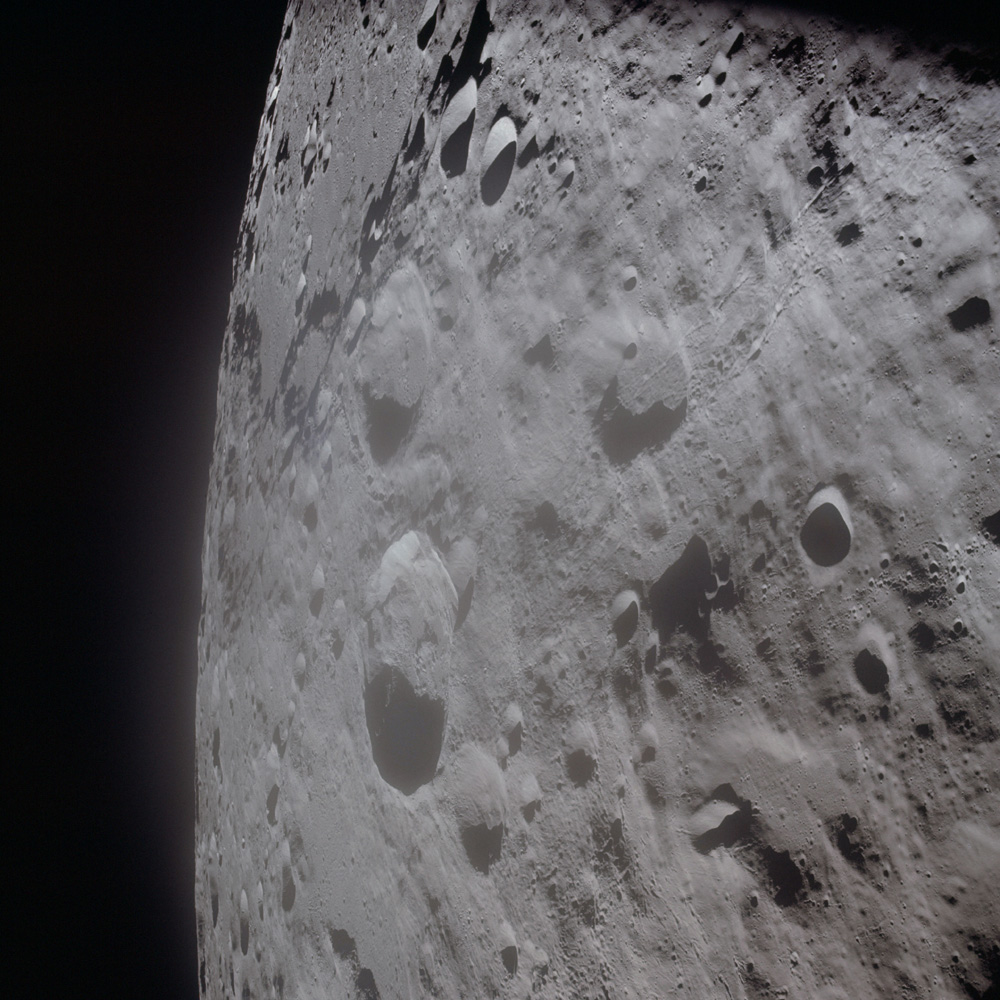
AS17-151-23117 - Crater Crookes (lower left). The western half of the large walled basin Korolev is upper left - JSC scan
090:XX:XX Evans: Looks like somebody's walked up to it. An alligator.
090:XX:XX Cernan: Yes. Right over all those other craters?
090:XX:XX Evans: Yes, walked right over all those other craters, and...
090:XX:XX Schmitt: Boy, I'll tell you, they - some slopes on that thing really look steep.
090:54:01 Cernan: Jack, on your side, you ought to have McKellar coming up there in the foreground a ways. It's - it's pretty subtle on that side, isn't it?
090:54:XX Schmitt: Yes, but I tell you, there's fill in these craters. They're so smooth, I can't believe it.
090:54:XX Cernan: It really is smooth.
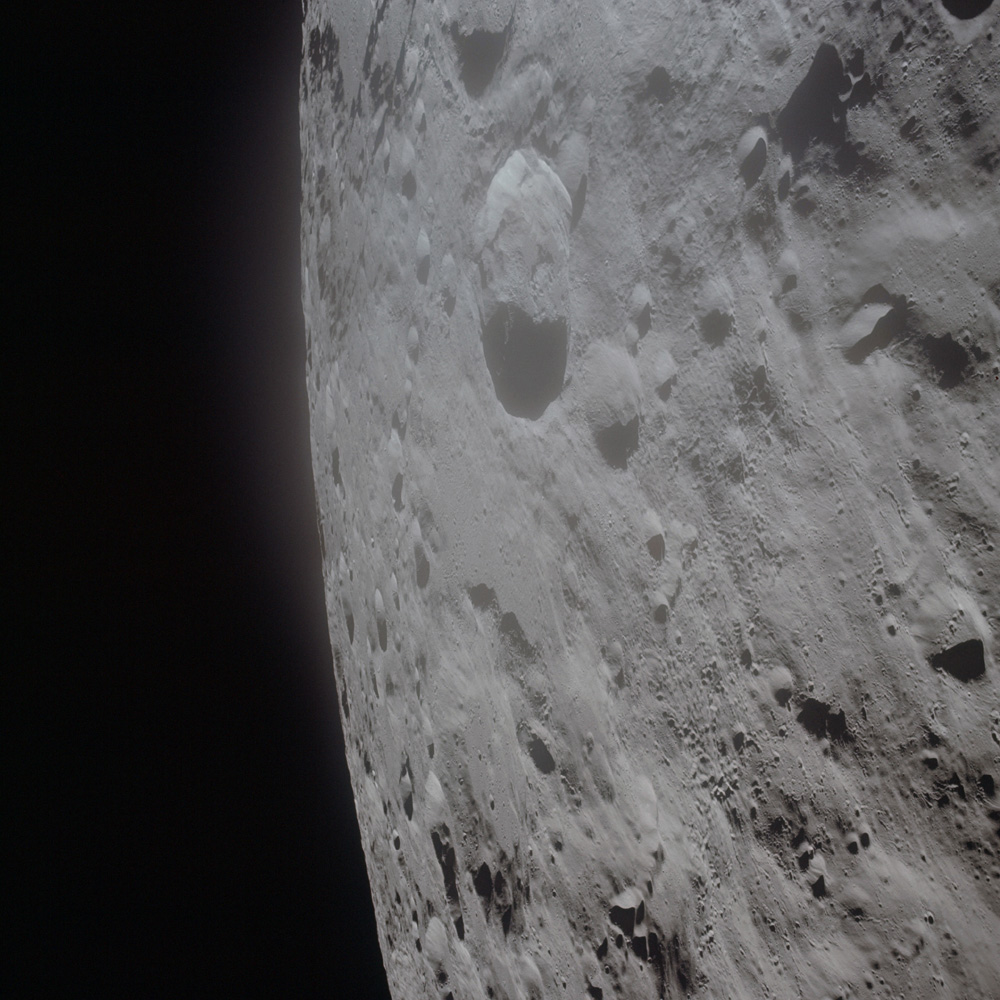
AS17-151-23118 - Crater Crookes (upper centre) - JSC scan
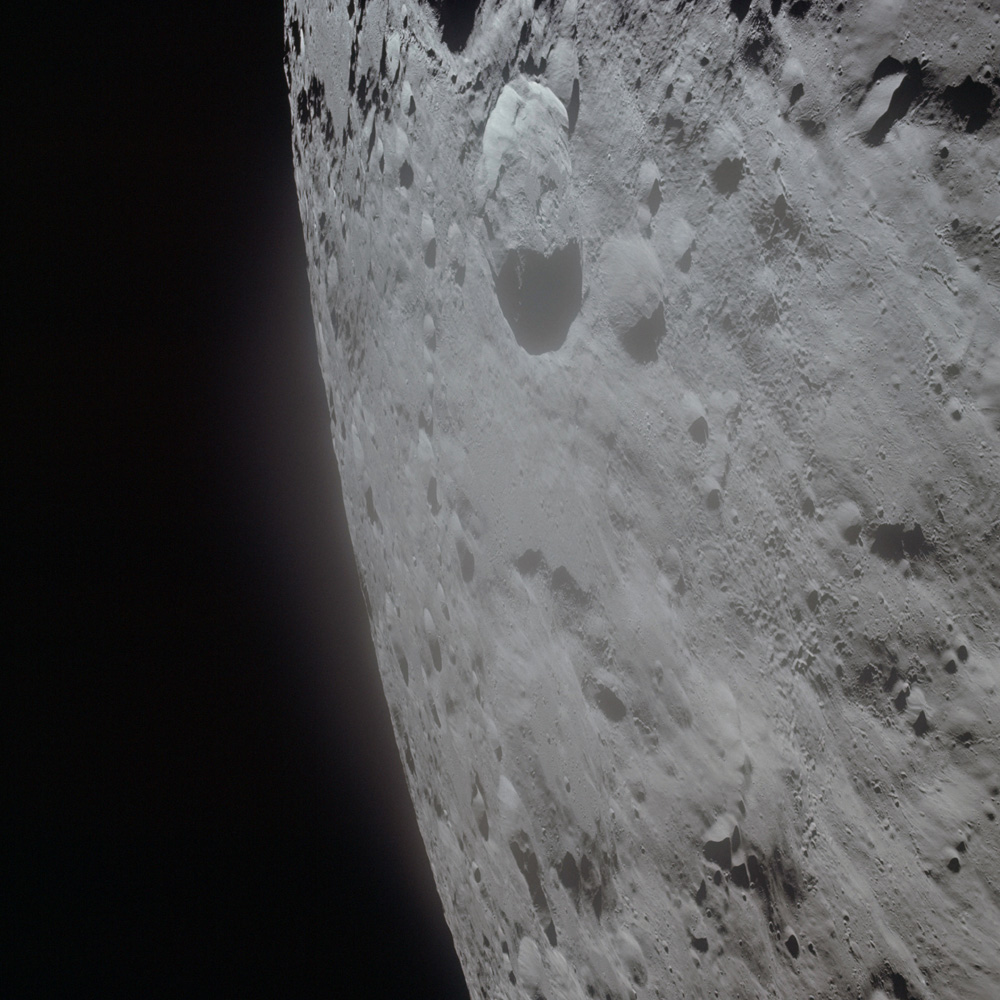
AS17-151-23119 - Crater Crookes (upper centre) - JSC scan
090:54:XX Schmitt: And then there's some that - slight wavy and rough, too. Got some of these (cough) have the...
090:54:XX Cernan: Okay, Ron...
090:54:XX Schmitt: ...whorls...
090:54:XX Cernan: ...at about - What time is it?
090:54:XX Schmitt: ...over here, window 5, that...
090:54:XX Evans: Oh, it's 54.
090:54:XX Schmitt: ...[garble] indications of craters...
090:54:43 Cernan: ...Okay, just as you go past Crookes, you can go to 5.6.
090:XX:XX Schmitt: ...no indications of relief. And they cross...
090:XX:XX Evans: Okay.
090:XX:XX Schmitt: ...crater borders, although generally the ones I - well, not - generally they're in the plains...
090:XX:XX Evans: Excuse me. I [garble] here.
090:XX:XX Schmitt: ...material. Smooth plains.
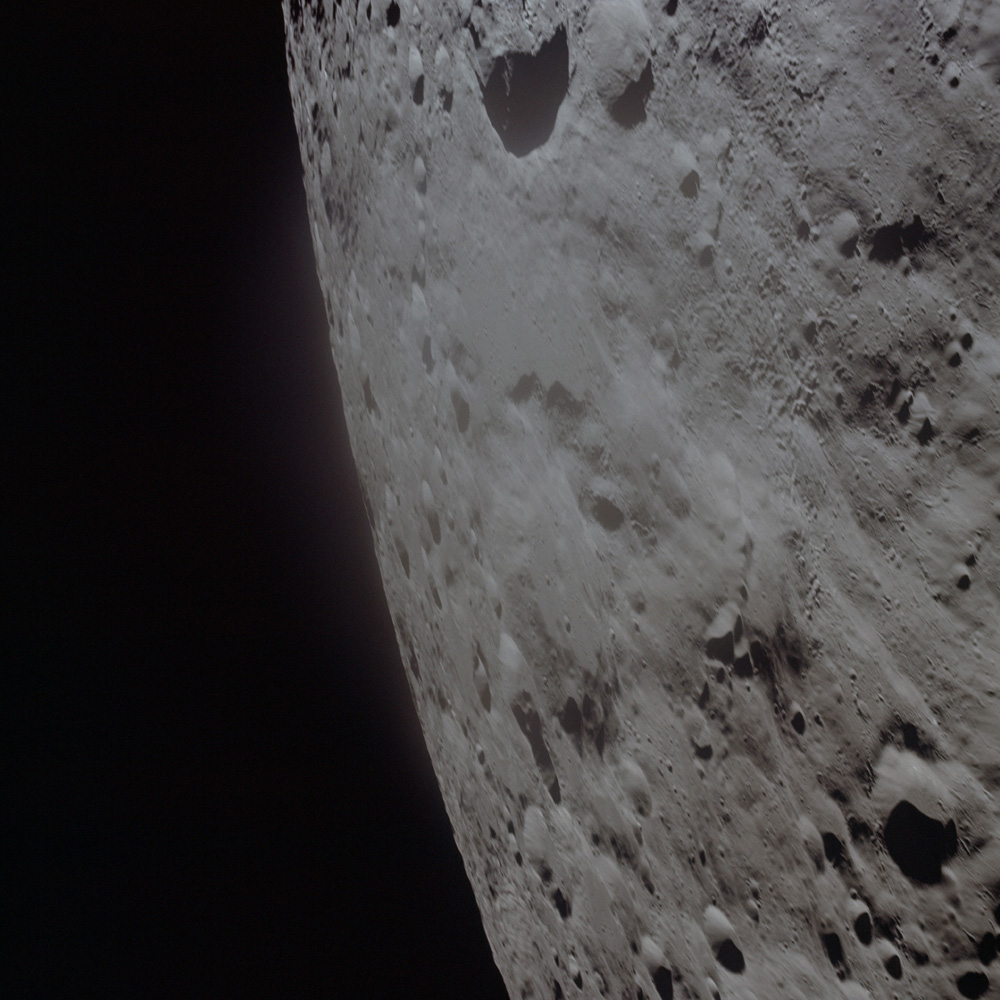
AS17-151-23120 - Crater Crookes (cut off at top). Note distinctive pockmarking of surface in the foreground. This is due to the impact of ejecta from nearby crater formation - JSC scan
090:XX:XX Cernan: Looks like there've been a lot of one-legged chickens running around, all in the same direction.
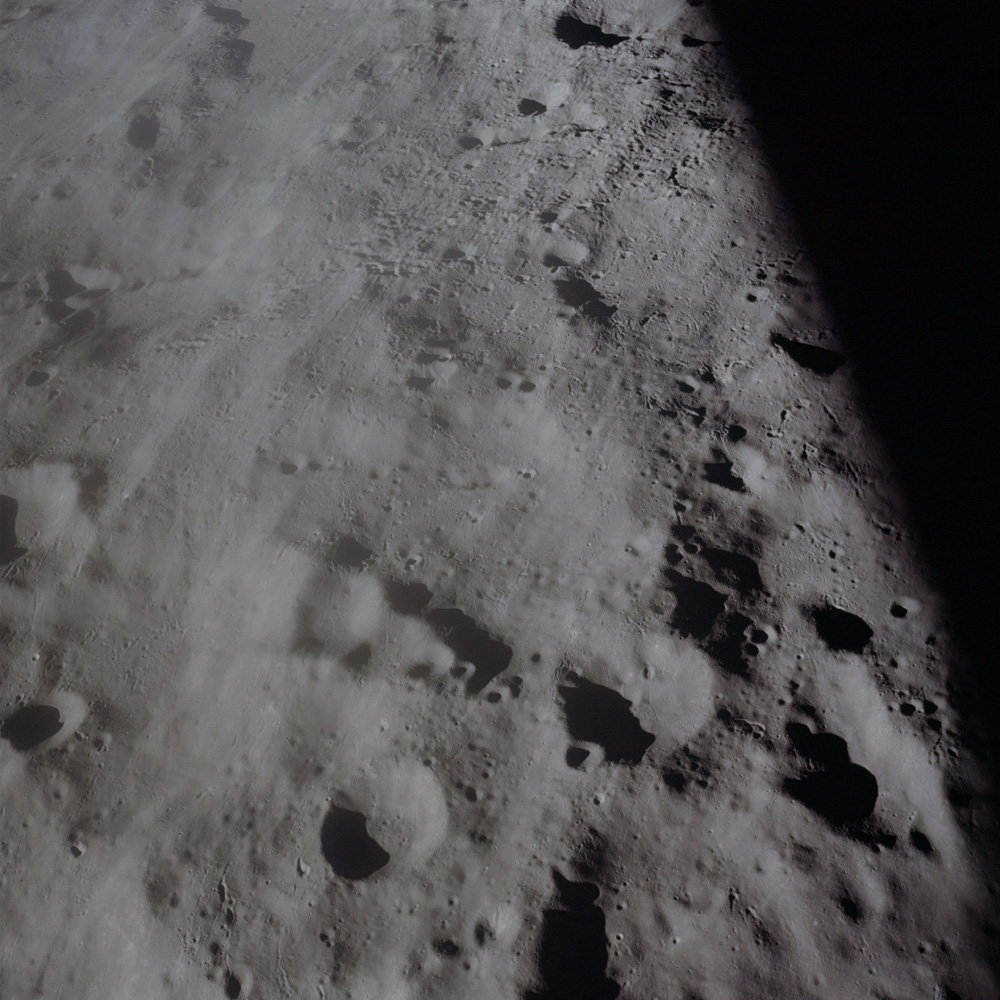
AS17-151-23121 - Distinctive pockmarking of surface due to the impact of ejecta from nearby crater formation. This is often forms staggered lines of depressions that are reminiscent of bird footprints - JSC scan
090:XX:XX Schmitt: Locally, some of the depressions are extremely smooth...
090:55:11 Cernan: Ron, you want to hold 5 - 5.6 now...
090:XX:XX Schmitt: ...light plains material.
090:XX:XX Evans: Yes.
090:XX:XX Cernan: ...and you want to go to number 4, window number 4.
090:XX:XX Evans: Window number 4?
090:XX:XX Cernan: Yes.
090:XX:XX Schmitt: Okay, here's one that looks like that hummocky material that's spilled over into another crater...
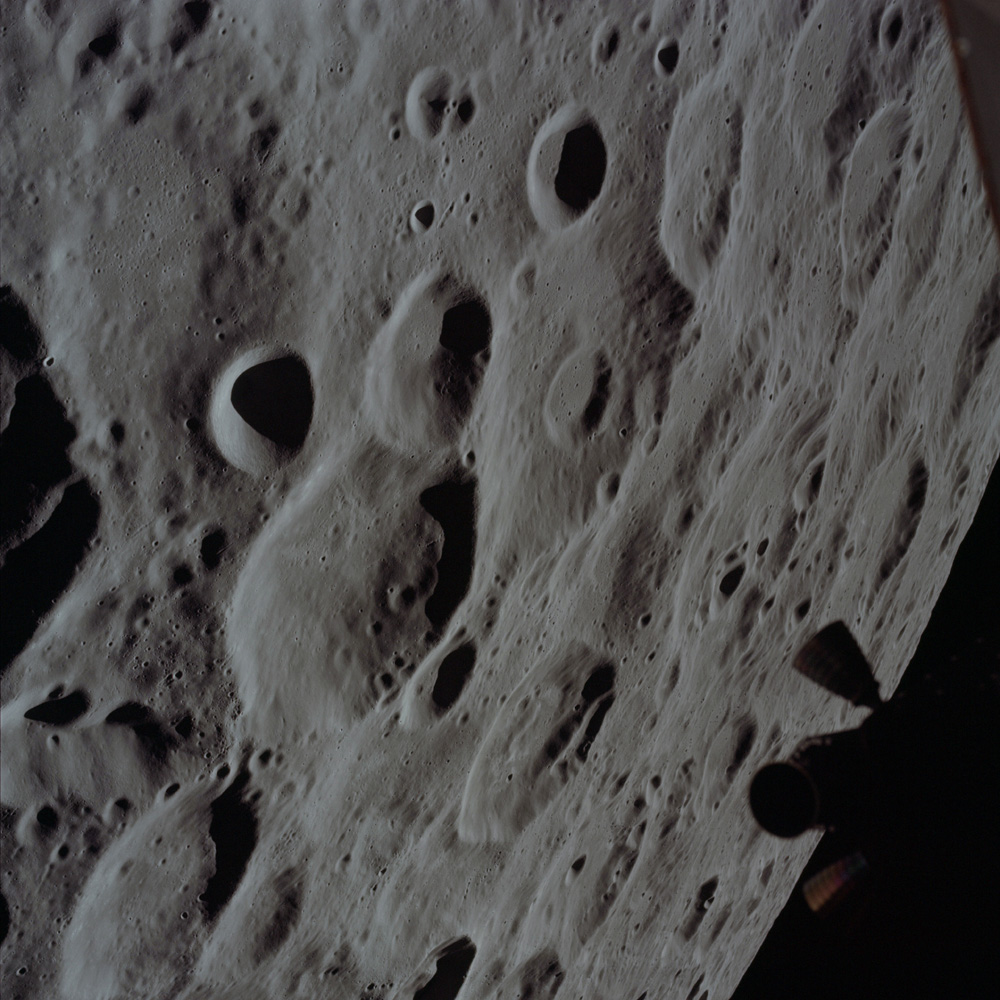
AS17-151-23122 - View west from above crater McKellar which is cut off on the left just showing its west wall - JSC scan
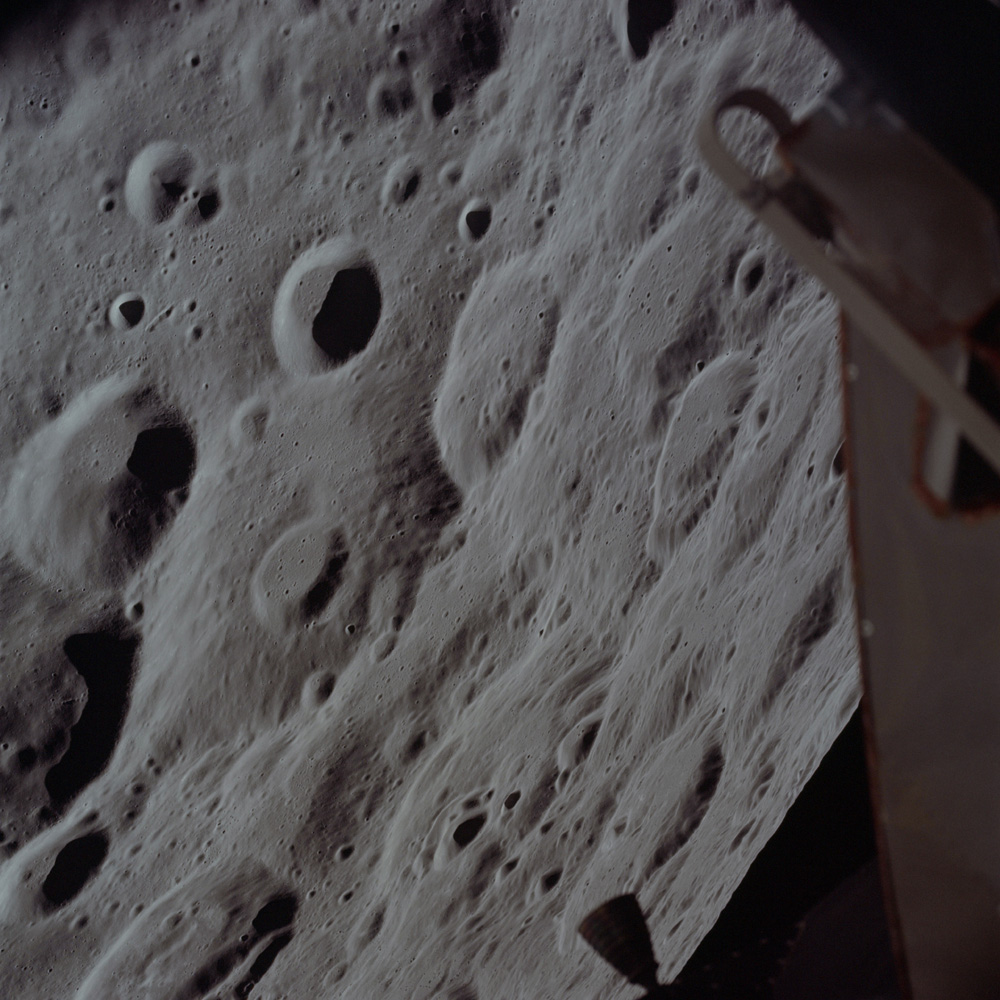
AS17-151-23123 - Terrain west of McKellar. Crater Racah is lower right behind thruster - JSC scan
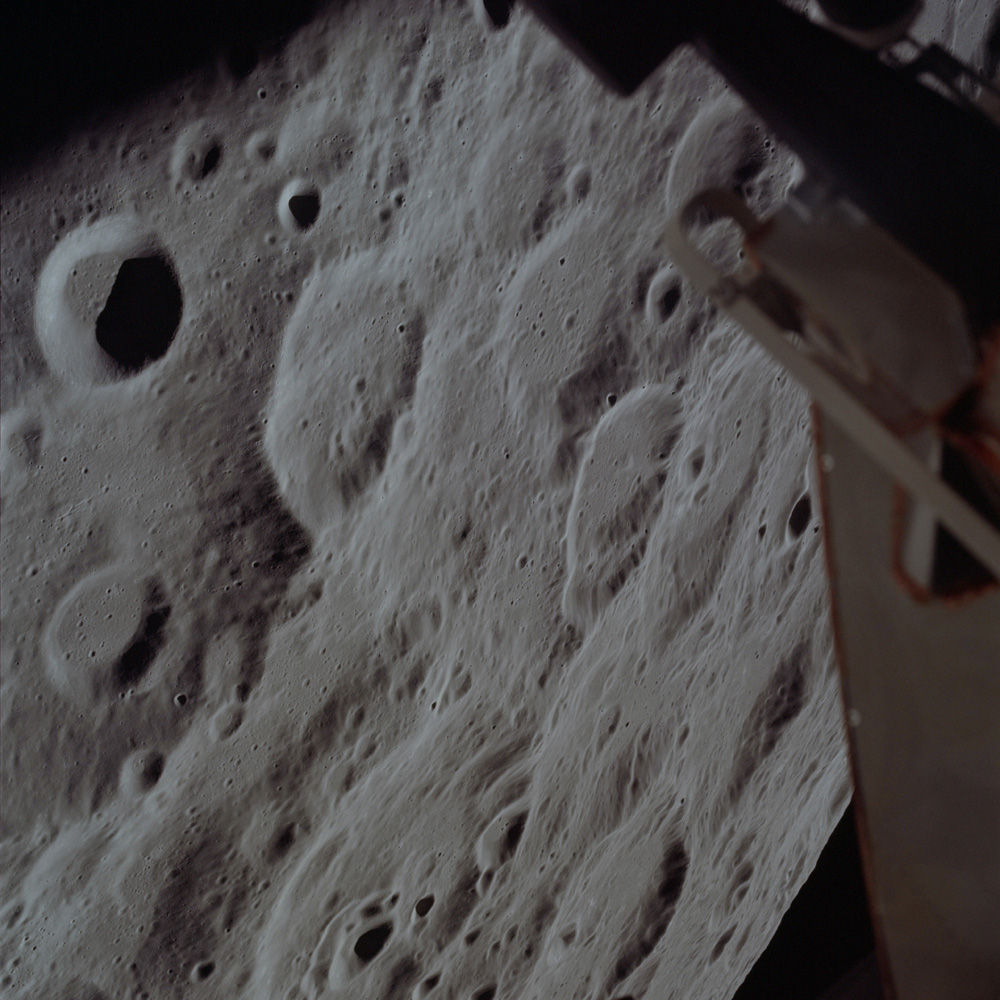
AS17-151-23124 - Terrain west of McKellar. Crater Racah is lower right - JSC scan
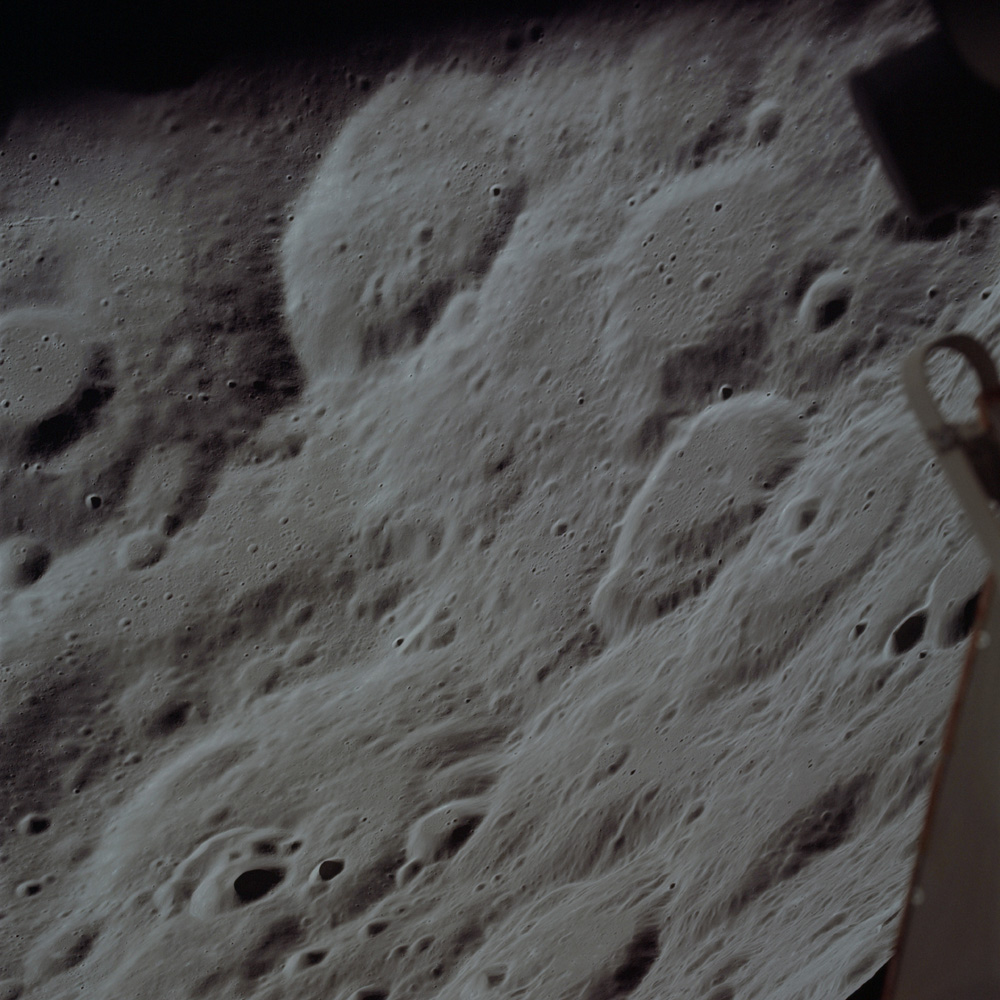
AS17-151-23125 - Terrain west of McKellar. Crater Racah is cut off bottom centre - JSC scan
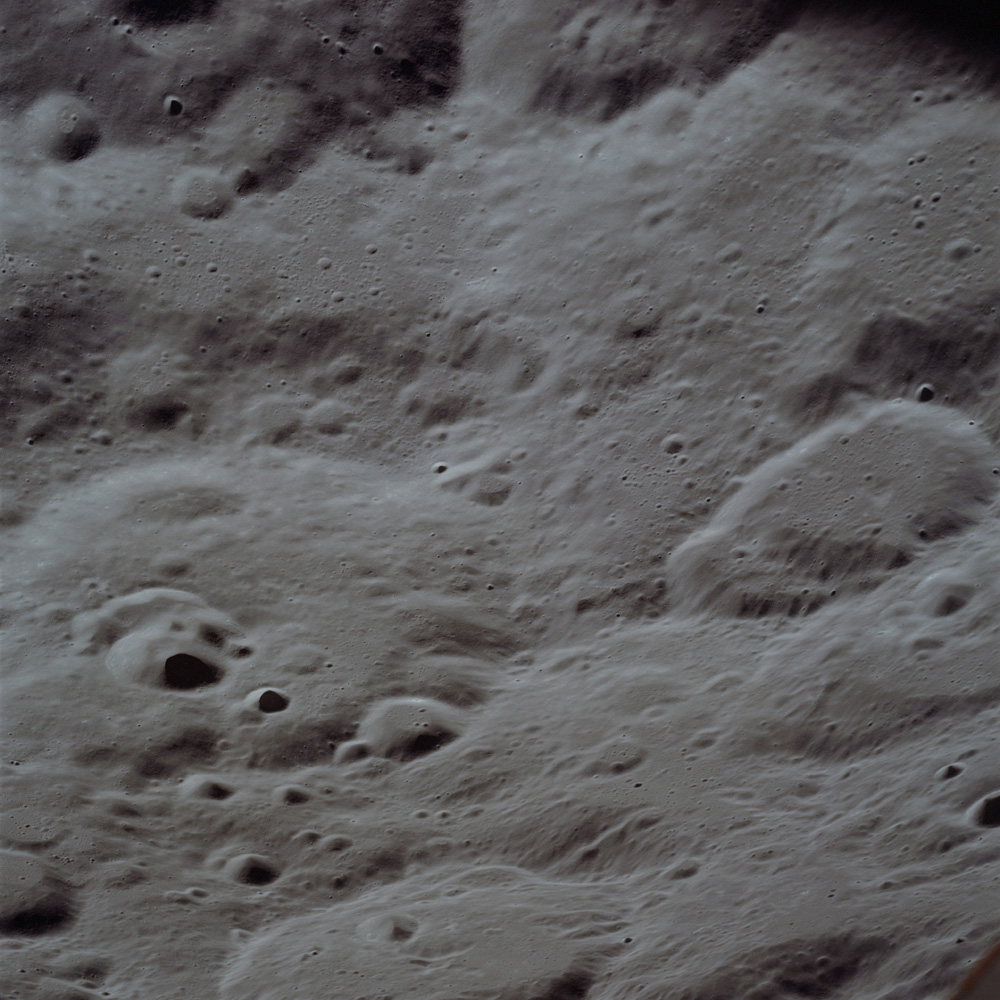
AS17-151-23126 - Crater Racah is cut off bottom centre - JSC scan
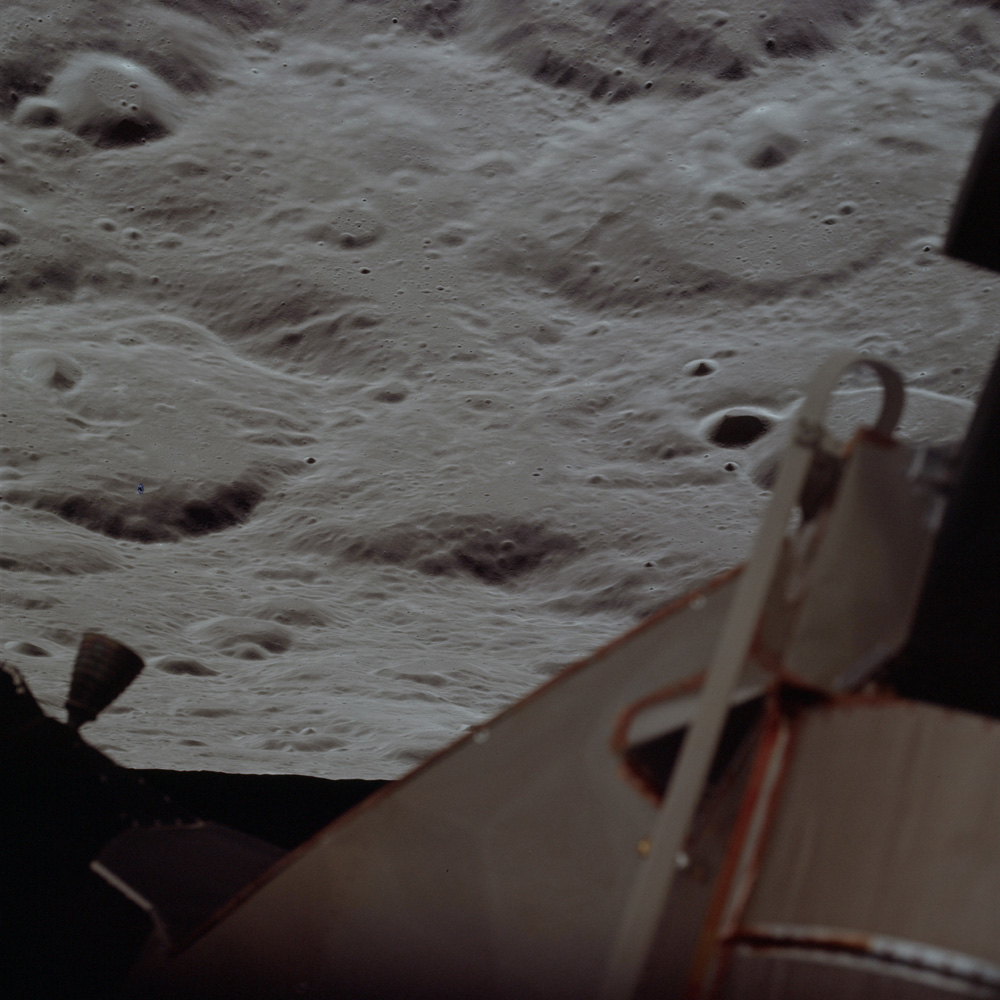
AS17-151-23127 - Crater Racah is cut off centre left - JSC scan
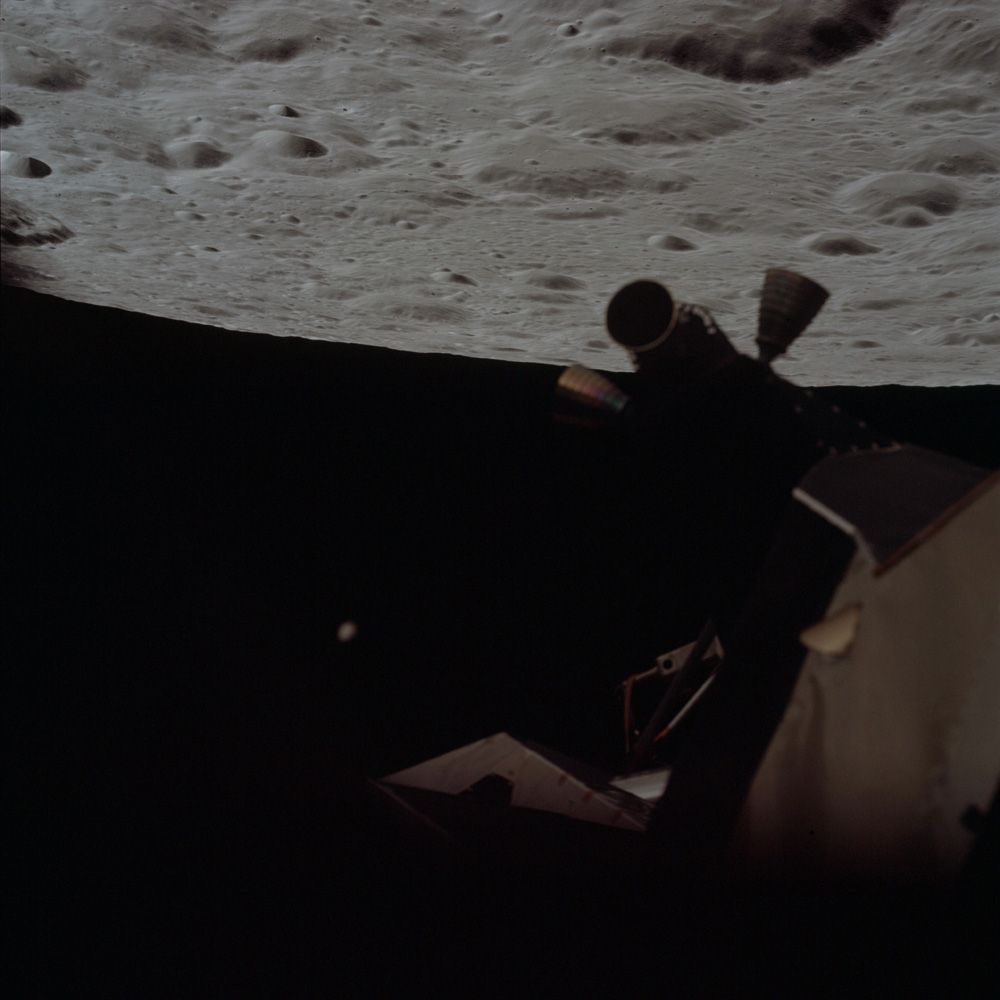
AS17-151-23128 - View northwest. Crater Racah is cut off top right - JSC scan
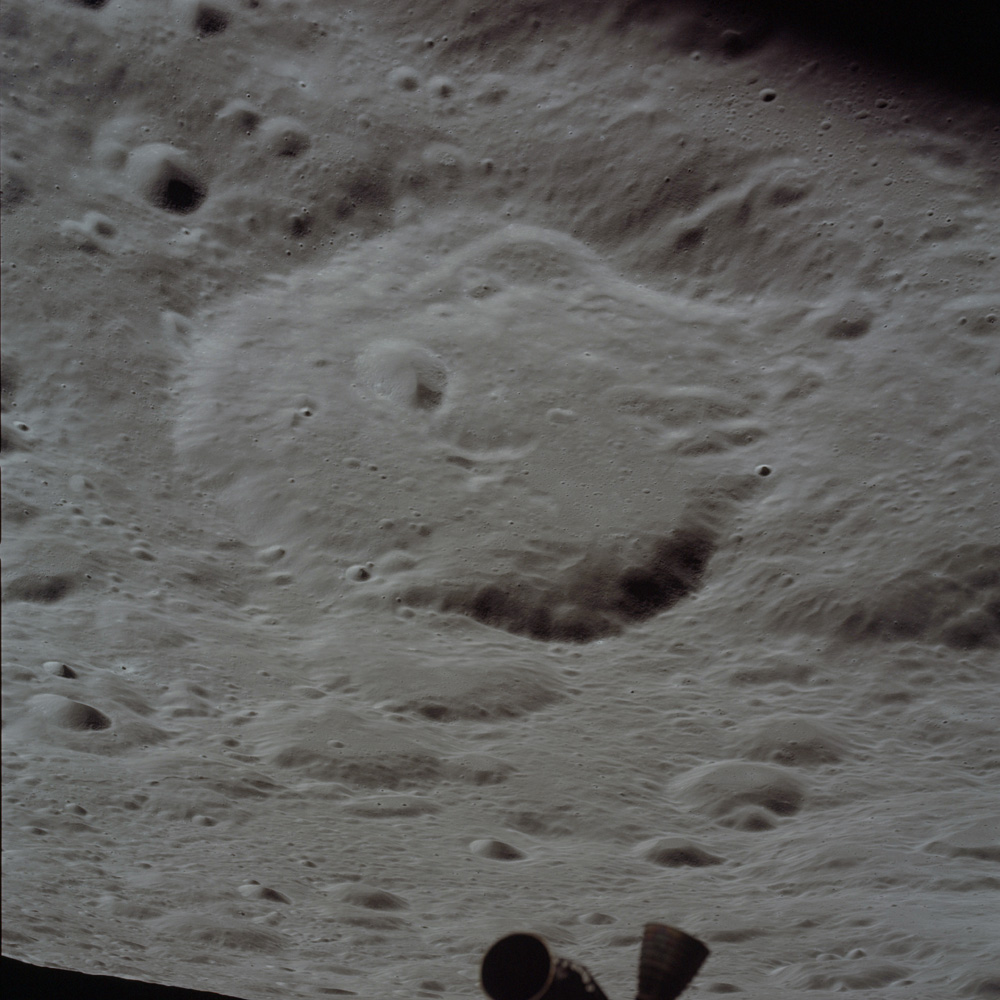
AS17-151-23129 - Crater Racah - JSC scan
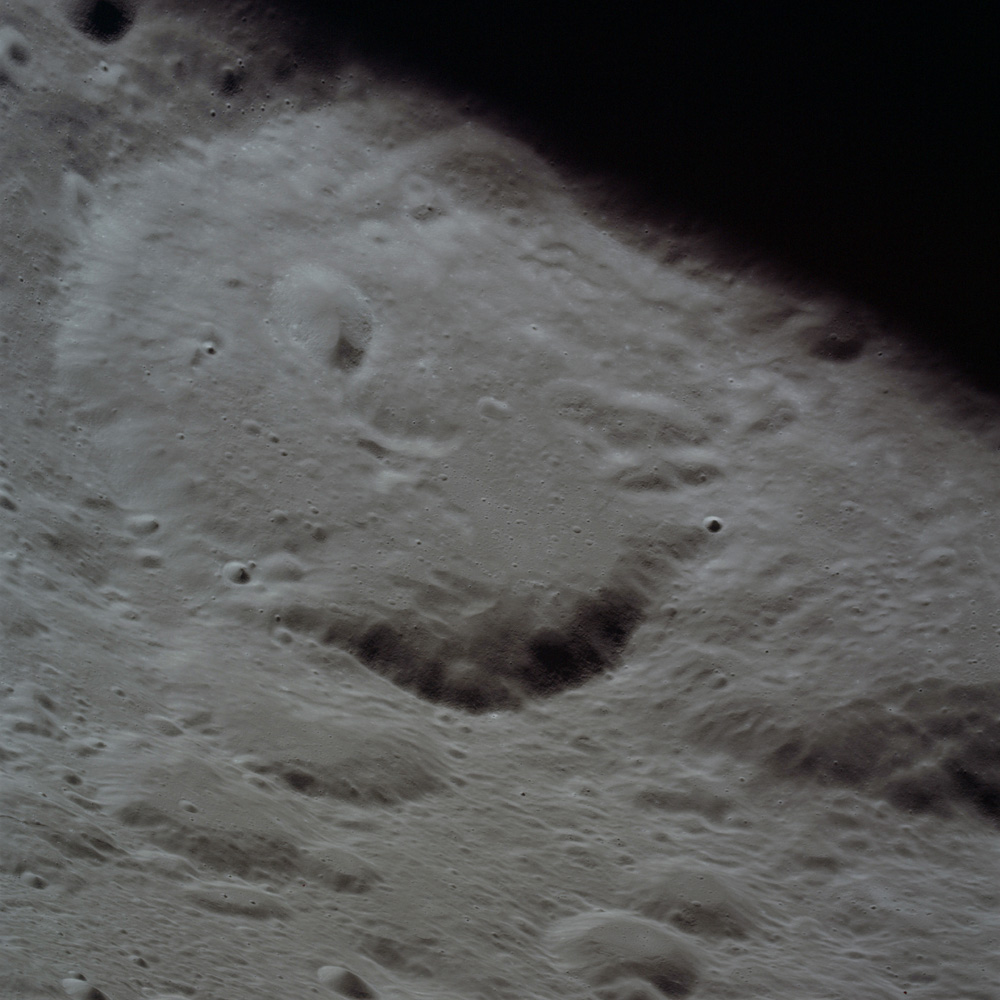
AS17-151-23130 - Crater Racah - JSC scan
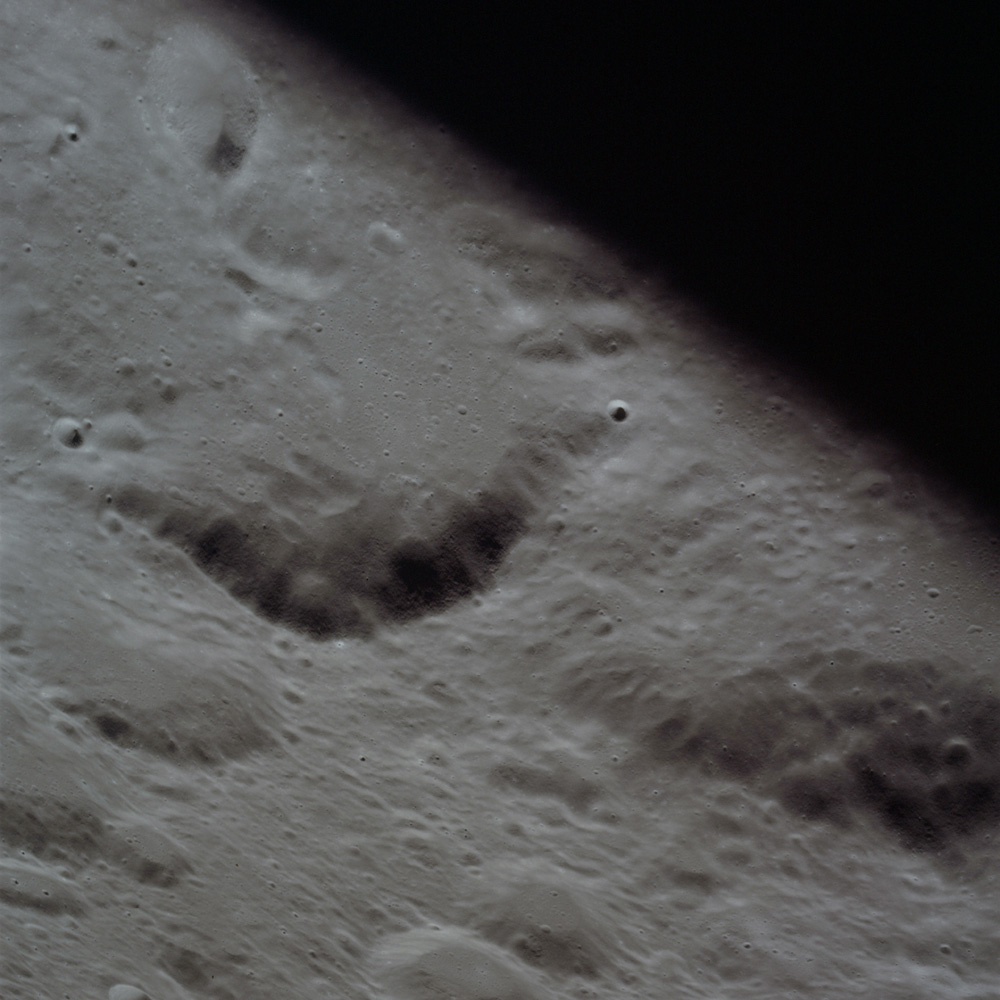
AS17-151-23131 - Crater Racah with elongated crater in its interior - JSC scan
090:XX:XX Cernan: Window number 4, and you want to be on 5.6 but - until you get past Icarus.
090:XX:XX Evans: Icarus? I don't know which one Icarus is.
090:XX:XX Cernan: Well, how about that big one out there, in - with the - Is that a - a very symmetrical pyramid mountain out there? Isn't that Icarus? Huh?
090:XX:XX Schmitt: I would guess that that is Icarus.
090:XX:XX Cernan: I would guess.
090:XX:XX Schmitt: That is Icarus.
090:XX:XX Cernan: I don't know whether you can see it out your window or not. You see that very pyramid-like central peak? Over here, Ron.
090:XX:XX Evans: I got one. I've got everything...
090:XX:XX Cernan: This way. Look at that. That's Icarus because here's...
090:XX:XX Evans: Darn it. Everything went hopping back the other way. [Laughter.]
090:XX:XX Cernan: Oh, you want to stay - are you...
090:XX:XX Evans: I'm still at window...
090:56:33 Cernan: Okay. And f/8 is about - you want to stay - stay at 5.6. Right?
090:XX:XX Evans: Yes.
090:XX:XX Cernan: Okay. Stay at 5.6, and you should be in window 4.
090:XX:XX Schmitt: Okay. Here's one of those cone-shaped craters with what looks very much like fill in the bottom. Doesn't look like slump at all. It just looks like the thing's filled up from the bottom up to oh, about a sixth of its depth. Little - few low hummocks but generally very smooth material on the bottom.
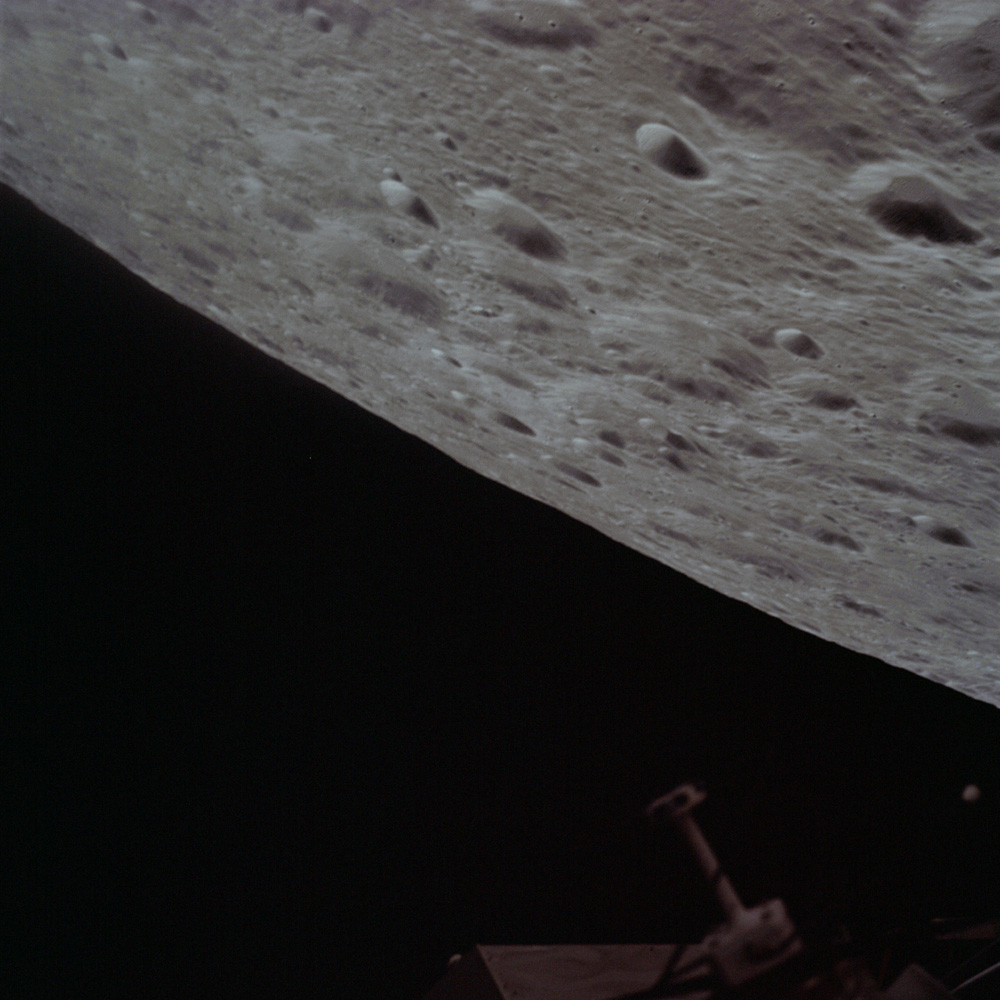
AS17-151-23132 - View northwest over terrain that is west of the line between Racah and Daedalus - JSC scan
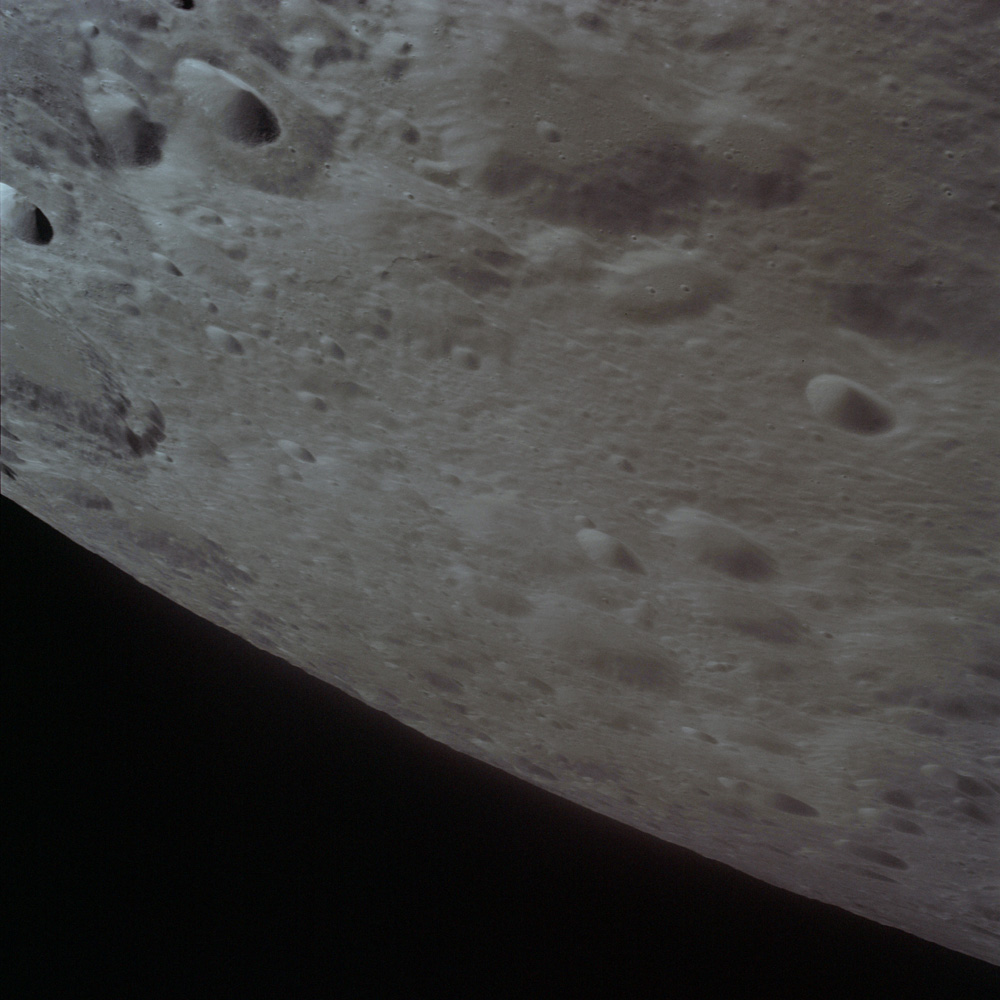
AS17-151-23133 - View northwest over terrain that is west of the line between Racah and Daedalus. Daedalus is the large crater cut off on the left - JSC scan
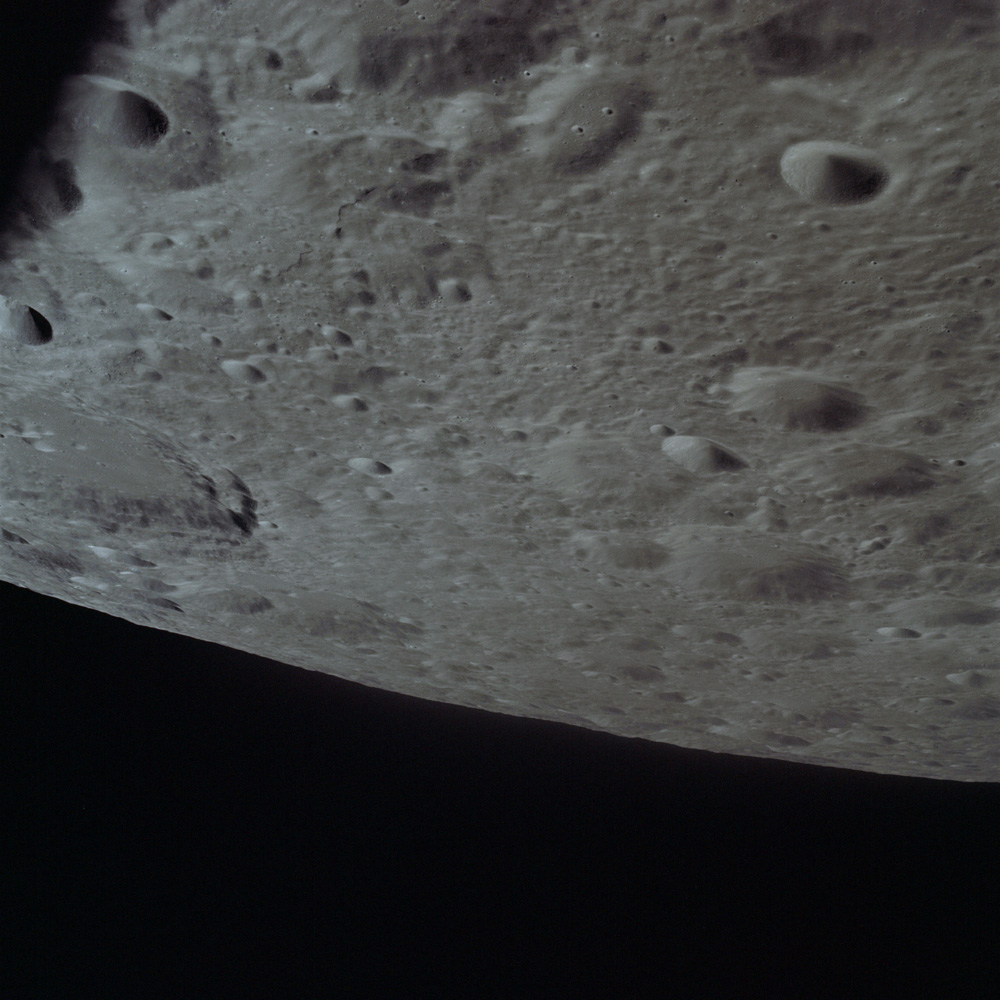
AS17-151-23134 - View northwest over terrain southwest of Daedalus. Daedalus is the large crater cut off on the left - JSC scan
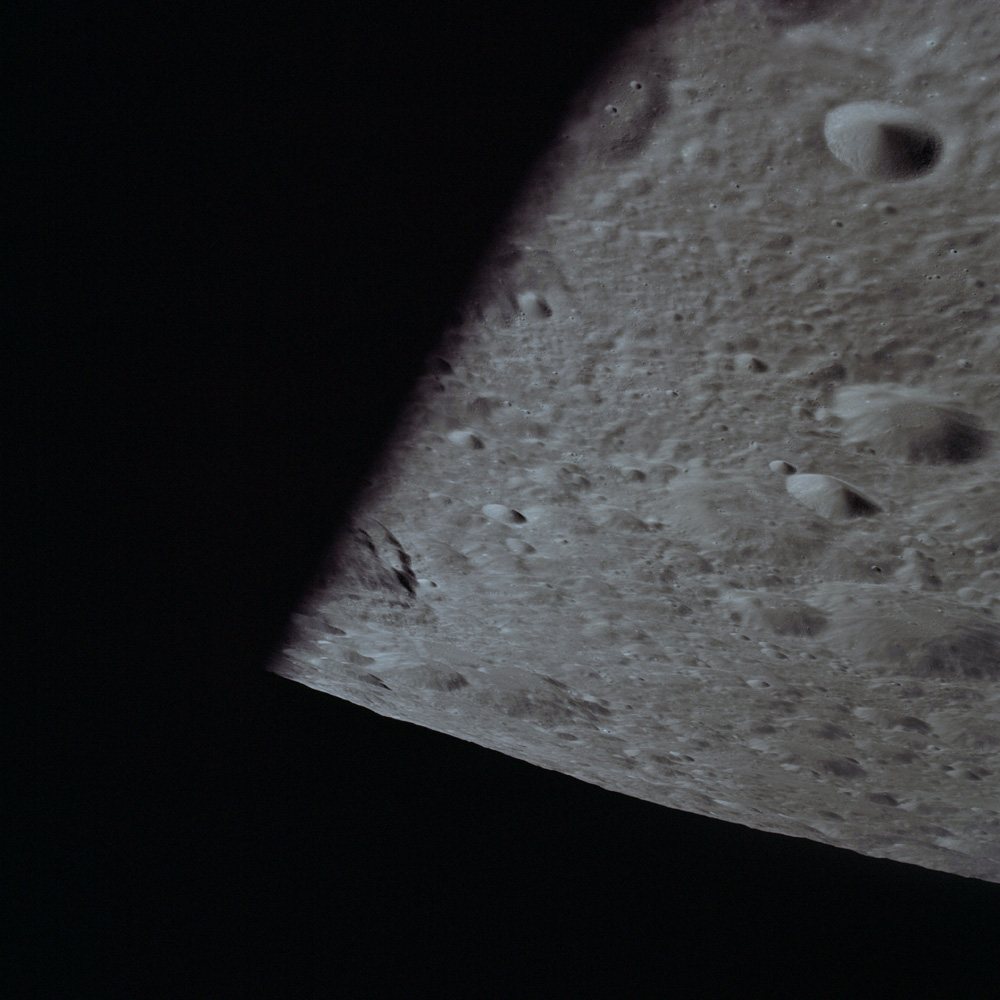
AS17-151-23135 - View north over terrain southwest of Daedalus. West rim of Daedalus is visible behind shadow on the left - JSC scan
090:57:16 Cernan: Ron, I'd say that's Daedalus over there.
090:57:XX Schmitt: Could be debris flow off the...
090:57:XX Evans: Is it? Daedalus?
090:57:XX Cernan: Yes. Right out here? That's Daedalus. Okay. You can - let's see - you can start thinking about, in the next minute, going to f/8.
090:57:XX Evans: Okay.
090:57:XX Cernan: Yes, that's Daedalus over there.
090:57:XX Evans: That's Daedalus we're coming up on?
090:57:XX Cernan: Right out over there - that big one with the very - Looks like it's draped over with...
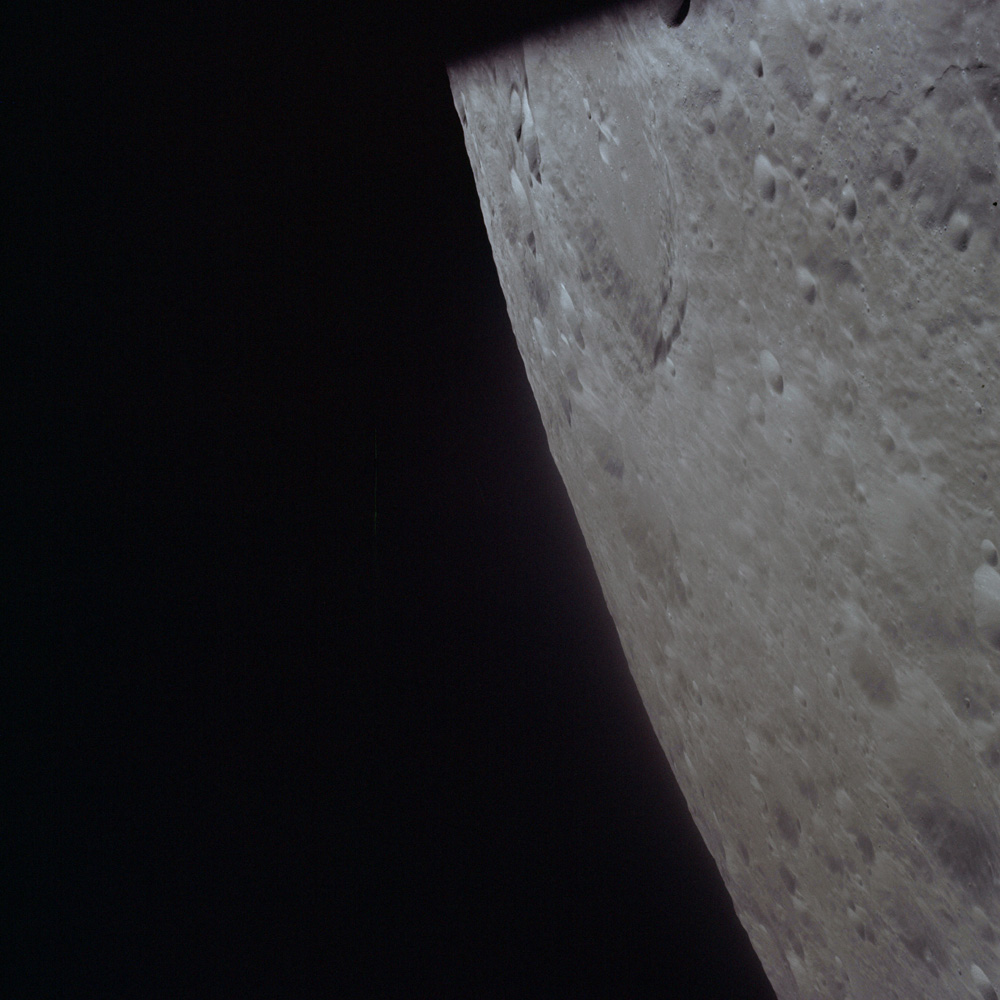
AS17-151-23136 - View north to Daedalus, which is cut off at top of frame - JSC scan
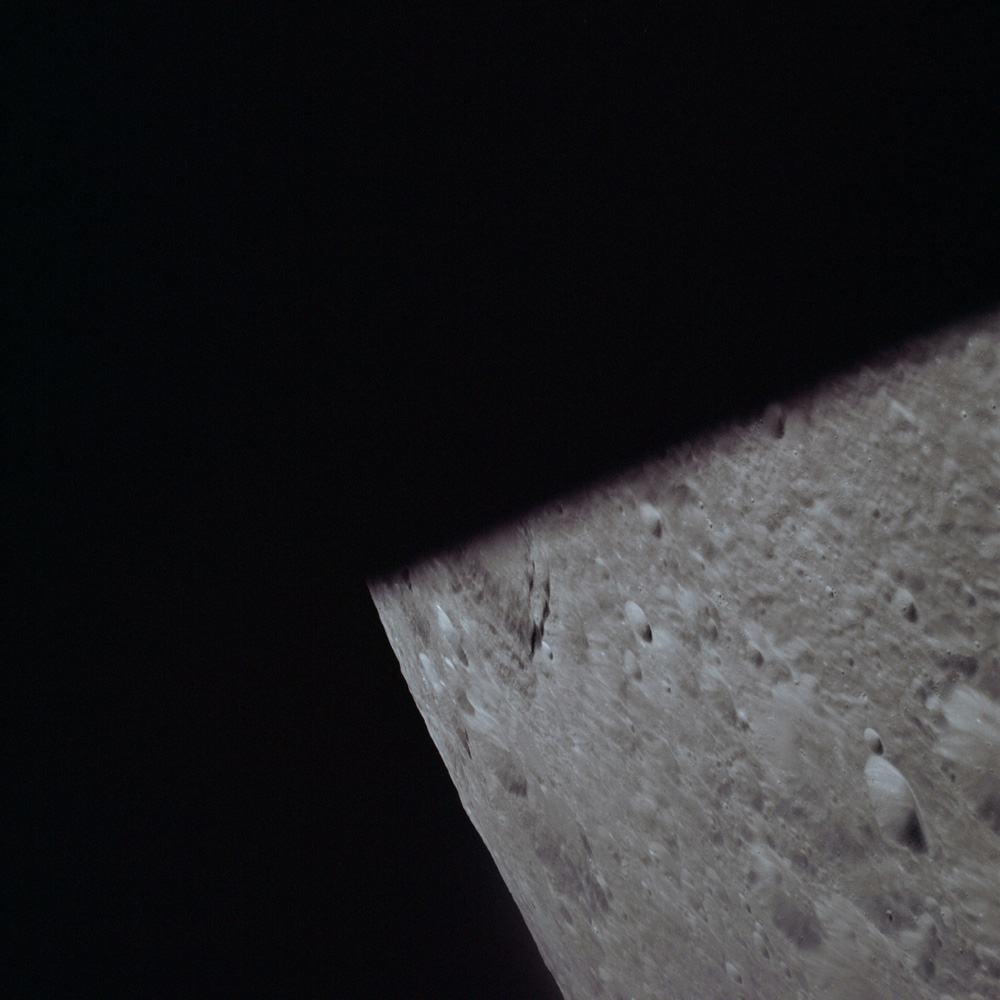
AS17-151-23137 - View north over crater Daedalus west rim. The rest of the crater is behind shadow - JSC scan
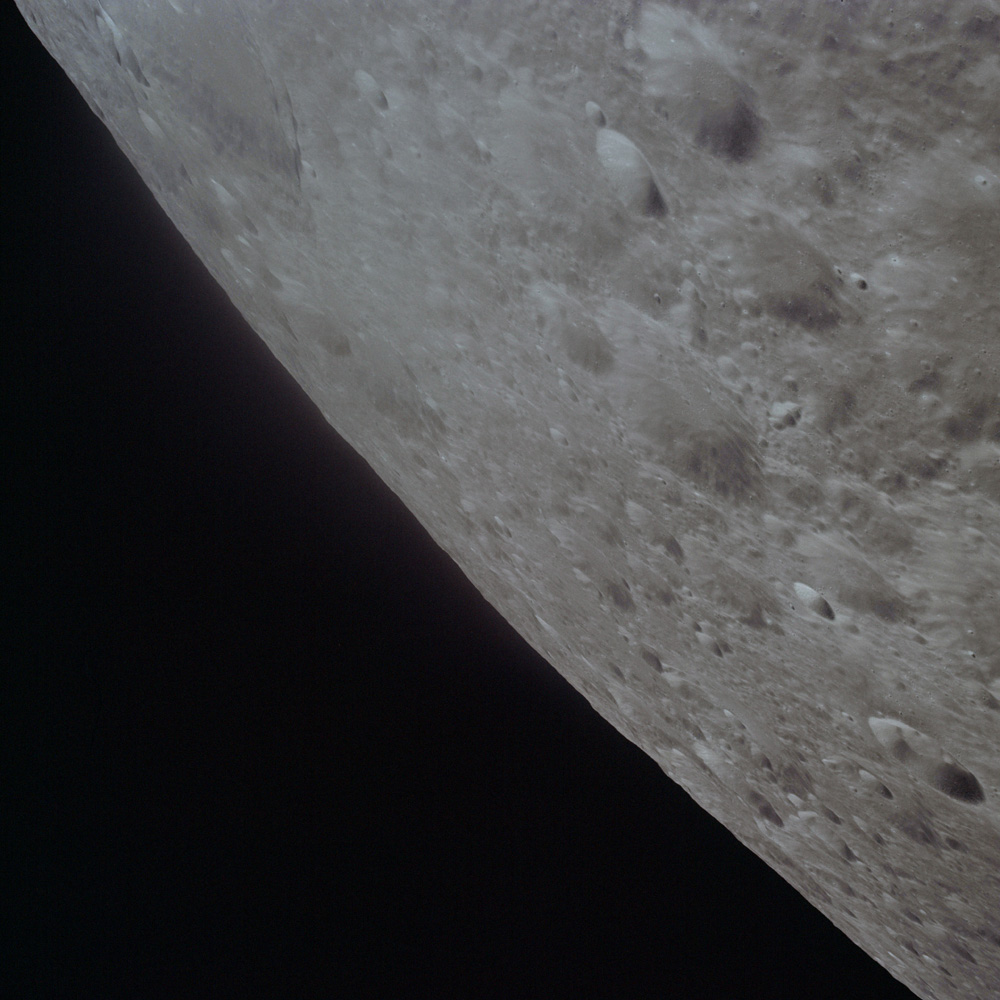
AS17-151-23138 - View northeast over terrain west of Daedalus. The is cut off at top left of frame - JSC scan
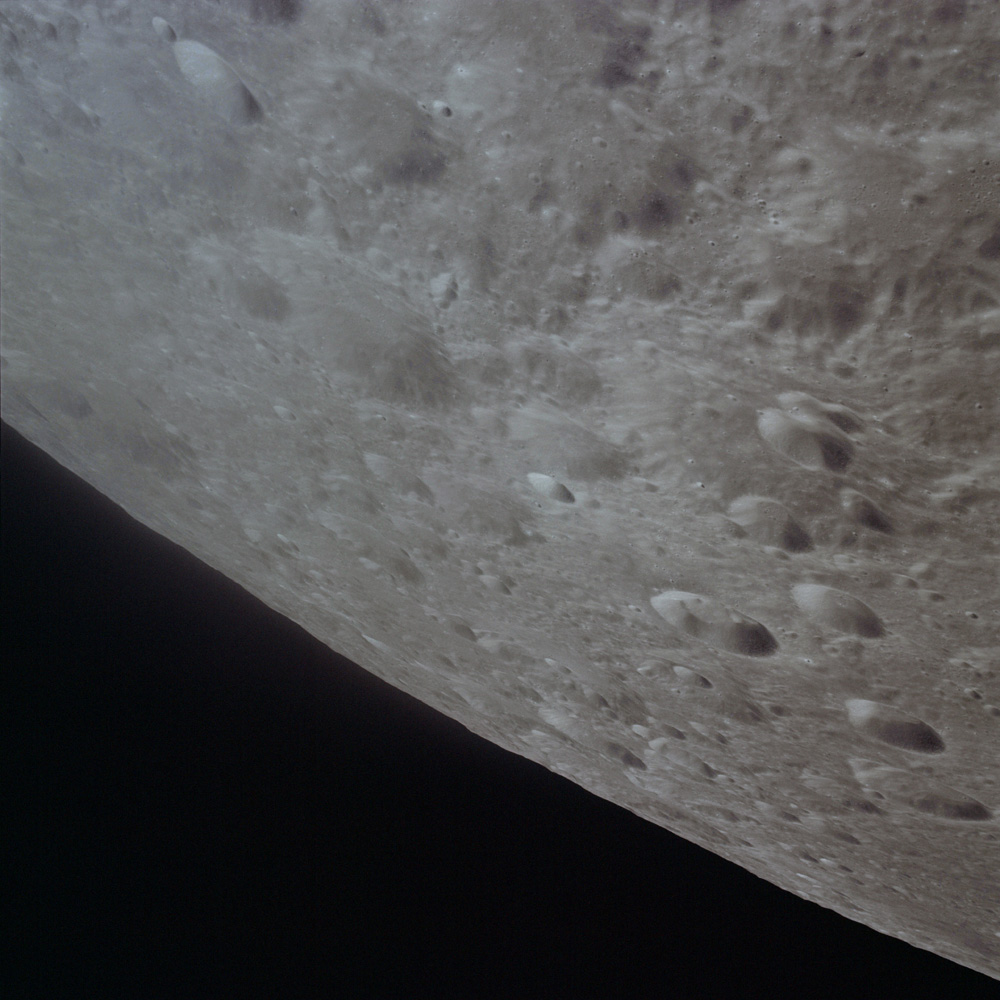
AS17-151-23139 - View north over terrain west of Daedalus. Crater Daedalus R is the larger crater upper left of centre - JSC scan
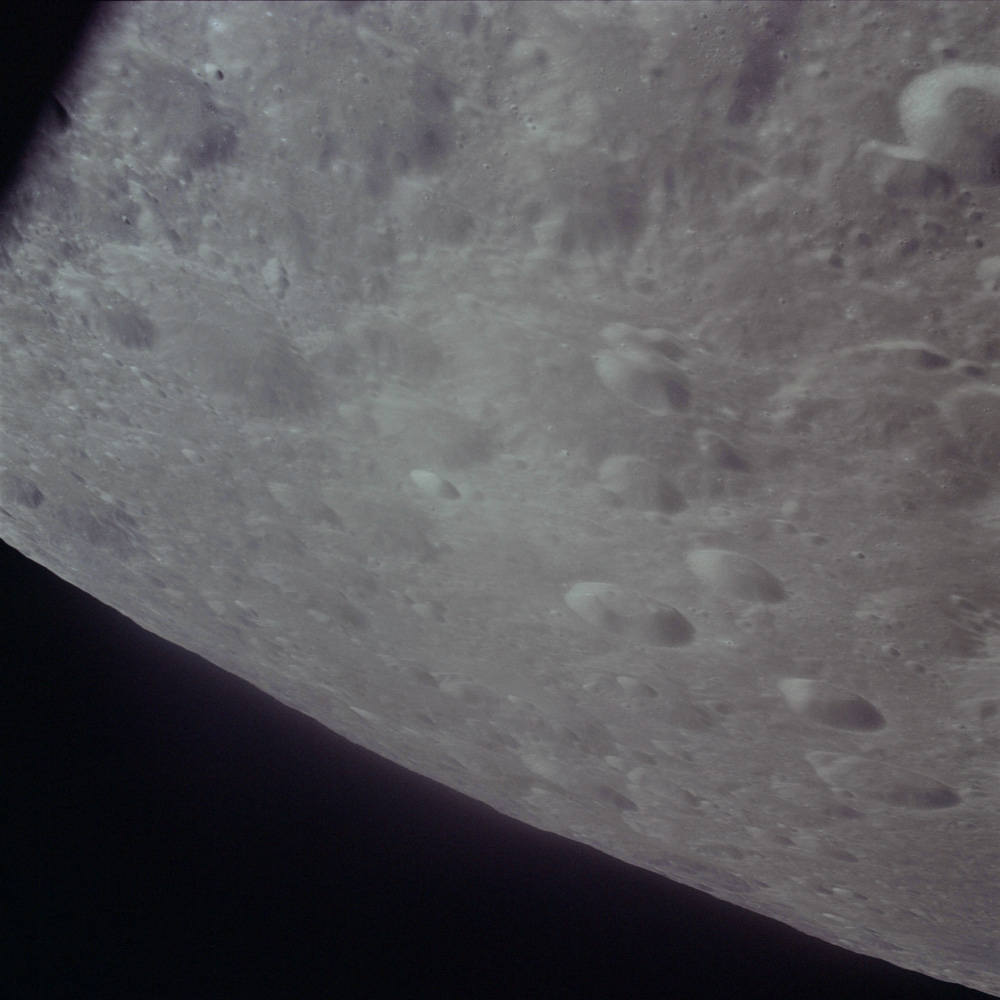
AS17-151-23140 - View north over terrain between Daedalus and Heaviside. Crater Daedalus R is the larger crater to the upper left - JSC scan
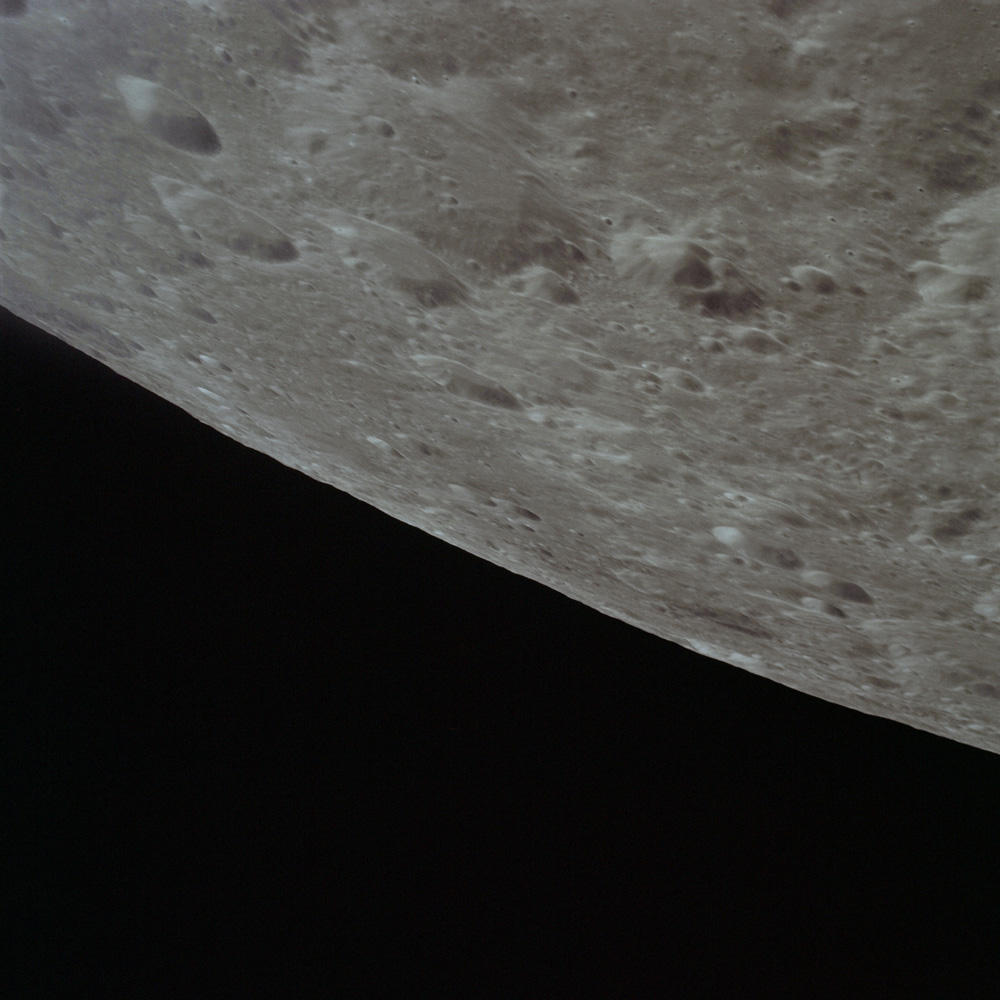
AS17-151-23141 - View north over terrain between Daedalus and Heaviside. Craters Heaviside D is top left with Heaviside C below it - JSC scan
090:57:XX Schmitt: Hey, you ready for me on Low Alt - Low Altitude at...
090:57:XX Cernan: Yes, any time.
090:57:XX Schmitt: Okay.
090:57:52 Schmitt: Mark it. Low Altitude. What's my next one, Gene? You got anything?
090:XX:XX Cernan: Okay. Let me turn the page. Okay. Noth - nothing for about l0 or 12 minutes. We'll stop the Pan Camera.
090:XX:XX Schmitt: Okay. What's...
090:XX:XX Cernan: Don't let me forget that.
090:XX:XX Schmitt: ...What large crater is due south of us, Gene? Do you have that on your map?
090:XX:XX Cernan: Well, how about De Vries? Will you buy that?
090:XX:XX Schmitt: Very large basin, yes.
090:XX:XX Cernan: Or Racah?
090:XX:XX Schmitt: Yes, well...
090:XX:XX Cernan: Or Ingenii - Ingen...
090:XX:XX Schmitt: Out on the horizon?
090:XX:XX Evans: Way out on the horizon is Ingenii.
090:XX:XX Cernan: Well, let's see - I don't have that on here. It's blocked out, I guess, by overprint. Ron, you can go to f/8...
090:58:43 Evans: f/8. Okay.
090:XX:XX Cernan: ...and then come back to the center window.
090:XX:XX Schmitt: Yes, that's Daedalus right there, Ron. I know that. The one I'm looking at here.
090:XX:XX Cernan: Can't tell which one's...
090:XX:XX Schmitt: That's - that's Daedalus over here. See...
090:XX:XX Cernan: But you know, when we look out different windows, it's hard to tell whether...
090:XX:XX Evans: Yes, it's hard to tell. Right.
090:XX:XX Cernan: ...you're seeing the same thing. Okay. Well, we went right by Icarus and Daedalus, and the next big thing...
090:XX:XX Schmitt: Here's Gagarin, I think. No.
090:XX:XX Cernan: ...that I've got coming up, we go - We're darn near Heaviside and Keeler.
090:XX:XX Evans: Heaviside and Keeler up there. I can see those, now.
090:XX:XX Cernan: Can you see those coming? Okay. Well they're...
090:XX:XX Evans: Yes, we're already past them.
090:XX:XX Cernan: And Jack should have Aitken on his side, darn near below us, though.
090:XX:XX Evans: Well, there's a good scarp, soft scarp that's south of Keeler - Heaviside, I mean.
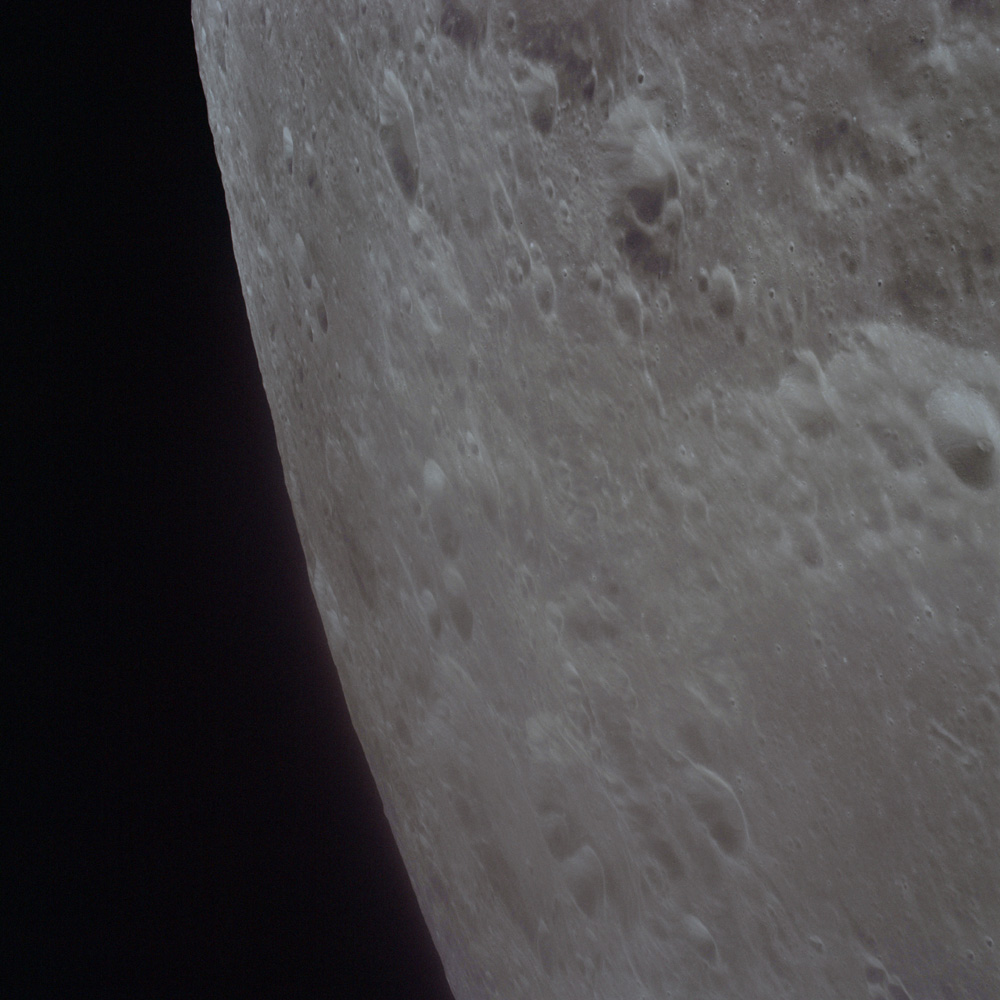
AS17-151-23142 - View north. Northeast rim of Heaviside is lower right. Crater Stratton is lower middle - JSC scan
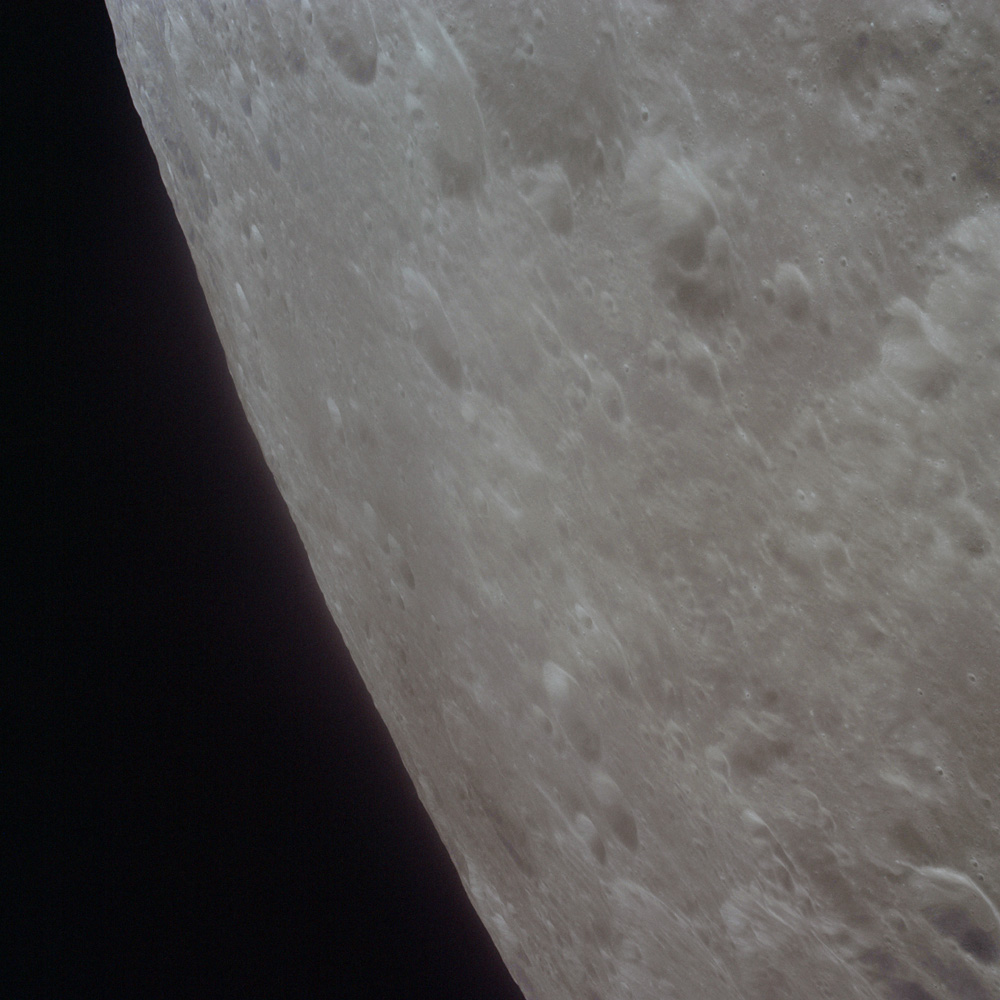
AS17-151-23143 - View north. North rim of Heaviside is lower right. Crater Stratton is cut off right of bottom - JSC scan
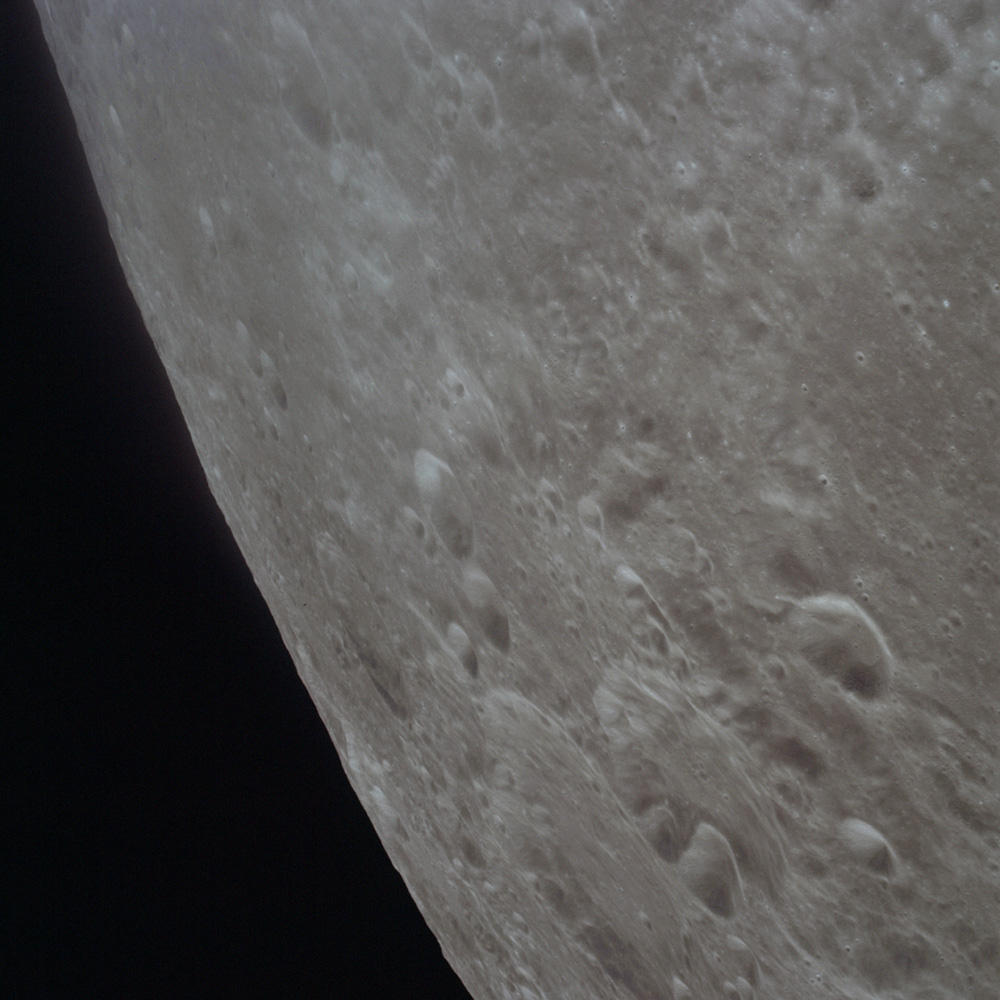
AS17-151-23144 - View north. North rim of Heaviside is on the right. Craters Stratton K and L are lower right with Stratton beyond - JSC scan
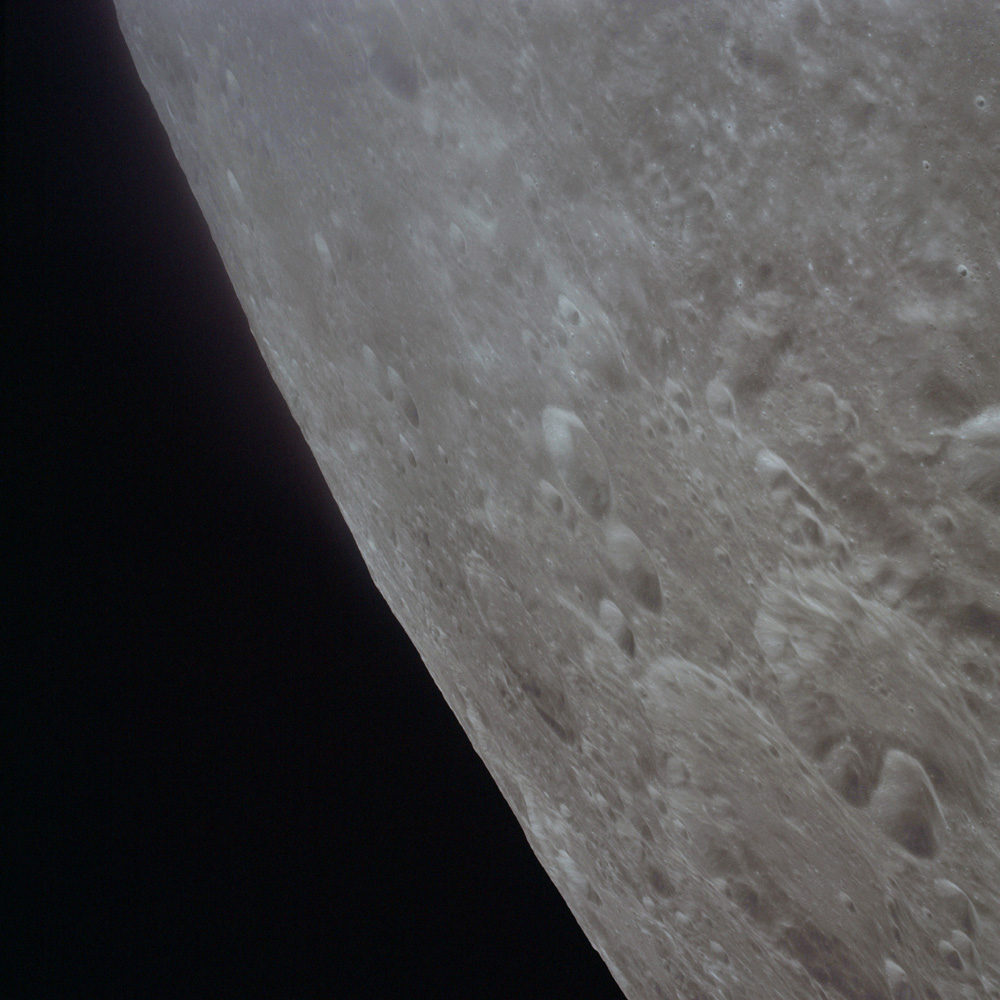
AS17-151-23145 - View north. North rim of Heaviside is on the right. Craters Stratton K and L are lower right with Stratton beyond - JSC scan
090:XX:XX Cernan: Okay, now. See, I'm looking the wrong way to see Heaviside and Keeler. Where are you looking?
090:XX:XX Evans: It's right over that way. See those big things other there?
090:59:57 Schmitt: Okay, this is Aitken. Got Aitken.
091:XX:XX Evans: You got Aitken?
091:XX:XX Schmitt: Tally-ho on Aitken.
091:XX:XX Evans: Okay.
091:XX:XX Schmitt: And it's got those crazy little double-rimmed craters with the dom - domical floors in it.
091:XX:XX Cernan: Oh, Ron. Heaviside's coming up right over here.
091:XX:XX Evans: Gosh, Heaviside...
091:XX:XX Schmitt: It's got...
091:XX:XX Evans: ...[garble]. What the heck is that way?
091:XX:XX Schmitt: ...massive rings...
091:XX:XX Cernan: That's - that's Heaviside, right there...
091:XX:XX Schmitt: ...massive bench would be a better term...
091:XX:XX Cernan: ...to the left. See it?
091:XX:XX Schmitt: ...on the crater...
091:XX:XX Evans: [Garble] that's Gagarin.
091:XX:XX Schmitt: ...near the south rim...
091:XX:XX Cernan: Gagarin.
091:XX:XX Schmitt: ...[garble] be coming up pretty soon.
091:XX:XX Evans: That'll be Gagarin right underneath us.
091:XX:XX Cernan: Well, I don't even have it on this thing. It's not even listed on your chart. Let's see, at 91 hours - Where did the Flight Plan go?
091:XX:XX Schmitt: I got it.
091:XX:XX Evans: Okay; f/8's still good?
091:XX:XX Schmitt: Do you need it?
091:XX:XX Cernan: Well, I just want to see what - well, here.
091:XX:XX Evans: f/8's still good?
091:00:48 Cernan: Yes, f/8 is still good.
091:XX:XX Schmitt: Okay. Aitken has some of the swirl structure in it. It looks like it had - wait a minute - Yes, this is Aitken. It - Again, there is just no clear evidence of relief. Now, in the floor, there's a central peak but there's also looks like a hint of...
091:XX:XX Cernan: These two craters right here...
091:XX:XX Schmitt: ...an inner rim.
091:XX:XX Cernan: ...are Heaviside and Keeler. These two big, big basins, back to back.
091:XX:XX Evans: Oh, okay.
091:XX:XX Schmitt: [Garble] ring and...
091:XX:XX Evans: Those two things up there are Heaviside and...
091:XX:XX Cernan: Yes, sir.
091:XX:XX Schmitt: ...Some of the linear trends of that...
091:XX:XX Cernan: Right here. See this little...
091:XX:XX Schmitt: ...swirl coloration...
091:XX:XX Evans: [Garble] to the north of that.
091:XX:XX Cernan: [Garble] north of these...
091:XX:XX Schmitt: ...associated with...
091:XX:XX Evans: Yes. [Garble] these other two things that I just took a picture of. That must have been Ic - no, it was back this way.
091:XX:XX Cernan: Well, Icarus...
091:XX:XX Evans: That was Daedalus.
091:XX:XX Cernan: ...and Daedalus - Yes, that was - Yes, I could see it before you could.
091:XX:XX Evans: Okay.
091:01:43 Cernan: So I might be a little bit ahead of you, because I can see these things before you could, but you're coming up on - on Heaviside and - and Keeler now.
091:01:XX Evans: Keeler. Right here.
091:01:53 Schmitt: Here's a good example of a crater hitting the wall, guys, where the material apparently slumped down into it, and it's now a - has a linear bottom rather than a cone bottom. You get the impression that this part back here has been powdered almost everywhere except...
091:XX:XX Cernan: Yes.
091:XX:XX Schmitt: ...the new, fresh, [garble] white craters. You know, every crater has somewhat a different kind of textured floor. A lot - There are lot of different textures. Here's one where it's sort of a wiggly hillock texture that has a - a depression around the edge of it - around the edge of the floor next to the wall. Then the one right down there is - is so extremely smooth, there's no texture to it at all.
091:XX:XX Cernan: Well, except for all those that are obviously new which get - Some of them get quite big.
091:XX:XX Evans: I'm still...
091:XX:XX Cernan: They all look like they're powdered over.
091:XX:XX Evans: ...f/8, huh?
091:XX:XX Cernan: Yes, still f/8. You know, Jack, looking at that one, you get a - you're looking at a whole different world than I am, [garble] so...
091:02:56 Schmitt: Oh, okay. There's Gagarin.
091:XX:XX Cernan: ...you got Gagarin now. We're coming right over the top of Heaviside...
091:XX:XX Schmitt: No, wait a minute. That's not [garble]...
091:XX:XX Cernan: ...Heaviside and Keeler...
091:XX:XX Schmitt: ...[garble] over [garble].
091:XX:XX Cernan: ...Right now - right now, we're right over the top of Heaviside, right smack over the top. And right here...
091:XX:XX Evans: I don't see it.
091:XX:XX Cernan: ...with the central peak and with the crater...
091:XX:XX Evans: What's...
091:XX:XX Cernan: ...on the eastern...
091:XX:XX Evans: ...What's north of Heaviside?
091:XX:XX Cernan: What's what?
091:XX:XX Evans: North of Heaviside.
091:XX:XX Cernan: North ?
091:XX:XX Evans: It should be just...
091:XX:XX Cernan: Stratton and Dewar up here.
091:XX:XX Evans: Stratton and Dewar?
091:XX:XX Cernan: That's what you're looking at right there.
091:XX:XX Evans: Yes, that's what I'm looking at.
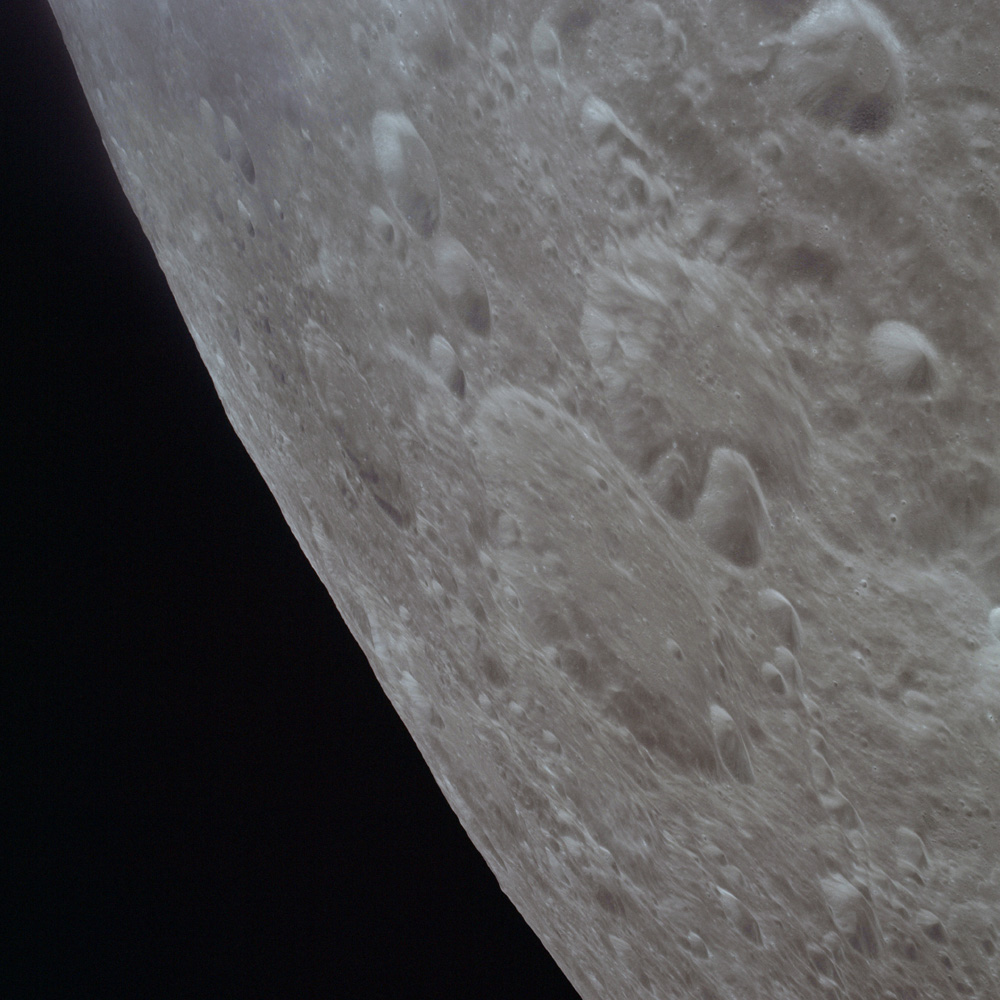
AS17-151-23146 - View north. Stratton is the largest crater in the frame, lower right of centre. Stratton K and L are upper right of Stratton in the foreground. Crater Dewar is beyond Stratton, left of centre - JSC scan
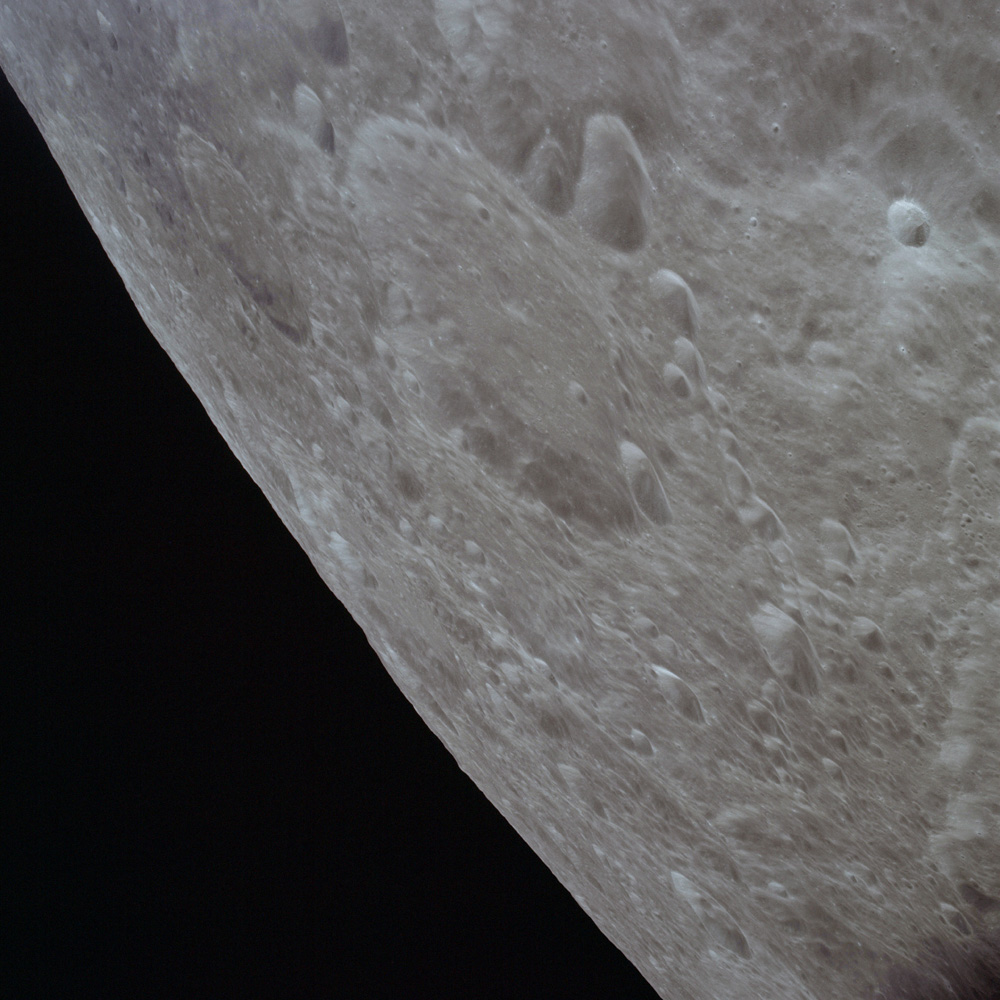
AS17-151-23147 - View north. Crater Stratton is the largest crater in the frame, upper centre. Crater Dewar is beyond Stratton, top left. The north rim of Keeler is visible cut off bottom right - JSC scan
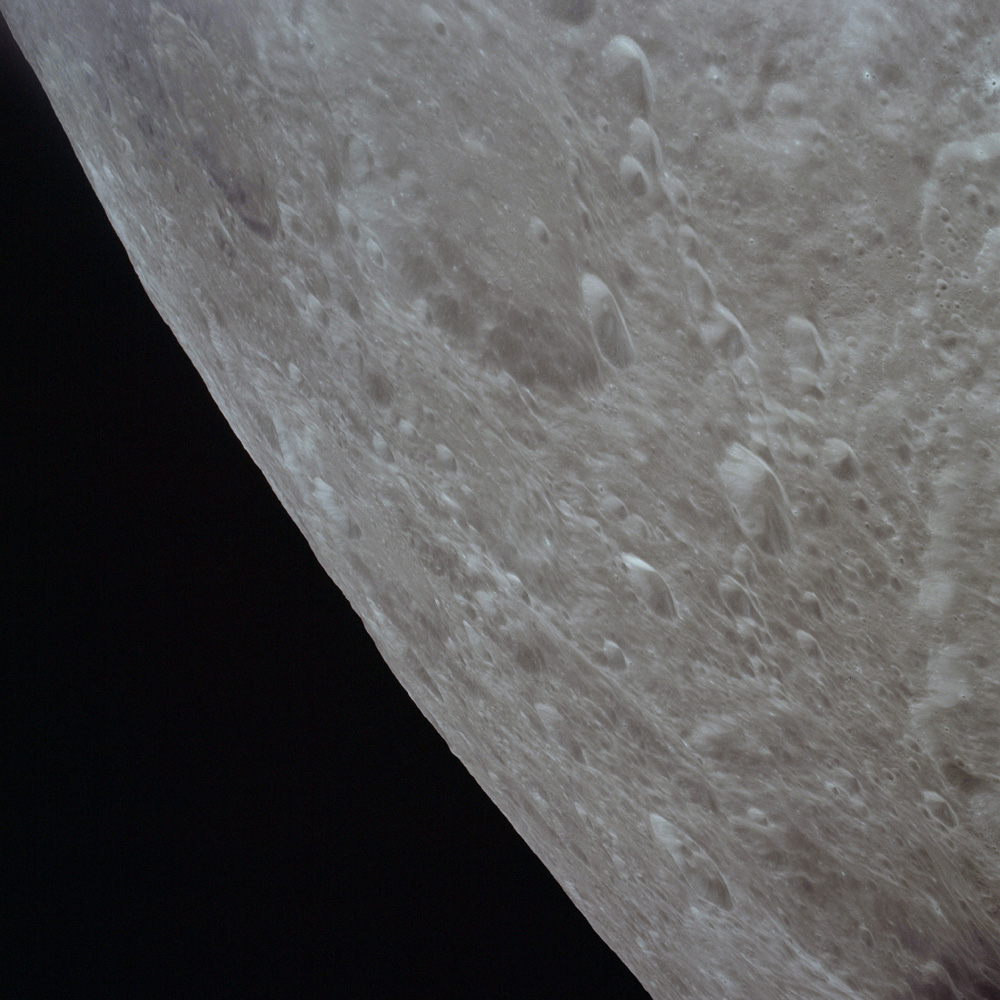
AS17-151-23148 - View north. North rim of Keeler is visible upper right. Crater Stratton is cut off top left - JSC scan
091:03:22 Schmitt: That crater in Keeler there is the one that Jim Lovell used as the landmark track, down on the north rim.
091:XX:XX Cernan: Okay, Ron. You're looking at Stratton and Dewar, and we're right over Heaviside. We're coming to - right over Keeler, right over that eastern crater in Keeler, and then right over the central peak. And what time is it?
091:XX:XX Evans: [Garble].
091:XX:XX Cernan: 03? Okay. About another minute or so, we'll try and get you to f/ll if I can find out...
091:XX:XX Evans: Get to f/11 when I pass Kee...
091:XX:XX Cernan: Pass Keeler.
091:XX:XX Evans: ...pass Keeler, we'll go to f - f/11. Okay.
091:XX:XX Evans: Now, that's kind of messed up because, heck, it took me a half a pass to figure out which way we're going.
091:XX:XX Cernan: Well, that's right and you're looking...
091:XX:XX Evans: And...
091:XX:XX Cernan: ...you're looking in one direction, and I'm looking...
091:XX:XX Evans: ...at everything in another.
091:XX:XX Cernan: So what I see coming, you see - not here yet.
091:XX:XX Evans: Yes.
091:04:17 Cernan: In the - in the central peak in Keeler, you can see some ridges right across the top of the mountainous ridge that are running in a - lineations running in a east-west trend. See that, Jack?
091:XX:XX Schmitt: Yes. They look a little darker.
091:XX:XX Cernan: Yes, they got...
091:XX:XX Schmitt: [Garble] variety would be an overhang there.
091:XX:XX Cernan: ...light and dark and then a shallow...
091:XX:XX Schmitt: It looks like the western side of that - of that central peak just cracks right off.
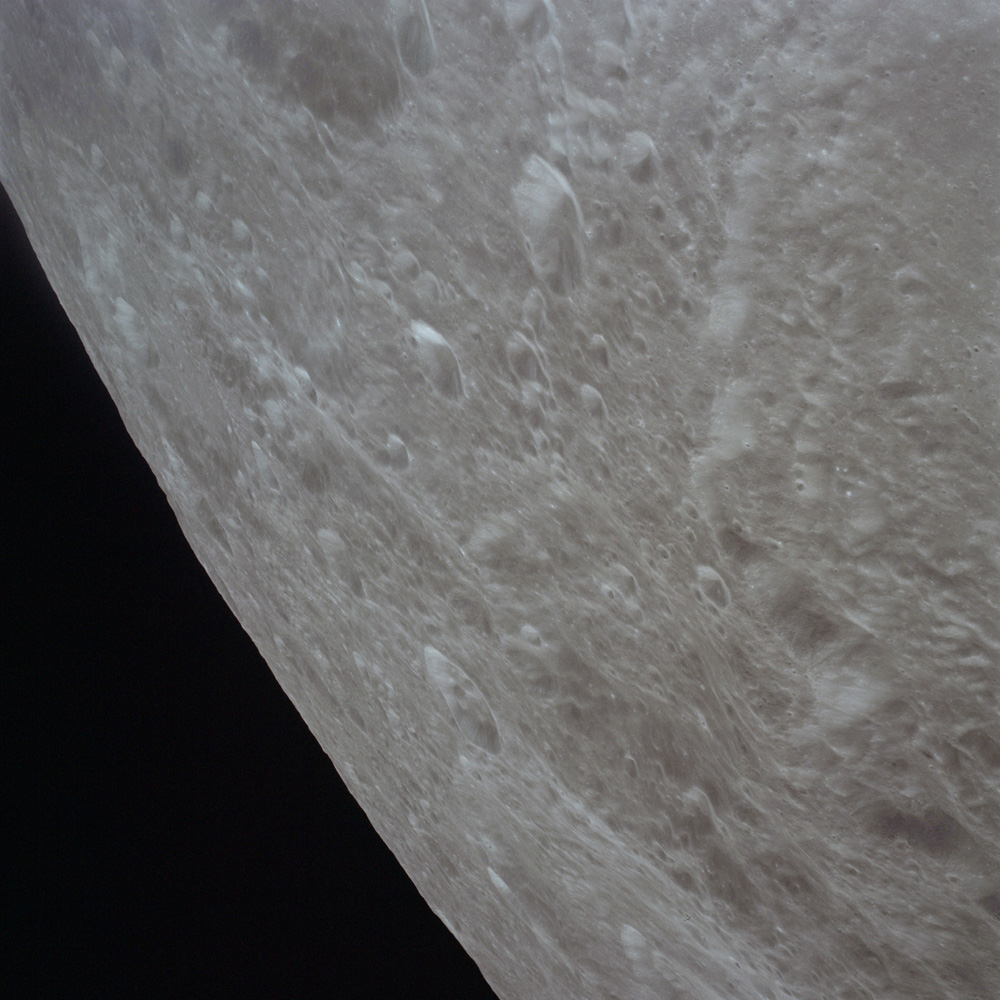
AS17-151-23149 - View north. North rim of Keeler is visible upper right. Crater Stratton is cut off top left - JSC scan
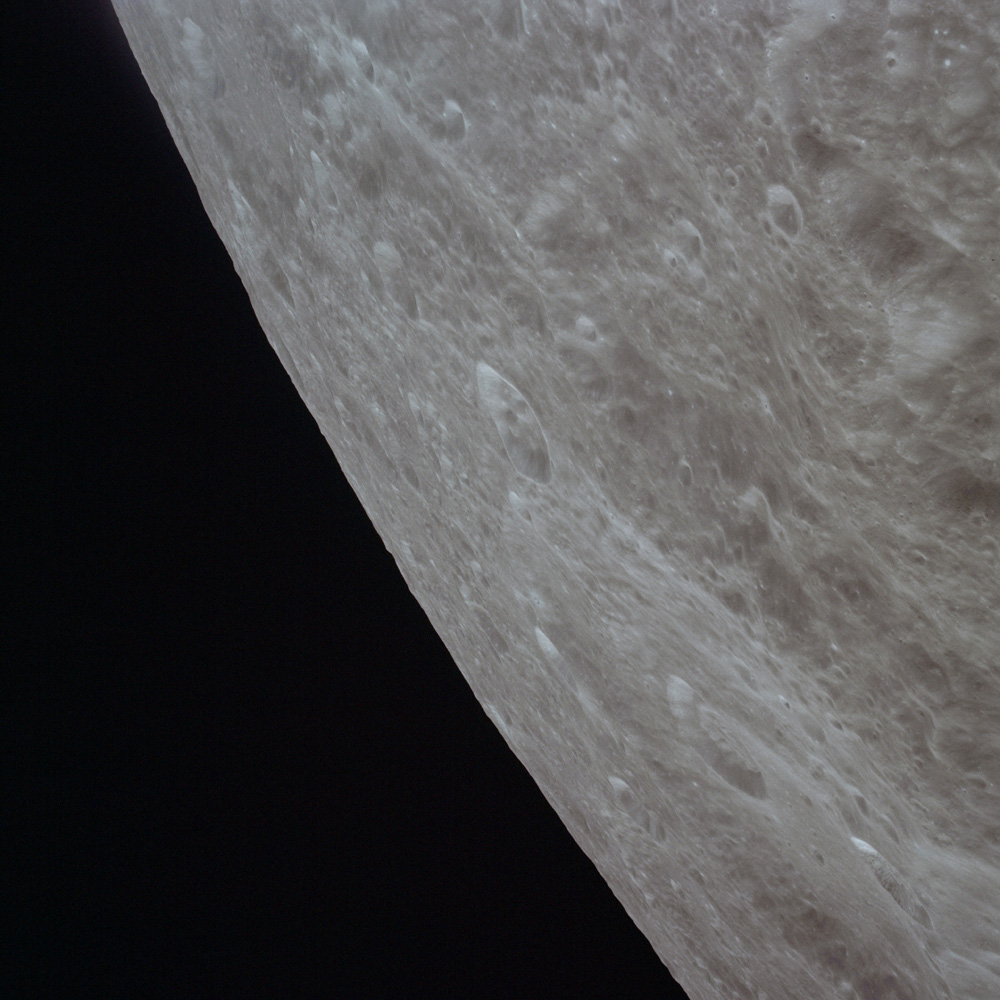
AS17-151-23150 - View north. North rim of Keeler is upper right. Crater Ventris runs from centre to bottom right. Ventris A is within the floor of Ventris - JSC scan
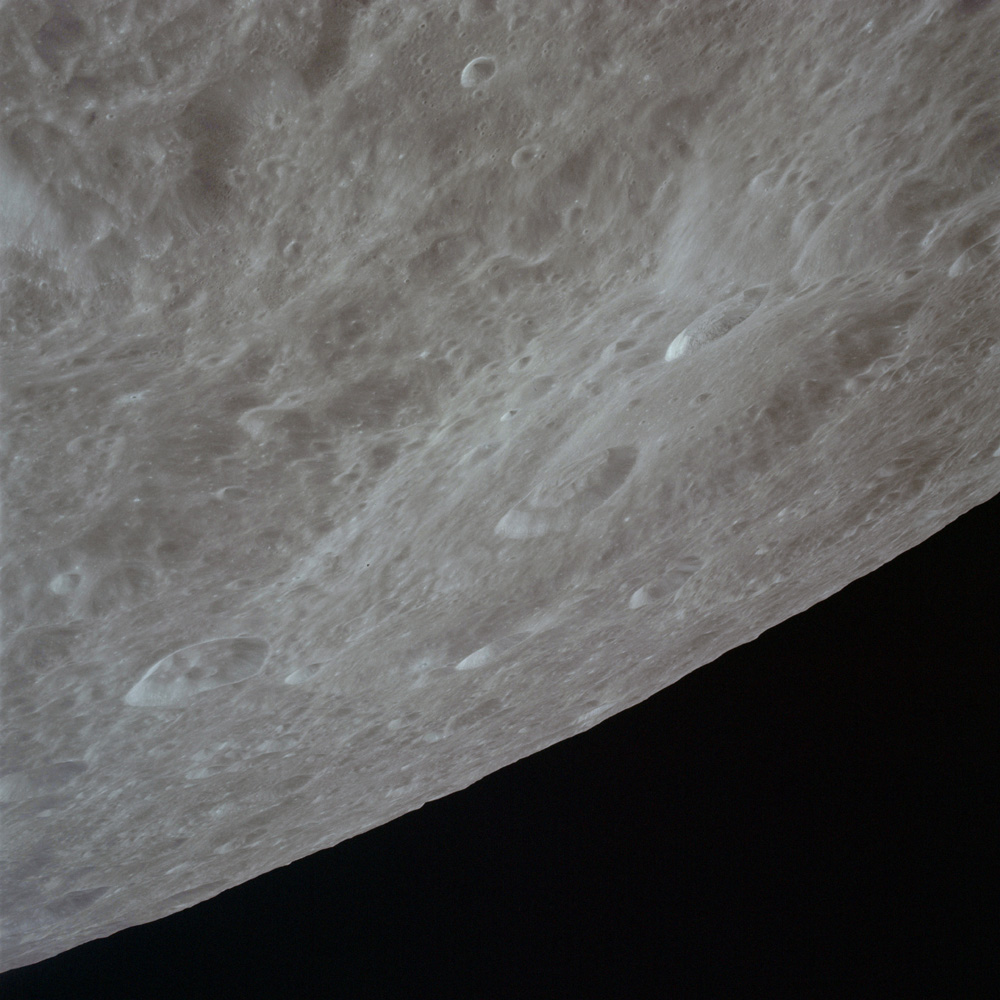
AS17-151-23151 - View north. Large crater Ventris is centre of frame. Ventris A is within the floor of Ventris, Ventris M upper right of centre, and Ventris D is lower left - JSC scan
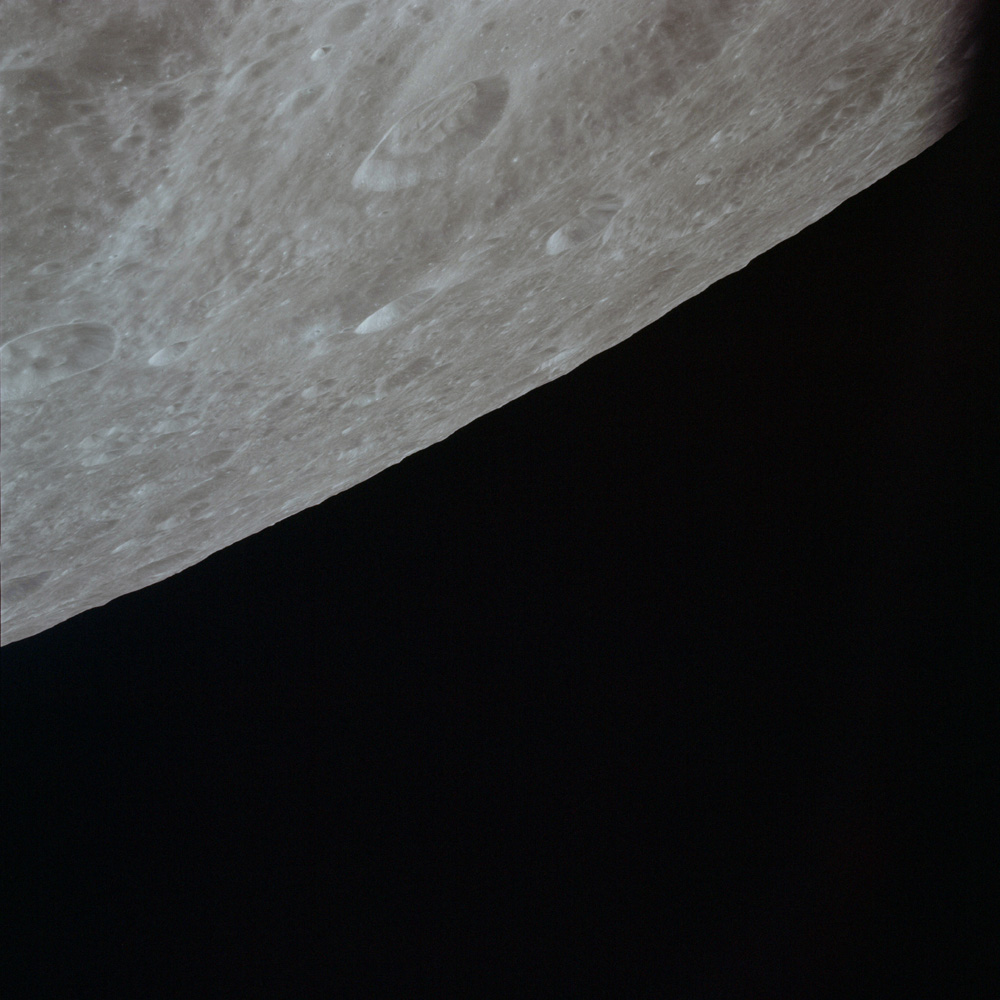
AS17-151-23152 - View north. Large crater Ventris is cut off top of frame. Ventris A is within the floor of Ventris - JSC scan
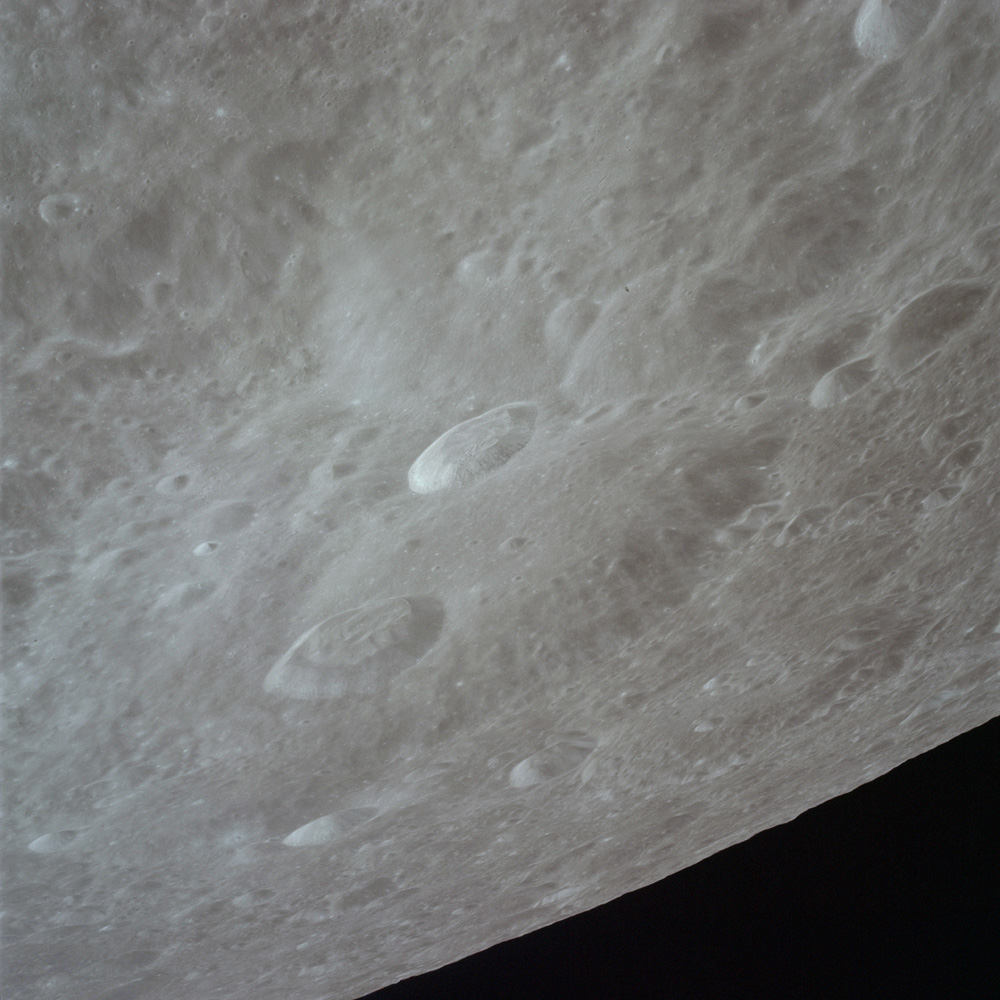
AS17-151-23153 - View north. Large crater Ventris is centre to lower left of frame. Ventris A is within the floor of Ventris, Ventris M is centre, and Ventris B is lower left - JSC scan
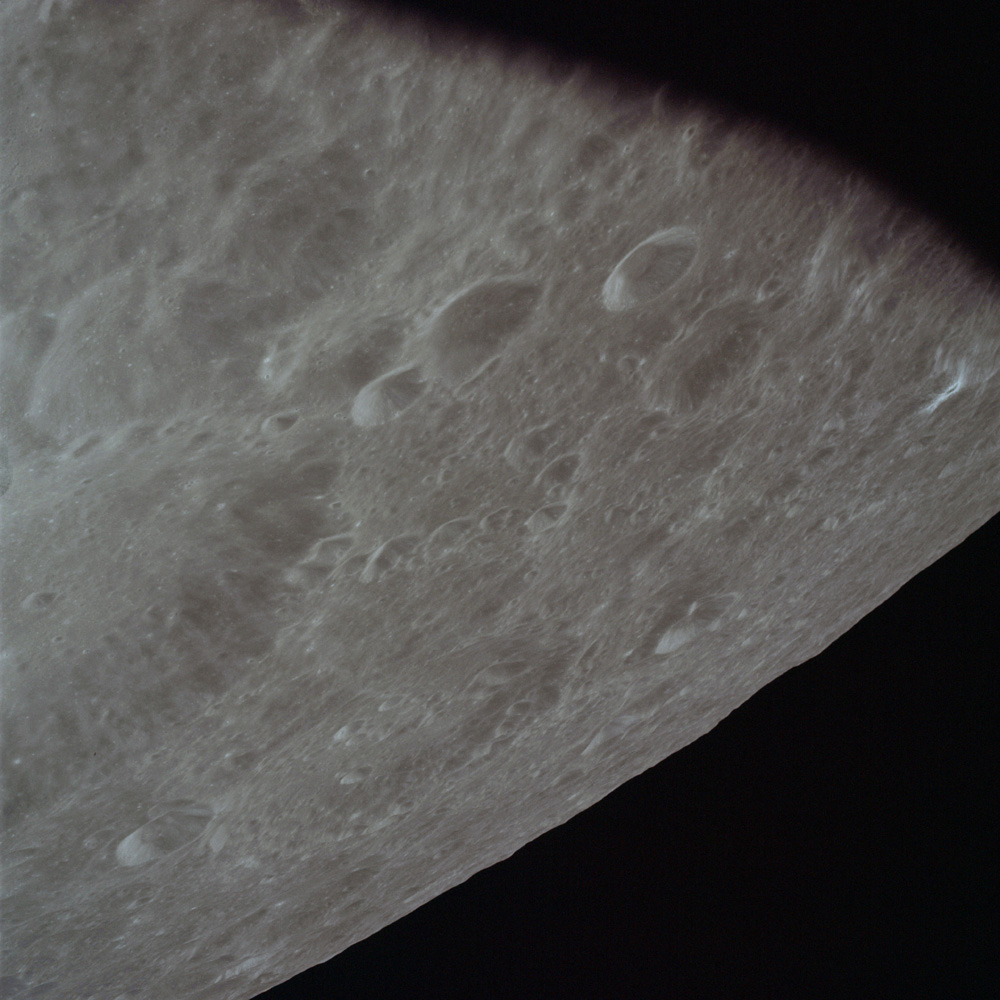
AS17-151-23154 - View northwest. Large crater Ventris is cut off on left. Crater Schliemann is beyond, lower left of centre. At far right is a very small, bright, fresh crater which the crew refer to as Star Chaplygin which is on the northwest rim of Chaplygin - JSC scan
091:XX:XX Cernan: Okay, Ron. You're looking up - let's see, Keeler - you're looking - I'm looking up ahead towards - I don't know whether that's Champlin or not. Is it? No.
091:XX:XX Evans: Chaplygin. Chaplygin.
091:XX:XX Cernan: Chaplygin. No, I'm not...
091:XX:XX Evans: It's got to be somewhere.
091:XX:XX Cernan: Yes, but I'm not looking - Oh, it's up there. I see it. It's down there farther.
091:05:07 Schmitt: There's a population of elongate craters - looks something like the highland version of your sea. Every once in a while, you see those kind of craters.
091:05:XX Evans: Yes.
091:05:XX Schmitt: You know that...
091:05:XX Evans: What does - what does Chaplygin look like?
091:05:XX Schmitt: Chaplygin...
091:05:XX Evans: Is that one down inside of it?
091:05:XX Cernan: Yes, there's a couple down on the south side, and there's a central peak, and there's some - some linear breaching on the north side, Ron. And then, don't forget the Star Chaplygin. You know, Jack, that...
091:05:XX Evans: I can't see them.
091:05:XX Cernan: ...those lineations in the central peak of Keeler look like what they might have been looking for at Copernicus.
091:05:XX Schmitt: Yes.
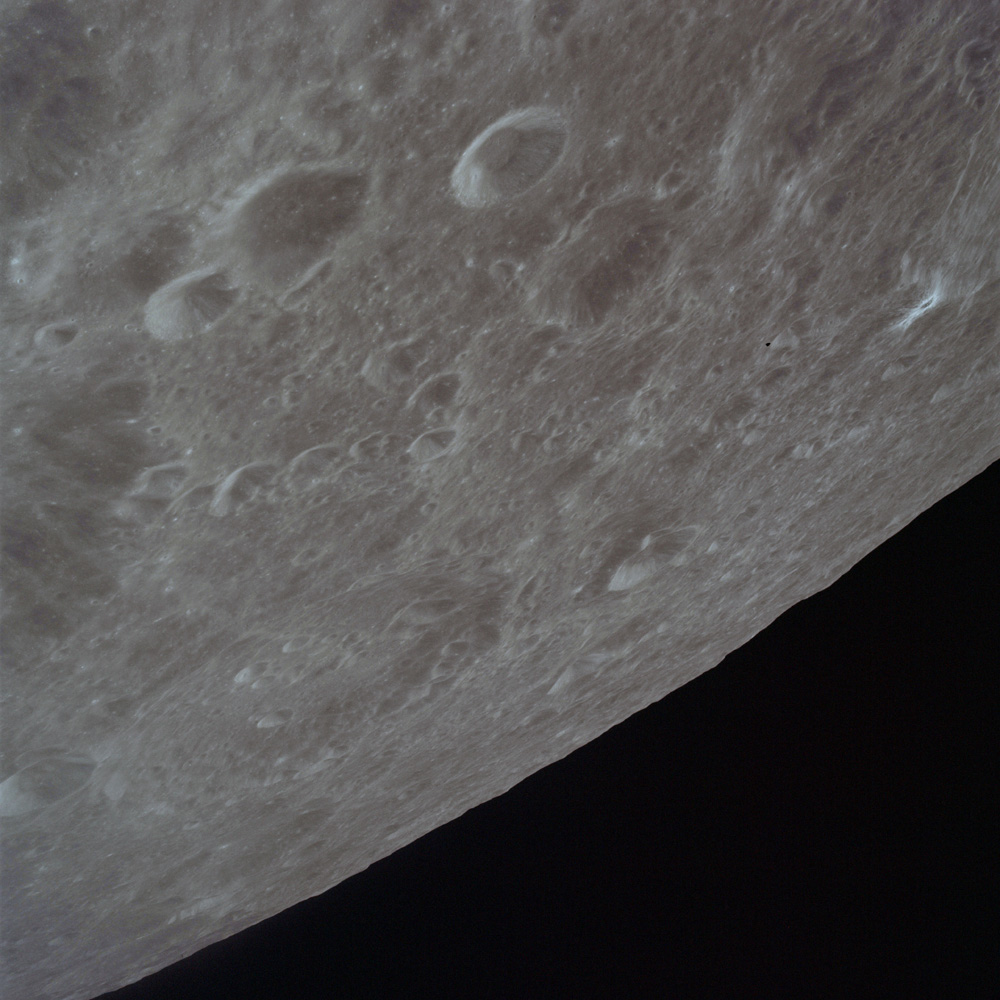
AS17-151-23155 - View northwest. Crater Schliemann lower left. Bright ray crater Star Chaplygin, which is on the northwest rim of Chaplygin, is on the right - JSC scan
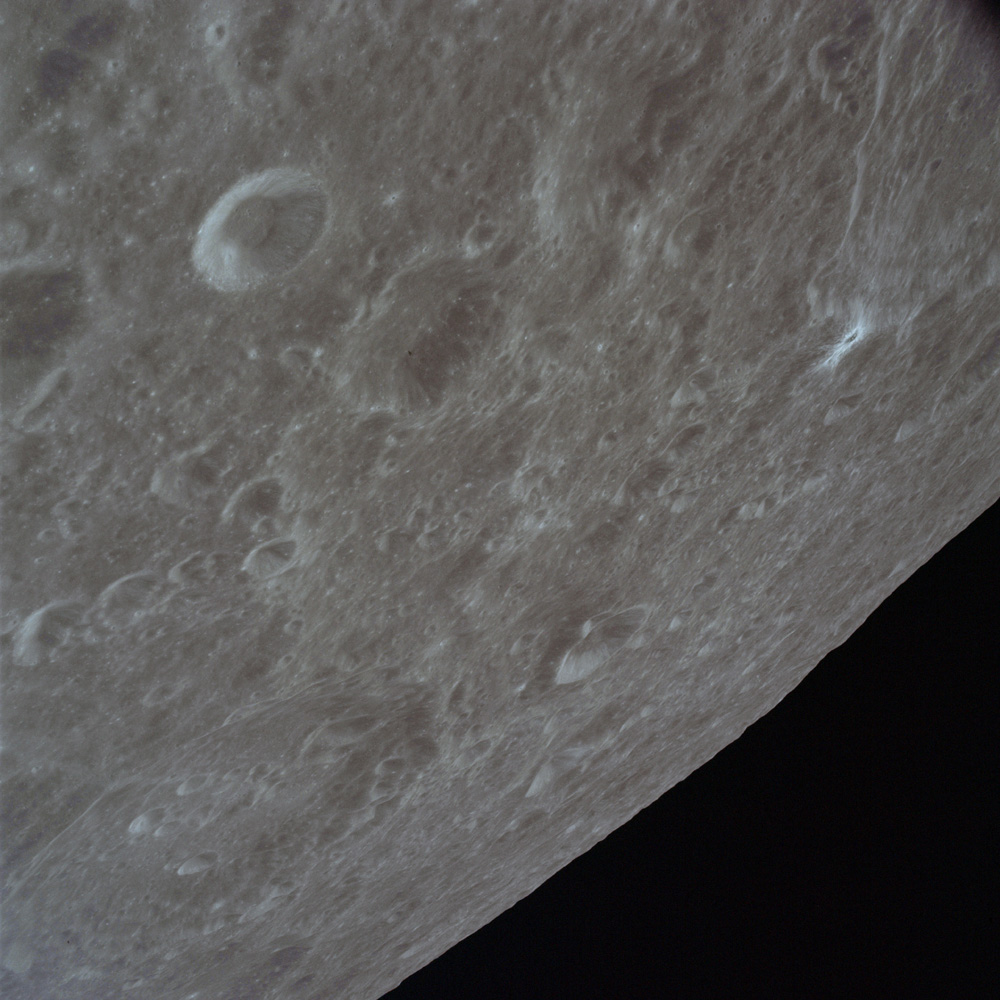
AS17-151-23156 - View northwest. Crater Schliemann lower left. Bright ray crater Star Chaplygin, which is on the northwest rim of Chaplygin, is on the right - JSC scan
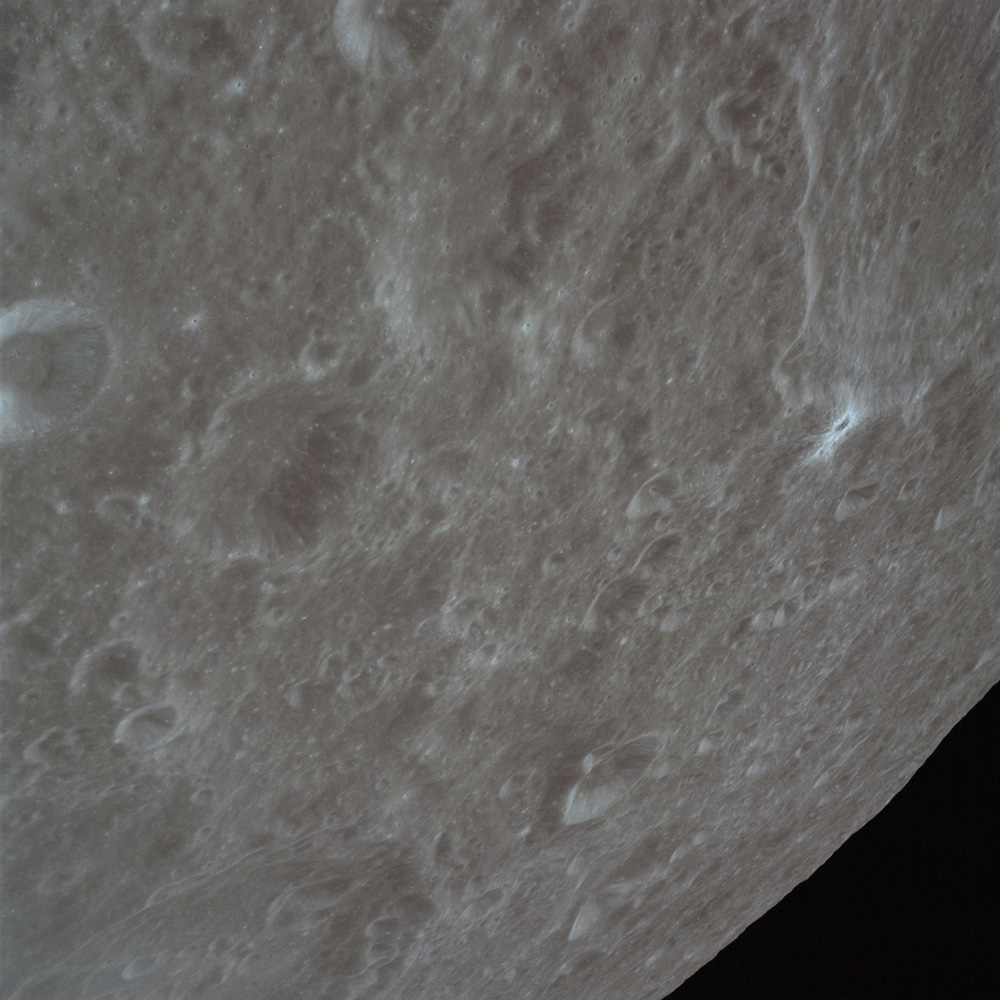
AS17-151-23157 - View northwest. Crater Schliemann is cut off lower left. Bright ray crater Star Chaplygin and the eastern rim of Chaplygin are on the right - JSC scan
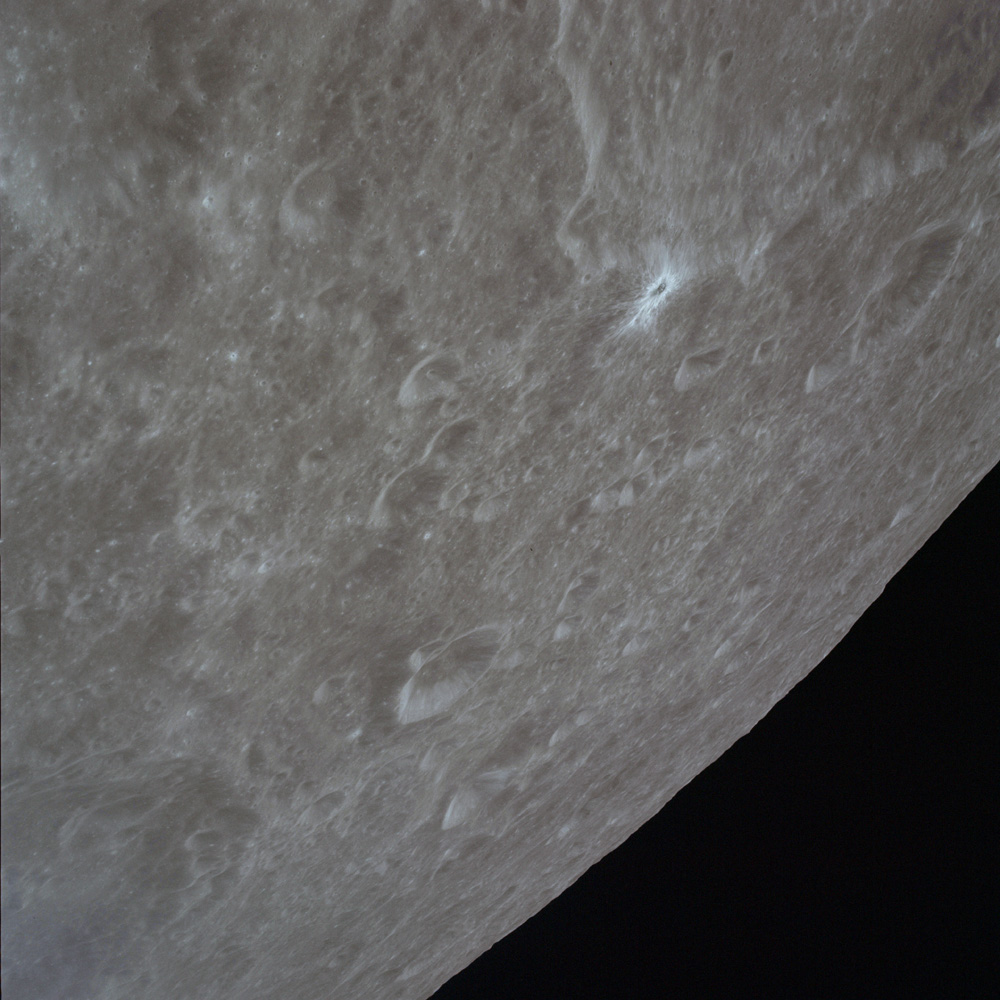
AS17-151-23158 - View northwest. Crater Schliemann is cut off lower left. Bright ray crater Star Chaplygin and the northeastern rim of Chaplygin are upper right - JSC scan
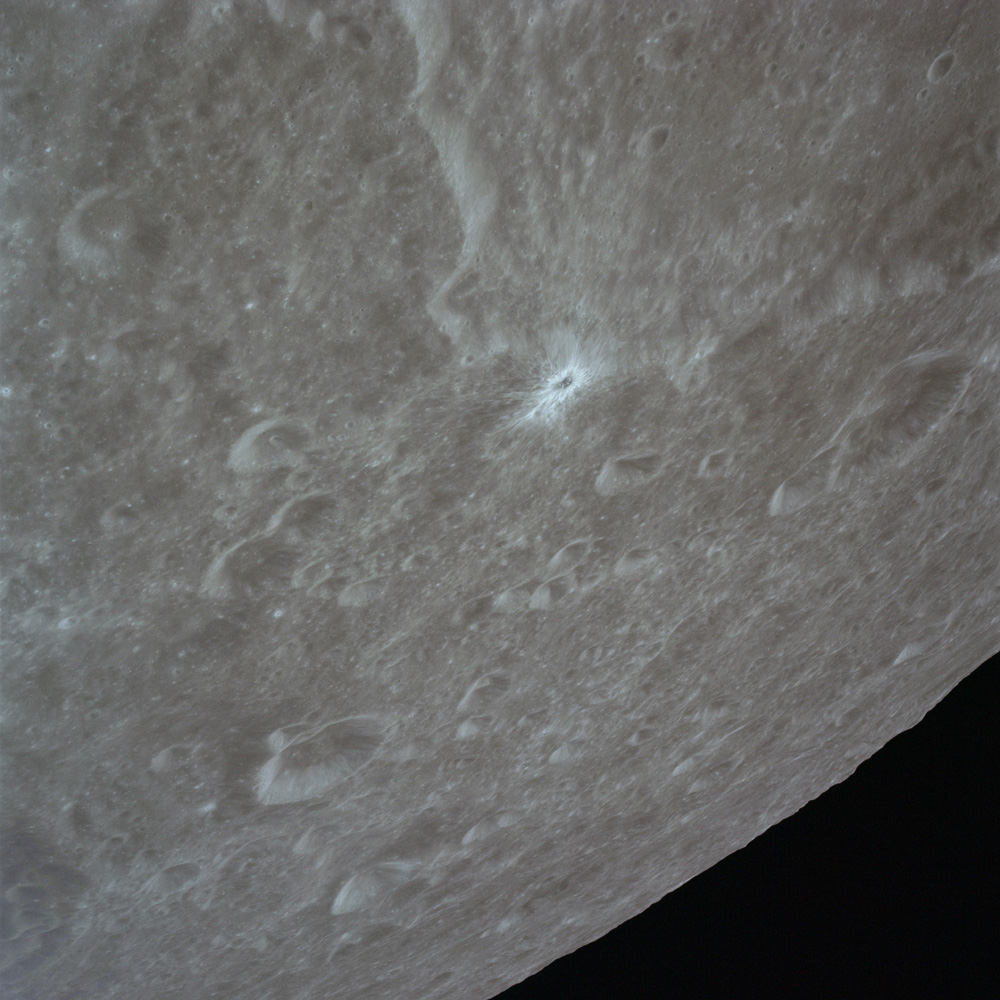
AS17-151-23159 - Bright ray crater Star Chaplygin and the northeastern rim of Chaplygin are upper right - JSC scan
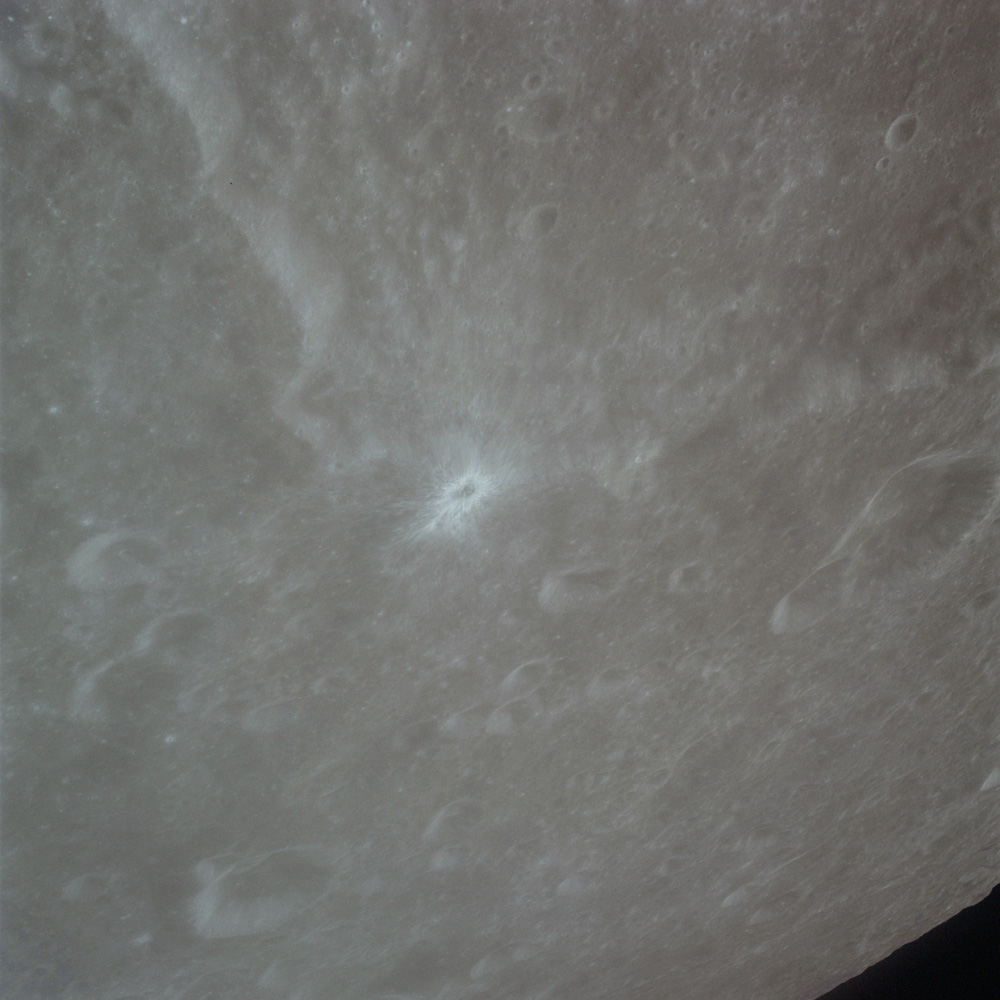
AS17-151-23160 - Bright ray crater Star Chaplygin is at centre. Eastern rim of Chaplygin runs upper left and the its northern rim runs to the right - JSC scan
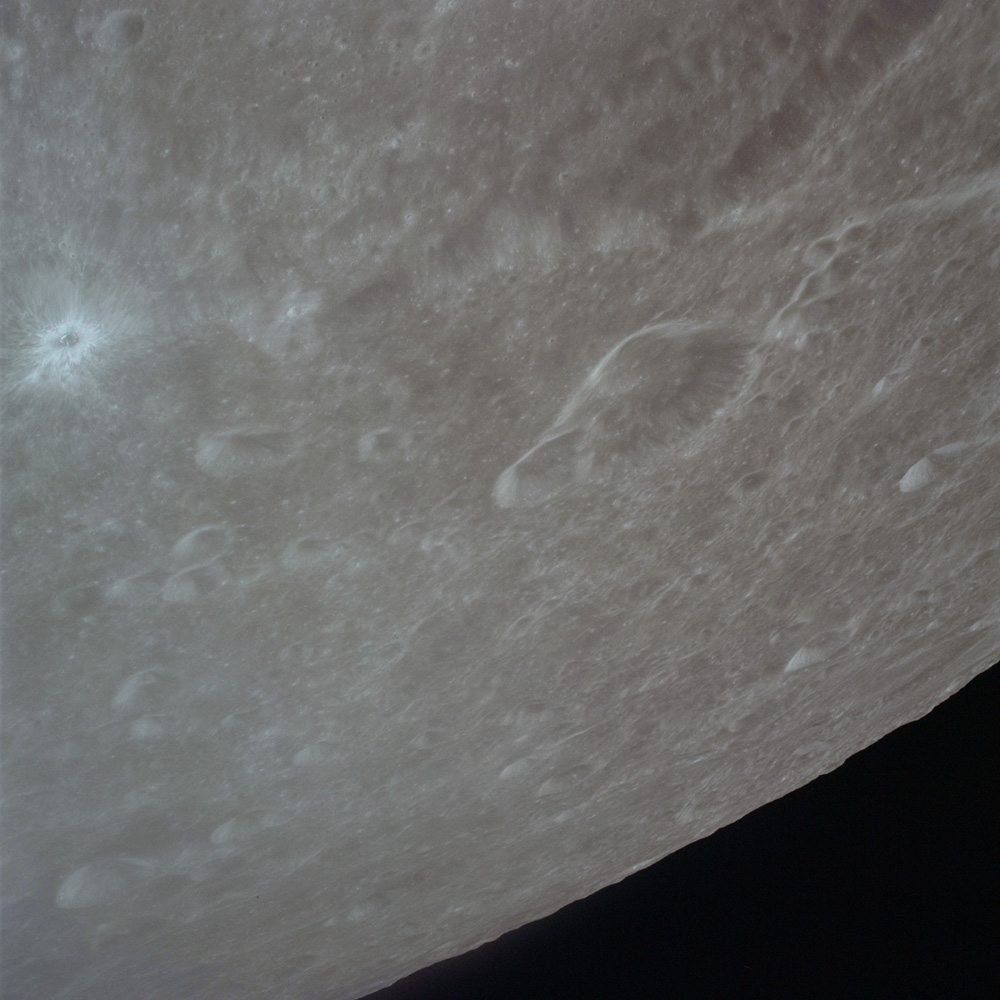
AS17-151-23161 - Bright ray crater Star Chaplygin which is on the northwest rim of Chaplygin is on the left. Chaplygin's northern rim runs from there to the right. Chaplygin Y is upper right of centre - JSC scan
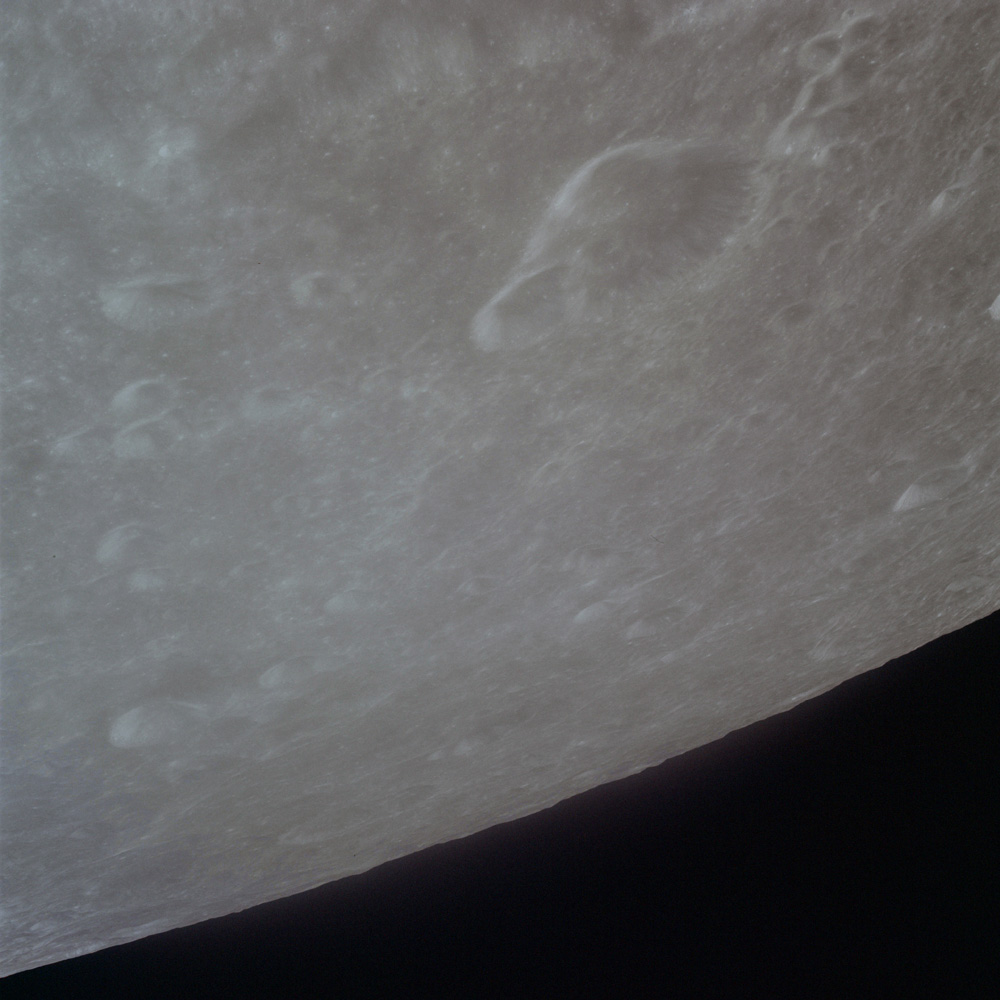
AS17-151-23162 - Chaplygin Y upper right of centre - JSC scan
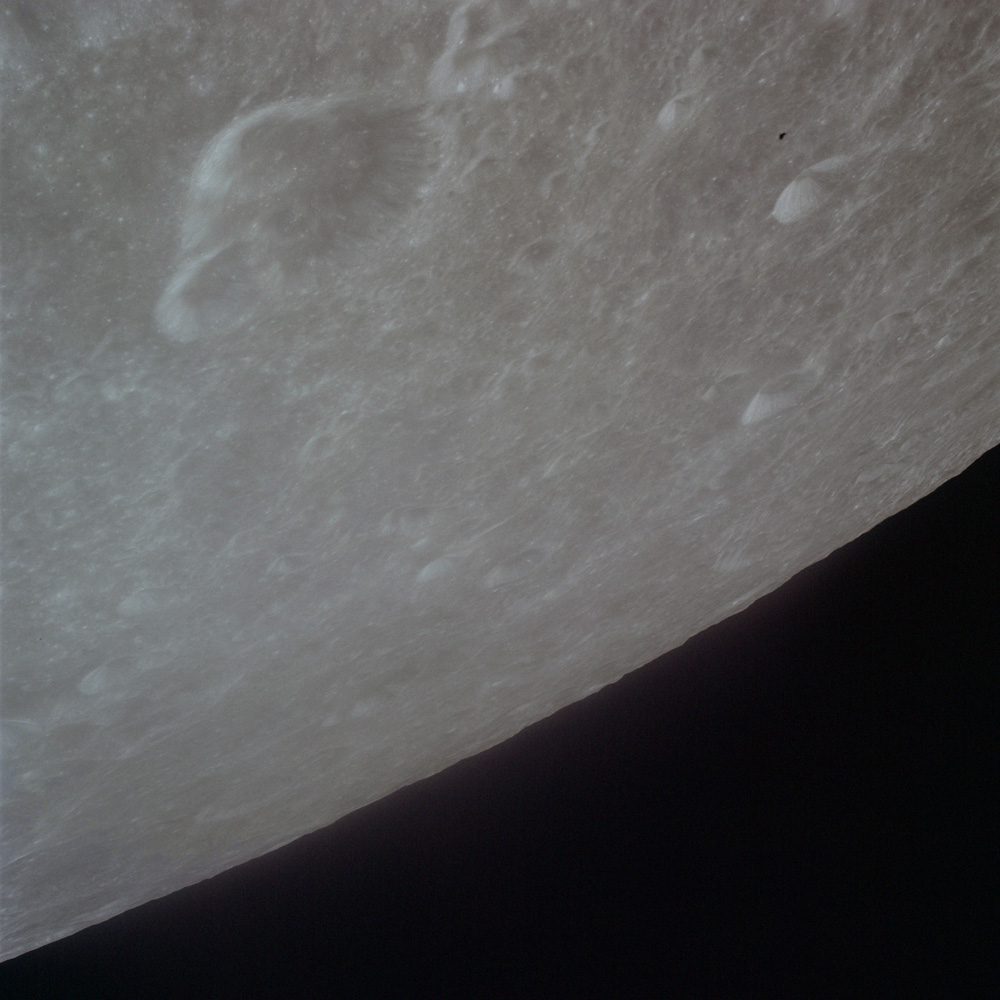
AS17-151-23163 - Chaplygin Y upper left - JSC scan
091:05:43 Cernan: Oh, there's the Star Chaplygin, Ron. See it? Out here?
091:XX:XX Evans: I - I don't see it yet, but...
091:XX:XX Cernan: Yes. Oh, it's beautiful! Right on the - right on the - on the northern - Ron, let me get my [garble]...
091:XX:XX Evans: Oh, yes.
091:XX:XX Cernan: See it?
091:XX:XX Evans: Okay, I see it coming up there.
091:XX:XX Cernan: Oh, man, beautiful.
091:XX:XX Evans: That's Chaplygin?
091:XX:XX Cernan: Yes, that's Chaplygin.
091:XX:XX Evans: Oh, okay. The star Chaplygin, okay, is on the north...
091:XX:XX Cernan: Yes, it's on the north of whatever it is.
091:XX:XX Evans: ...Yes, northeast corner. Whatever.
091:XX:XX Cernan: We're on the back side looking the other way on that...
091:XX:XX Evans: Oh, shoot. I don't see the [garble] yet.
091:06:16 Cernan: Man, the Star looks - is just a very dense white halo within about a - looks like a half a crater diameter. And inside, you can see very dark masses streaked by very light masses in a - in a radial downward direction.
091:XX:XX Evans: Yes.
091:XX:XX Cernan: It looks like the majority of that - of that ejecta may have gotten diluted as it rolled down the slopes of Chaplygin. I didn't give you f/11 yet, did I? You can go there if you're not.
091:XX:XX Evans: No. We aren't missing anything [garble]...
091:XX:XX Cernan: Are you f/11?
091:XX:XX Evans: ...SIM bay, are we?
091:XX:XX Cernan: Pan Camera, Stop. Yes, wait - Oh, wait a minute. Let me get the time here. We're not there yet.
091:XX:XX Evans: About what time? When does it stop?
091:XX:XX Cernan: At 10:57.
091:XX:XX Evans: 10 - Oh, 07:17?
091:XX:XX Cernan: Yes, 10:57.
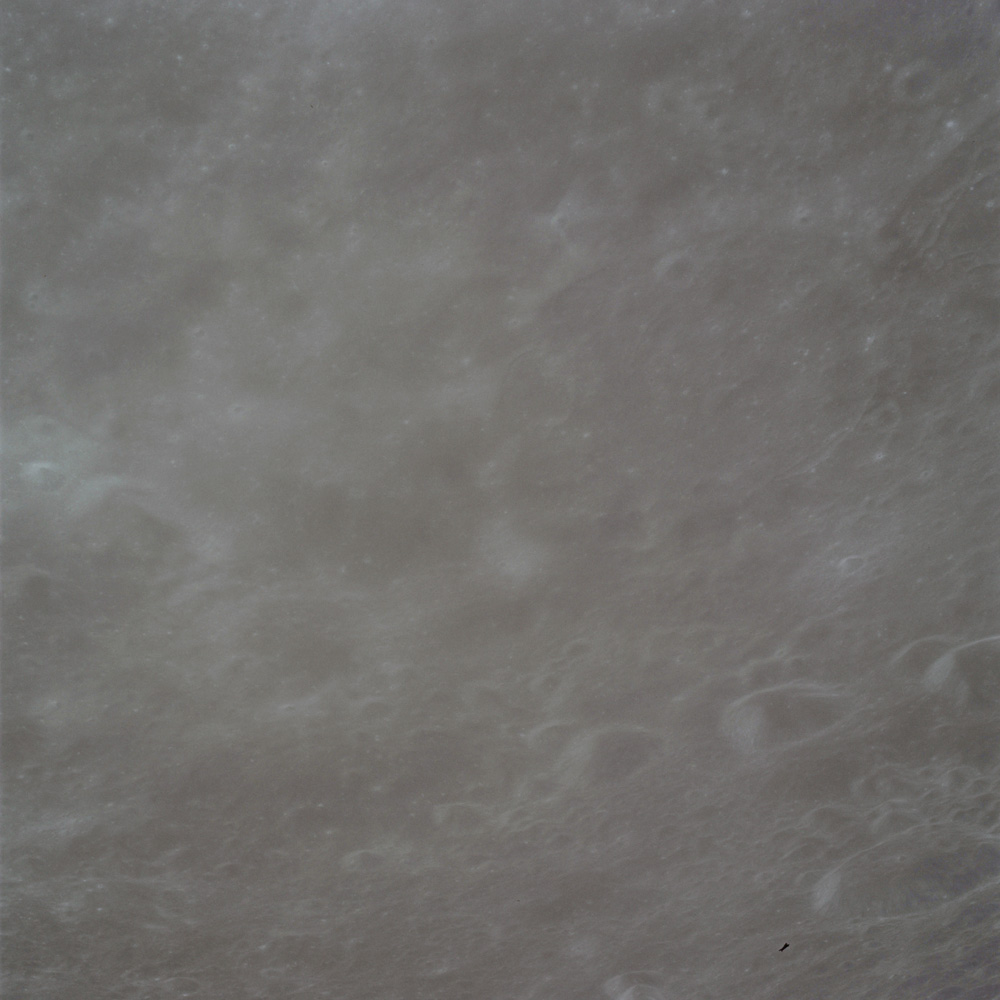
AS17-151-23164 - Crater Tamm is in the upper right quadrant of teh frame but is very indistinct in this high-angle lighting. Crater Van den Bos is cut off on the upper right - JSC scan
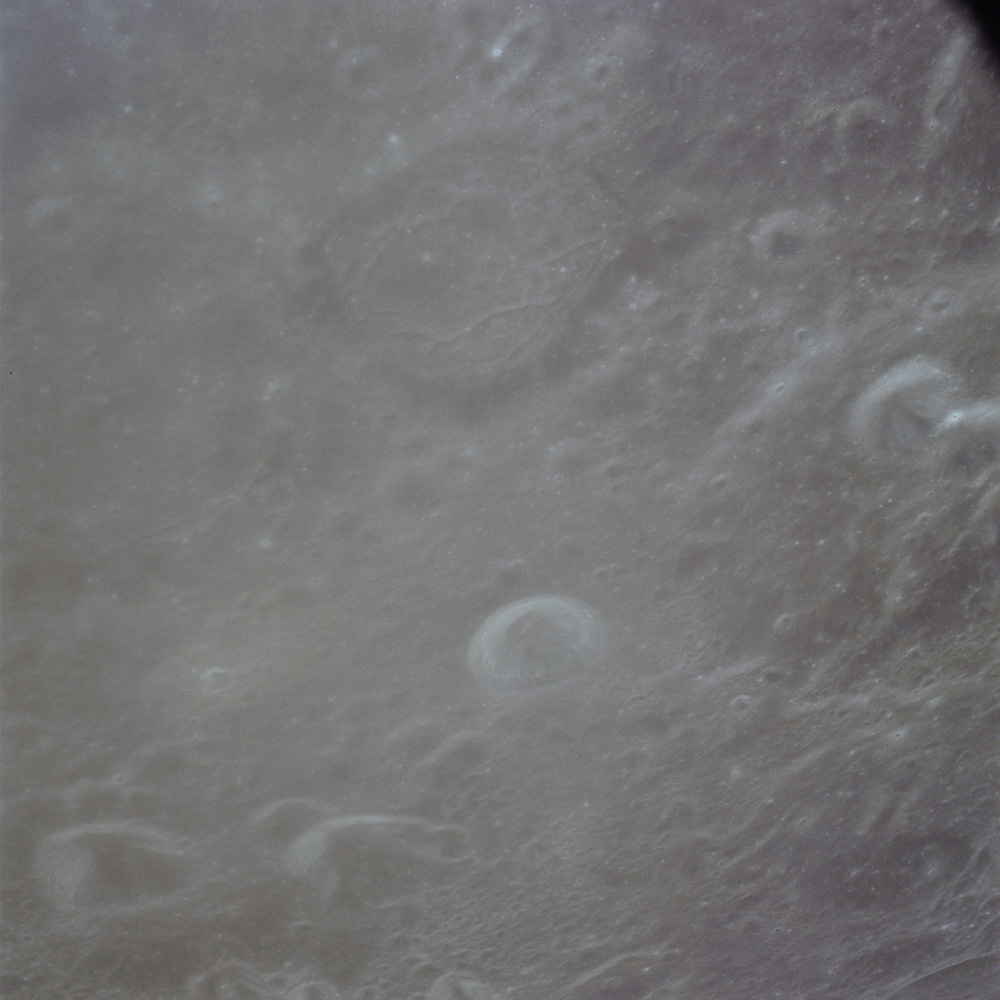
AS17-151-23165 - Crater Van den Bos is above centre. Crater Vil'ev is a large crater cut off on the right with two small craters in its interior. Vil'ev B is the small bright crater below centre - JSC scan
091:XX:XX Schmitt: Should be seeing Gagarin here off to the - south pretty soon.
091:XX:XX Evans: Yes, there's Gagarin. And...
091:XX:XX Cernan: Well, you can see to the south. See, I can't. I can't see to the south.
091:07:38 Schmitt: Okay. I can't see Gagarin, no. What's this, Chap - Chaplygin here - with the...
091:XX:XX Evans: Star Chaplygin.
091:XX:XX Schmitt: ...looking out...
091:XX:XX Cernan: Yes, right here. We're coming right over here with the small central peak and star on the north - upper right-hand corner. Look at the in - innards of that crater, Jack, of the star.
091:XX:XX Schmitt: Yes.
091:XX:XX Cernan: Sort of...
091:XX:XX Schmitt: I can't - I can't...
091:XX:XX Cernan: ...[garble] center ray.
091:XX:XX Schmitt: ...see it yet.
091:XX:XX Cernan: Huh?
091:08:05 Schmitt: I just lost it.
091:XX:XX Cernan: Did you?
091:XX:XX Schmitt: I didn't get a real good view of it.
091:XX:XX Cernan: The inside...
091:XX:XX Evans: Here, you can see it right out through here.
091:XX:XX Cernan: ...looks like it's very dark...
091:XX:XX Evans: See it [garble].
091:XX:XX Cernan: ...[garble] at the bottom, dominated by - by white up until about the upper 10 percent. And then on the interior of that upper 10 percent is black again. And as you come out over the top, the ejecta is all very light colored. Okay. We're right over Chaplygin.
091:XX:XX Cernan: Okay. At - what did I say - 10:57, you got 2 more minutes, Jack, on the Pan Camera.
091:XX:XX Schmitt: Okay.
091:XX:XX Evans: Don't I stop there at the lovelet? Doesn't look like the lovelet to me.
091:XX:XX Cernan: Star Chaplygin - I don't know what you're talking about. What lovelet?
091:XX:XX Evans: The next thing up there, there's a - there's a stop at...
091:XX:XX Cernan: Oh, right here?
091:XX:XX Evans: Yes.
091:XX:XX Cernan: It looks like a kidney?
091:XX:XX Evans: Yes.
091:XX:XX Cernan: Well, let me see if I can see it. Yes, that's where you stop - Oh, there it is.
091:XX:XX Evans: I don't see it yet, but...
091:XX:XX Cernan: Well, I do. It doesn't look like what you're thinking of. Looks like...
091:XX:XX Evans: Doesn't look like a lovelet to me, does it?
091:XX:XX Cernan: What's a lovelet?
091:09:10 Evans: Well, I thought it had some stuff on the crater floors, but I sure don't see it. Oh, there it is! Yes, I got it right here.
091:09:XX Cernan: Yes, okay.
091:09:XX Evans: See it?
091:09:XX Cernan: There's some very old subtle depressions that were craters that have got turtleback fill...
091:09:XX Evans: Yes, turtleback fills on it.
091:09:XX Cernan: ...which is very much; texturewise, except for the cracking, like the rest of the hummocky area. Okay. You got the lovelet?
091:09:XX Evans: Yes.
091:09:XX Cernan: Man, my neck is going to break.
091:09:XX Evans: Mine, too. That's [Laughter]...
091:09:XX Cernan: I think that's where you stop, isn't it?
091:09:XX Evans: That's where I stop, I think, isn't it?
091:09:45 Cernan: Jack, you got another minute on the Pan Camera.
091:XX:XX Schmitt: Okay. I got a clock going there. Yes. Yes, there seem to be - at least two crater-filling episodes, one of a very smooth material that seems to be older and more cratered. And then there's this turtleback and varieties of that that you see in isolated craters around the - along the track.
091:XX:XX Cernan: Jack, you want to get ready on that Pan Camera? Ron, are you done?
091:XX:XX Evans: Yes, I [garble]...
091:XX:XX Cernan: You want to record the frame number.
091:XX:XX Evans: Okay...
091:XX:XX Schmitt: Pan Camera.
091:XX:XX Cernan: Stand by. I'll give you a mark.
091:XX:XX Schmitt: Yes, to what? To...
091:XX:XX Cernan: You - you'll want it to standby.
091:XX:XX Schmitt: Okay.
091:XX:XX Cernan: Thirty seconds.
091:XX:XX Schmitt: All right.
091:XX:XX Cernan: Let's see, what am I - What's this huge basin I'm looking at right here to the north?
091:XX:XX Evans: That should be Becvar.
091:XX:XX Cernan: That's this basin here. What the heck is that?
091:XX:XX Schmitt: That it, Gene?
091:XX:XX Cernan: Mendeleev, isn't it?
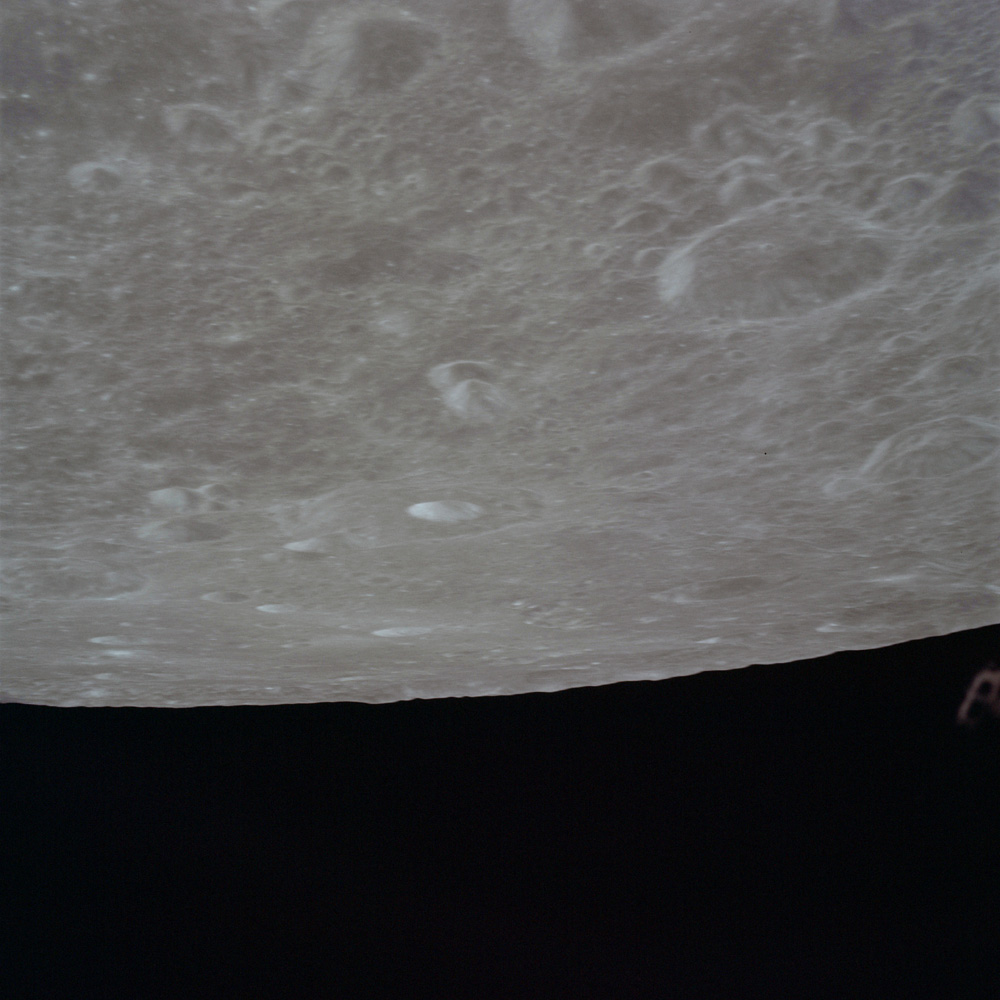
AS17-151-23166 - View north with large walled plain Mendeleev stretching to the horizon. The indistinct crater centre of frame with a bright interior crater is Schuster Q. Pannekoek D is the crater at the upper right - JSC scan
091:XX:XX Schmitt: Gene?
091:XX:XX Cernan: Stand by...
091:10:58 Cernan: Mark it.
091:XX:XX Schmitt: Okay.
091:XX:XX Cernan: Right on time. Okay. V/H to High Altitude.
091:11:05 Schmitt: Okay. It's going to High.
091:XX:XX Cernan: Next thing, in 5 minutes is the laser altimeter.
091:XX:XX Schmitt: What are we going to do with it?
091:XX:XX Cernan: We're going to turn it off, and then we're going to - turn - retrack the mapping camera and close some covers.
091:XX:XX Schmitt: Okay.
091:XX:XX Cernan: That was the Pan Camera you went to Standby on?
091:XX:XX Schmitt: Yes, sir.
091:XX:XX Cernan: Okay. What is this? Mendeleev, isn't it?
091:XX:XX Schmitt: I believe [garble] - You should recognize it by having that long linear...
091:XX:XX Cernan: Yes, but I can't see it now.
091:XX:XX Schmitt: ...crater chain.
091:XX:XX Cernan: Oh, there it comes across. Yes, I'll...
091:XX:XX Schmitt: Yes. That's it.
091:XX:XX Cernan: ...be able to see it when I get...
091:XX:XX Schmitt: Yes.
091:XX:XX Cernan: ...in line with it. That's it. It's got the - sort of an off-center, traveling central peak.
091:XX:XX Cernan: Yes, that crater chain - what - goes almost north and south.
091:XX:XX Schmitt: Yes, very linear.
091:XX:XX Cernan: And, boy, is that...
091:XX:XX Schmitt: Extremely linear.
091:XX:XX Cernan: ...is that pronounced.
091:XX:XX Cernan: I wonder if the Rover would get up those walls? I doubt it. There's some breaches, though, in those walls that the Rover could get through.
091:XX:XX Schmitt: Yes.
091:XX:XX Cernan: But I'll bet they look much bigger when you get down there.
091:XX:XX Schmitt: They're not nearly as smooth a floor as Korolev seemed to have in detail. Seems to have not only more craters but more hummocks.
091:12:36 Cernan: We're right here, Ron.
091:XX:XX Evans: Yes, I know. Right here.
091:XX:XX Cernan: [Garble] through there.
091:XX:XX Evans: Okay. The next thing is...
091:XX:XX Schmitt: I got a clock going on that altimeter.
091:XX:XX Evans: Okay. Laser Altimeter goes Off at 16.
091:XX:XX Schmitt: And there was a possibility of an east-west ridge...
091:XX:XX Evans: Where is Mendeleev?
091:XX:XX Schmitt: Mendeleev...
091:XX:XX Cernan: Right here, Ron.
091:XX:XX Evans: I don't see it.
091:XX:XX Cernan: Right here.
091:XX:XX Evans: Not at this Sun angle. I don't see it yet. Okay.
091:XX:XX Cernan: Right here. It's this way.
091:XX:XX Evans: There?
091:XX:XX Cernan: Yes. This way.
091:13:10 Evans: We're supposed to have those big - Oh, there it goes. Yes, out over here. Yes. Okay. There it goes. Boy, I tell you, it sure helps to have...
091:13:XX Cernan: And the next two craters we're coming over are Hartmann and Green. Green has got that nice symmetrical central peak with the sloped sides, and Hartmann has got a sort of hummocky turtleback. You don't see the cracks...
091:13:XX Evans: Yes.
091:13:XX Cernan: ...but you see the blisters in its...
091:13:XX Evans: That's Hartmann, okay.
091:13:XX Cernan: ...that's Hartmann, and you see the blisters in it's floor, and you really don't see the sloping either.
091:13:38 Evans: Yes, what's that one that has the slumping down there south of - of Green?
091:XX:XX Cernan: Green? South? Right here?
091:XX:XX Evans: Yes.
091:XX:XX Cernan: Look - looks like the bottom has been boiled up?
091:XX:XX Evans: Yes, looks like...
091:XX:XX Cernan: Like the whole side - freshly slumped...
091:XX:XX Evans: Yes.
091:XX:XX Cernan: ...and the bottom is boiling molasses or something?
091:XX:XX Evans: Right.
091:XX:XX Cernan: That's nothing. I can't - I don't have it on this chart.
091:XX:XX Evans: That's [garble] up there, huh?
091:XX:XX Cernan: But it's right under the number 13 where it says rev 13.
091:XX:XX Evans: Yes.
091:14:04 Cernan: This is where you get your back sore.
091:XX:XX Evans: Yes, yes, it is!
091:XX:XX Schmitt: Man, you're right [laughter].
091:XX:XX Evans: It's like - like Anders said, this is a heck of a...
091:XX:XX Schmitt: Okay, this - I...
091:XX:XX Evans: ...proposition, by the way.
091:XX:XX Schmitt: ...don't know which one it is, but one of those to the right - Oh, we're just about over it right not - maybe just a little north of our track - is generally bright walled, although the southwest wall not only hem an arcuate slump cut apparently, but it's darker, and it's darker not only in the inner wall but it's also in the ejecta blanket outward. You see that, Ron?
091:XX:XX Evans: Yes, it is. It's darker on the ejecta and the blanket going back toward - to the east.
091:XX:XX Schmitt: Yes. Yes. Is that east...
091:XX:XX Evans: Yes.
091:XX:XX Schmitt: ...or west? Is it?
091:XX:XX Evans: Well, we're going east. We're...
091:XX:XX Schmitt: We're going west.
091:XX:XX Evans: Okay.
091:XX:XX Schmitt: Okay; yes, east. I'm sorry; southeast.
091:XX:XX Cernan: Hey, do you see that one where you see very steep fresh walls way out there, Almost on the horizon? Oh, we're going over a big long...
091:XX:XX Evans: Yes, we...
091:15:04 Cernan: What is that? Do you have any idea? Big long chain?
091:XX:XX Schmitt: Yes, we're going over...
091:XX:XX Cernan: ...crater chain. Not that one. And in this case it is...
091:XX:XX Schmitt: Look at that.
091:XX:XX Cernan: ...made up of cone-shaped...
091:XX:XX Schmitt: I would say it might be...
091:XX:XX Cernan: ...craters that are...
091:XX:XX Schmitt: ...en eschelon with apparent right laterals.
091:XX:XX Cernan: ...[garble] I thought at [garble] you were supposed to go to the horizon.
091:XX:XX Schmitt: It's trending north-south...
091:XX:XX Cernan: Ron ?
091:XX:XX Evans: What?
091:XX:XX Cernan: Thought you were supposed to go to the horizon.
091:XX:XX Schmitt: ...at the northwest-southeast...
091:XX:XX Evans: No, [garble] doesn't.
091:XX:XX Schmitt: ...and the spoon is consistently to the south.
091:XX:XX Cernan: Here's King coming up.
091:XX:XX Evans: Where? I'd like to take a look at that.
091:XX:XX Cernan: I got a good view of what's in front of us right by the LM. Here, you can - you - Take a look at King from this angle, Eon. Get back here to the...
091:XX:XX Evans: I can see the...
091:XX:XX Cernan: ...Look right along the LM - LM tanks. See it?
091:XX:XX Evans: Oh, okay. It's just now coming up. Okay.
091:XX:XX Cernan: Yes.
091:XX:XX Evans: With the Y central peak on it.
091:XX:XX Cernan: Yes.
091:XX:XX Evans: Okay, okay. Okay, I don't...
091:XX:XX Cernan: I'll give you a hack when you ought to be able to pick that out. It's got - Yes, it's got a - a varied central peak...
091:16:12 Evans: Yes, it's a Y-shaped central peak is the [garble]...
091:16:XX Cernan: Okay. It is. And the Y is pointing up to the - What ? Northwest.
091:16:XX Evans: Okay. There's 16. That's Laser Altimeter, Off, and Mapping Camera to Retract.
091:16:27 Schmitt: Okay. Laser Altimeter is Off and going just to Retract...
091:16:XX Evans: Retract on the Mapping...
091:16:32 Schmitt: Okay. Barber pole.
091:16:XX Evans: Okay. Let me...
091:16:XX Schmitt: Couple minutes and we'll look at it.
091:16:XX Evans: Okay, and then IR Cover to Close.
091:16:41 Schmitt: IR to Close.
091:16:XX Evans: UV to - UV Cover, Closed?
091:16:49 Schmitt: IR is Closed...
091:16:XX Cernan: The ray...
091:16:52 Schmitt: ...UV is Closed.
091:XX:XX Cernan: The ray's from Giordano Bruno...
091:XX:XX Evans: Okay, and I got [garble].
091:XX:XX Cernan: ...that seem to breach King...
091:XX:XX Schmitt: What else, Ron?
091:17:00 Evans: Pan Camera to Operate at 18:05. It's 17:05 now. Coming down.
091:17:XX Cernan: I can't really see where the ray emanates from, but it's very obvious to me that there's not only an albedo change as you approach King in the direction of that ray - or from the direction of that ray, which, by the way, is into the opening of the Y in the central peak, but that ss you hit the rim, there is a definite...
091:17:XX Evans: Okay. There's going to be a [garble]...
091:17:XX Cernan: ...wide area of albedo change to a lighter color. And in the center...
091:17:XX Evans: ...I mean I was looking at the [garble]...
091:17:XX Cernan: ...of this light color down the slump slopes...
091:17:XX Evans: Have you retracted yet?
091:17:XX Cernan: ...of King, you have a very - well, not a [garble] but a darker - much darker area.
091:17:XX Schmitt: No.
091:17:XX Cernan: What do you want, Ron.
091:17:XX Evans: [Garble] 15, when the mapping camera retracts.
091:17:XX Schmitt: What shall I do? Turn it off?
091:17:42 Evans: No, no, just leave it there, but I'd just like to know when it is.
091:XX:XX Cernan: And on the ray from Giordano Bruno...
091:XX:XX Evans: How long it takes.
091:XX:XX Cernan: ...you have sort of a smooth-type surface...
091:XX:XX Evans: [Garble] before.
091:XX:XX Cernan: ...Looks like it's much dustier, if you will, in that direction as it approaches King than the...
091:XX:XX Evans: Okay; 5 - 5 seconds to Pan Camera...
091:XX:XX Cernan: ...area outside the ray.
091:XX:XX Evans: ...Operate. Okay. Pan Camera to Operate now.
091:18:09 Schmitt: Mark. It's operating.
091:XX:XX Evans: It started at 09. That's at [garble]...
091:XX:XX Cernan: And as you look up the horizon from King out that ray, you get a...
091:XX:XX Evans: It's a minute and 45 right about now.
091:XX:XX Cernan: ...[garble] hint of a - this continuous, darker...
091:XX:XX Evans: [Garble] set it over [garble]...
091:XX:XX Cernan: ...surface within the ray geometry.
091:XX:XX Schmitt: Now what?
091:XX:XX Evans: Okay. Pan Camera to Standby at 27 is the next thing for you. 27:43.
091:XX:XX Schmitt: Okay.
091:XX:XX Cernan: It seems to go...
091:XX:XX Schmitt: Nine minutes.
091:XX:XX Evans: Okay. You can enable jets A-4.
091:XX:XX Schmitt: Okay.
091:XX:XX Cernan: Oh, man, you got to look at that - at that - that - that albedo change, almost like a flow coming down the walls of - What is it? Guyot?
091:XX:XX Evans: Guyot. Yes.
091:XX:XX Cernan: Guyot? Right at us. Do you see it?
091:XX:XX Evans: And they're - straight down here, is it?
091:XX:XX Cernan: Yes, you see Guyot?
091:XX:XX Evans: Yes.
091:XX:XX Cernan: But you see that albedo change?
091:XX:XX Evans: Oh, that's - that's - okay. That's Lobachevsky on over there.
091:XX:XX Cernan: No. No.
091:XX:XX Evans: Yes, it is.
091:XX:XX Cernan: Not what I'm looking at.
091:XX:XX Evans: The one looking straight ahead there.
091:XX:XX Cernan: No, I'm looking over here. I'm looking right over here.
091:XX:XX Schmitt: Okay. Here's our sandy, light gray rims.
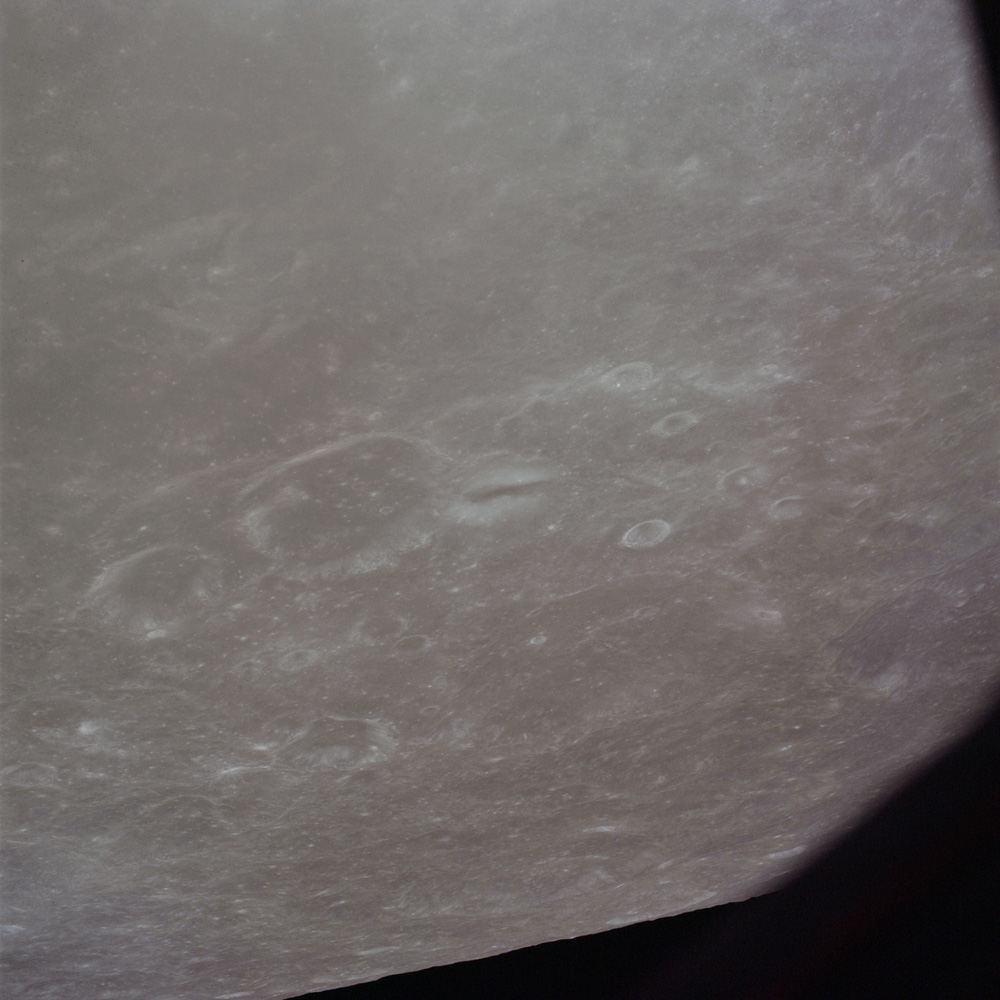
AS17-151-23167 - View southwest to terrain south of Firsov. Buisson Y is centre of frame with Buisson X the larger crater left of centre - JSC scan
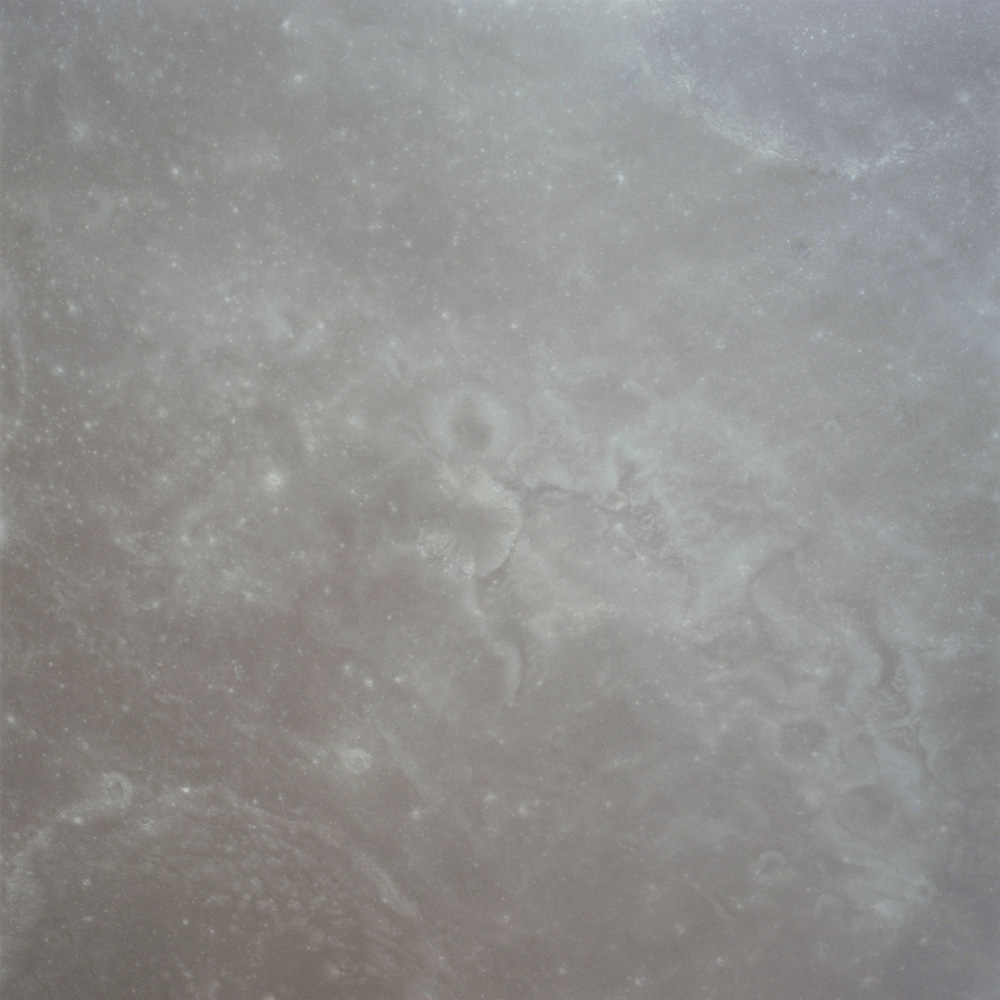
AS17-151-23168 - Terrain between Firsov (cut off bottom left) and Katchalsky (cut off top right) - JSC scan
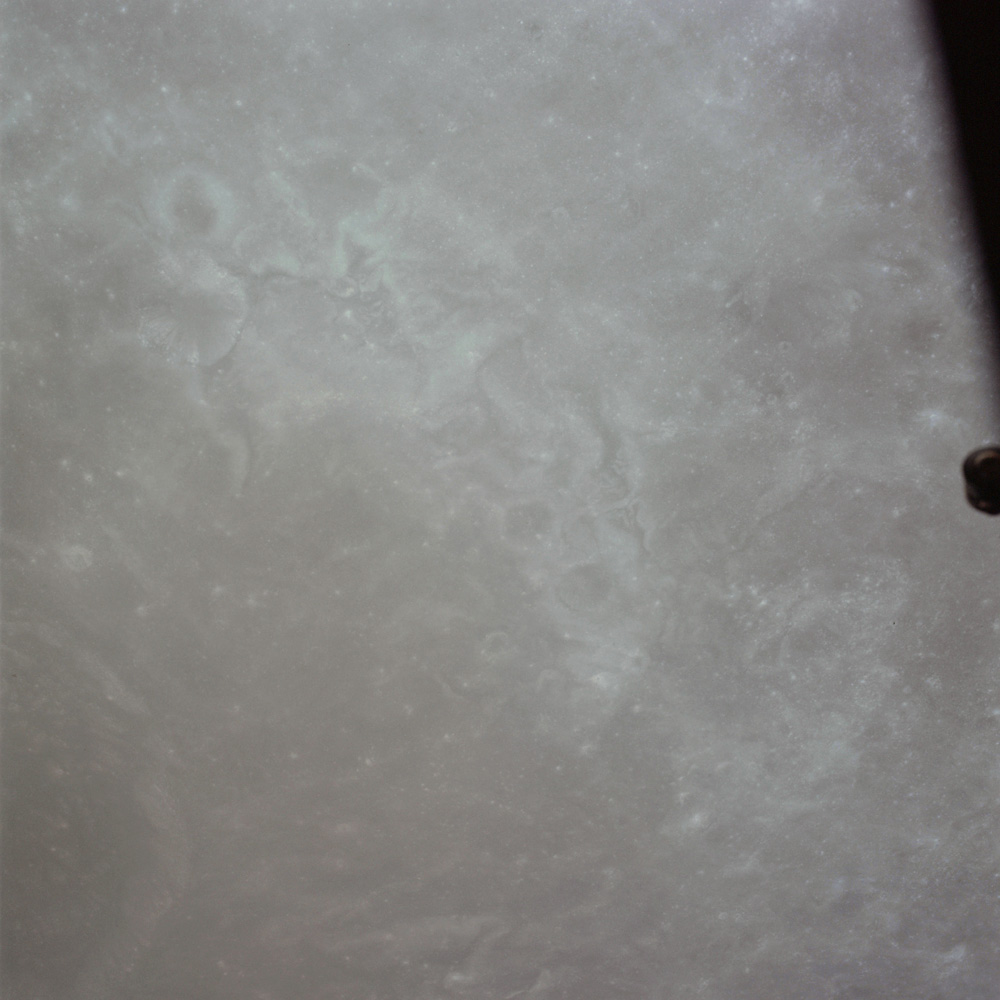
AS17-151-23169 - Terrain between Firsov (cut off bottom left) and Katchalsky - JSC scan
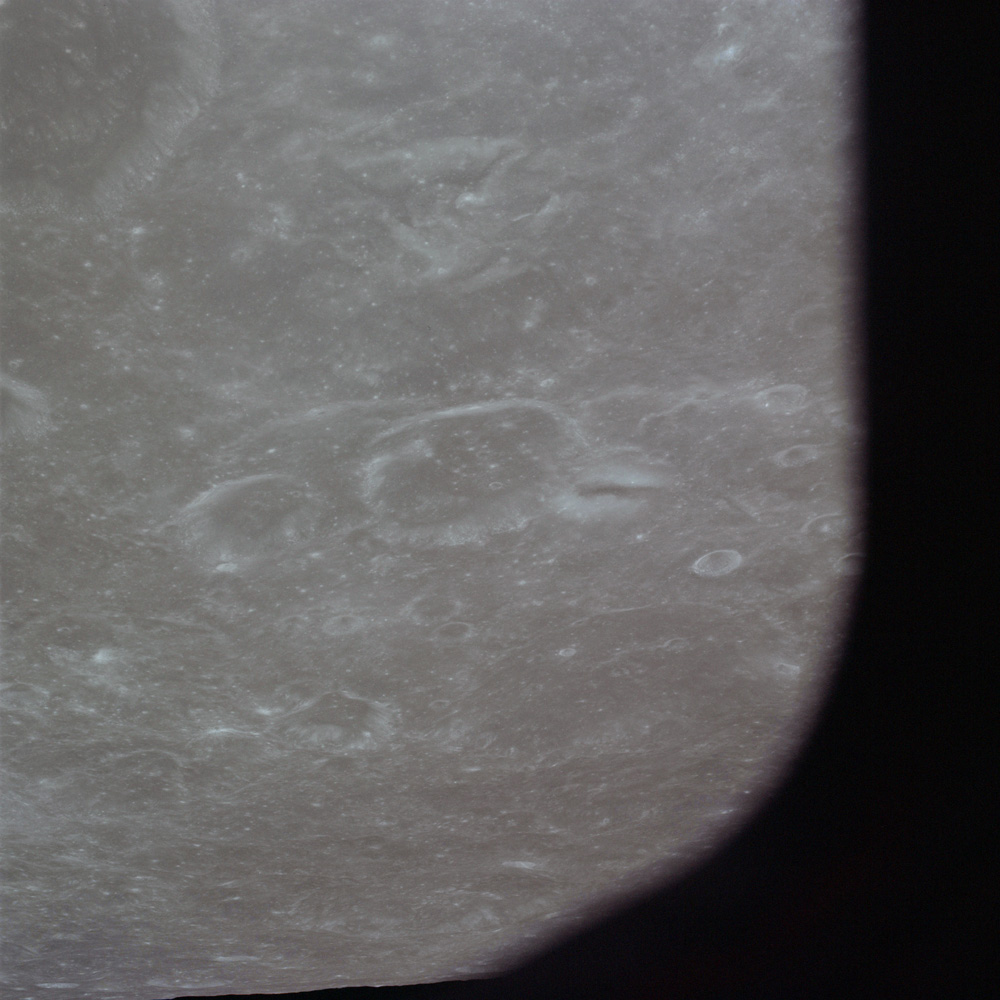
AS17-151-23170 - View southwest to terrain south of Firsov. Buisson X is larger crater centre of frame with Buisson Y to its right - JSC scan
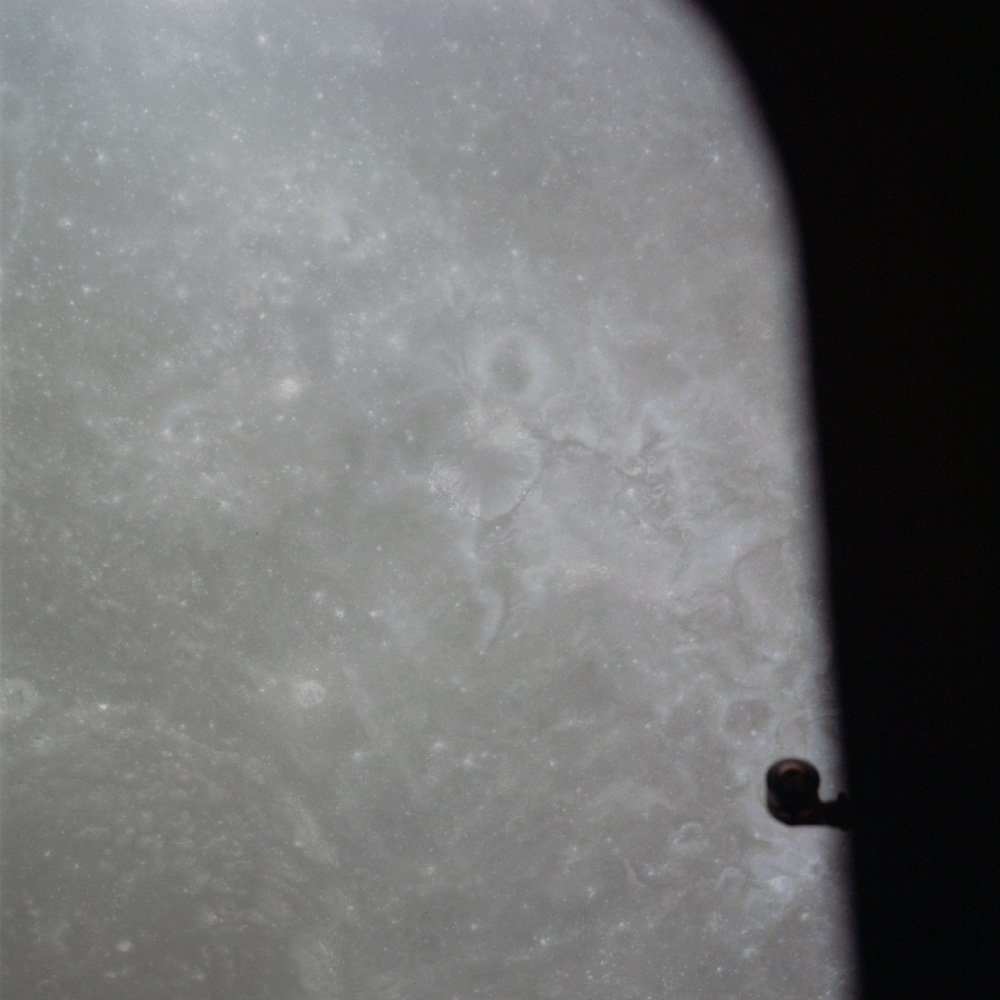
AS17-151-23171 - Terrain between Firsov (cut off bottom left) and Katchalsky - JSC scan
091:XX:XX Cernan: Okay. What do you want on these - on the...
091:XX:XX Evans: Okay. Enable A-4.
091:19:29 Cernan: I can't find A-4. My eyeballs are shot. A-4, enabled.
091:19:XX Evans: C-3.
091:19:XX Schmitt: Can I use that camera at all?
091:19:XX Cernan: C-3?
091:19:XX Evans: And B-4.
091:19:XX Cernan: B-4?
091:19:XX Evans: Yes, you can use it.
091:19:XX Cernan: And what?
091:19:XX Evans: And D-3.
091:19:XX Cernan: Okay. What do you want disabled?
091:19:XX Evans: Disable jets A-1 and C-2.
091:19:45 Cernan: A-1 and C-2, okay. A/C Roll is Off.
091:XX:XX Evans: And enable Jet C-1. Enable C-1.
091:XX:XX Cernan: C-1.
091:XX:XX Evans: Okay.
091:XX:XX Cernan: Okay. You got all your roll jets off except C-1.
091:XX:XX Evans: Yes, I know. I know.
091:XX:XX Cernan: This is a [garble]...
091:XX:XX Evans: Which is a minus roll. Okay. Enable B-2 and D-2.
091:XX:XX Cernan: Enable B-2?
091:XX:XX Evans: Yes, Bravo 2 and Delta 2.
091:XX:XX Cernan: Okay.
091:XX:XX Evans: And that's in case we get off attitude.
091:XX:XX Cernan: Okay.
091:XX:XX Evans: Now, get me a Verb 6 - 62 on...
091:XX:XX Cernan: Are we subsolar yet?
091:XX:XX Evans: ...[garble] to [garble] pretty clever.
091:XX:XX Schmitt: Did you pick up the rest of this stuff in the Flight Plan?
091:XX:XX Evans: Yes, we got everything. Yes, substellar - subsolar's about now.
091:XX:XX Cernan: Okay.
091:20:31 Cernan: Okay, Ron. Now we're coming over Lobachevsky, right now. Right here.
091:XX:XX Evans: Yes.
091:XX:XX Cernan: I - I was looking at Guyot.
091:XX:XX Evans: That's mag 00, frame something or other - whenever you get through there.
091:XX:XX Cernan: Guyot.
091:XX:XX Evans: Acquire MSFN in Omni D. Okay. We'll [garble] Let me know when you're through taking pictures there.
091:XX:XX Schmitt: Okay.
091:XX:XX Schmitt: What frame?
091:21:08 Schmitt: Frame 66. That's a really strange - those are very light gray areas that are around the rims of craters. Looks like it might be related to that swirl.
091:XX:XX Cernan: Boy, that looks - You know, where you see some of these slumped areas where it looks like there's an albedo change over the rim of the crater, so many places you see a - what appears to be a small but massive - looking black area like right here on - on Lobachevsky.
091:XX:XX Schmitt: There's just - just black fill rolling over the slope of the...
091:XX:XX Evans: Did you get that [garble] of Lobachevsky?
091:XX:XX Schmitt: ...wall of the crater. Yes. I wouldn't be surprised if that's all glass, Geno.
091:XX:XX Cernan: Might very well be.
091:XX:XX Schmitt: Because craters that have big ray patterns - they also generate a lot more glass than usual. These higher energy impacts.
091:XX:XX Cernan: Okay, are we about...
091:XX:XX Schmitt: Frame 67 was Lobachevsky on mag OO.
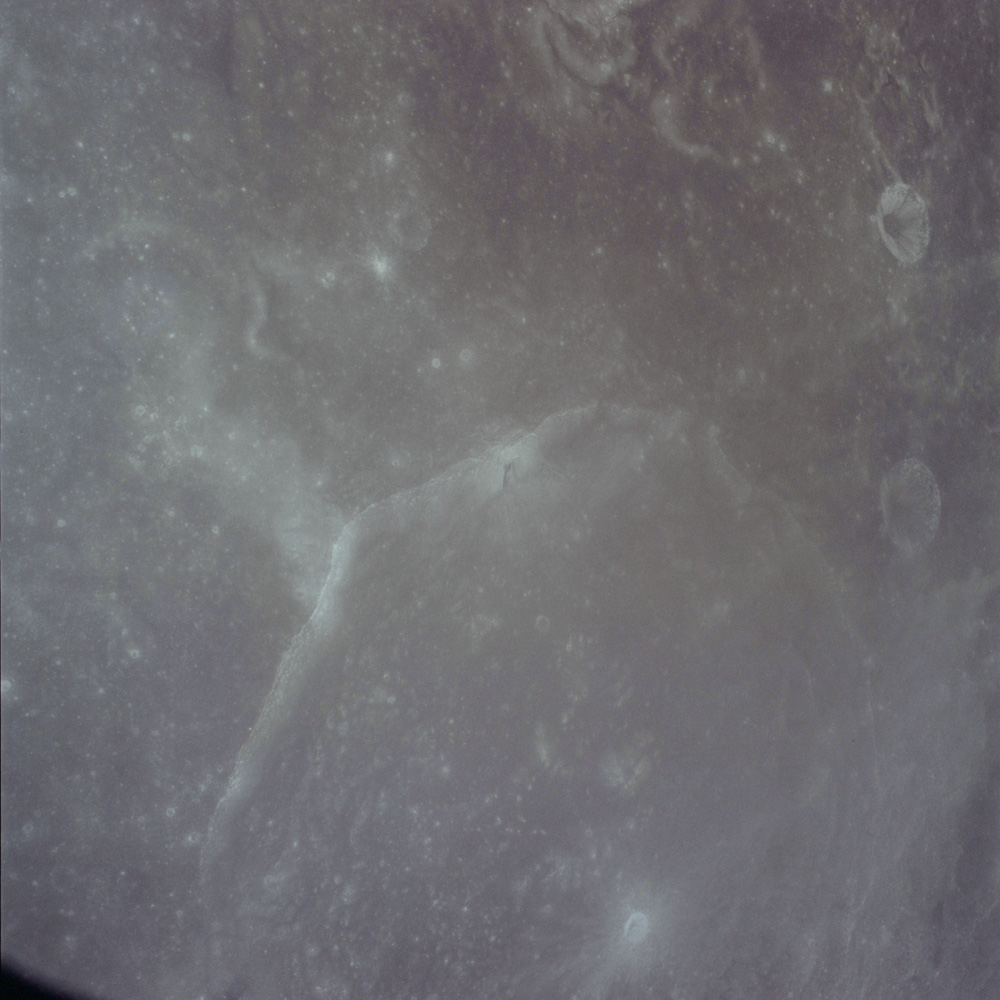
AS17-151-23172 - Western side of Lobachevsky. Note in the centre of the frame, the dark rock slide down the inside wall of the crater - JSC scan
091:XX:XX Cernan: Oh, let's see. AOS is at 24. [Garble] What do they want? Did we get all this, Ron?
091:XX:XX Evans: Yes, I got that.
091:XX:XX Cernan: Disable A/C...
091:XX:XX Evans: Okay. I got - got 10 degrees out here. Let me give us a call.
091:22:37 Evans: Mapping Camera, Retract. The talkback was gray.
091:XX:XX Cernan: Have we got everything done?
091:XX:XX Evans: Got everything done as far as...
091:XX:XX Cernan: You get all these things here?
091:XX:XX Evans: Yes, we did that.
091:XX:XX Cernan: You get the T-start again?
091:XX:XX Evans: Yes.
091:XX:XX Cernan: Okay.
091:XX:XX Evans: T-start is 18:07 or so. That's good.
091:XX:XX Cernan: Okay. Did you get the Mapping Camera, Retract, and everything?
091:XX:XX Evans: Yes, I did.
091:XX:XX Cernan: Okay. This is all done. Omni Delta then?
091:23:09 Evans: Okay. We're in Omni Delta.
091:XX:XX Cernan: 27:43, we want to stop the pan camera again.
091:XX:XX Cernan: There's a [garble] one down there.
091:XX:XX Schmitt: Some of that dark stuff just looks like blocks.
091:XX:XX Evans: Yes. Think I can finally - Look it, this thing's upside down. [Laughter.]
091:XX:XX Cernan: Well, you got to know which way you're going and which way you're pointing. That's the big problem.
091:XX:XX Spacecraft: [Cough].
091:XX:XX Cernan: I got the feeling that someone's brought a big powder puff and powdered the whole back side, because...
091:XX:XX Evans: [Garble] water.
091:23:40 - This is Apollo Control at 91 hours, 23 minutes. We're 23 seconds away from acquiring Apollo 17 on it's second revolution of the Moon. During this pass, we will send up a DOI-1 PAD. That's instructions to the crew for the Descent Orbit Insertion maneuver. We should be acquiring any time now. We'll stand by for the first call.
091:XX:XX Schmitt: Here's one - here's one off to the south that has - has three albedo contrasts. Looks very much like what you just described except it has one more - one more in there...
091:24:34 Evans: Okay, Houston. We're with you in Omni Delta.
091:24:38 Schmitt: ...that is much darker than the others...
091:24:42 Overmyer: Roger, Ron. Read you loud and clear.
091:24:48 Cernan: Okay, Robert. We should have gotten everything right on up through AOS here in the Flight Plan.
091:24:57 Overmyer: Good show.
091:25:01 Cernan: And the pan camera should be running right now. [Long pause.]
091:25:28 Evans: Okay, Houston. America here. We stopped the orbital photo path, frame 59. And at about the sub-stellar point, we took 59 to 66, and frame 67 was taken of the, oh, the dark slide on the corner of Lobachevsky.
091:25:57 Overmyer: Roger, America. [Long pause.]
091:26:34 Schmitt: Those frames that Ron mentioned - this is Jack - that he mentioned were taken of a area where there's a much lighter gray albedo. Rather than the tannish gray, it's pure gray material that generally is on the rim crest of a number of craters. It may be related to the swirls that we see elsewhere.
091:27:05 Overmyer: Roger, Jack. [Long pause.]
091:27:56 Schmitt: Bob, we're abeam of Al-Biruni and coming up on Goddard and [Mare] Marginis right now.
091:28:08 Overmyer: Roger, America. We're tracking you on the map here, watching it.
091:28:14 Schmitt: Okay. [Pause.]
091:28:24 Schmitt: Al-Biruni has got a - a variation in the - its floor, variations in albedo. It almost looks like a pattern as if water were flowing on a beach. It's that irregular. Not in great areas, but in small areas around on the southern side, and the part that looks like it's a water-washing pattern is of a much lighter albedo, although I cannot see any real source for it. The texture, however, looks about the same.
091:28:56 Overmyer: Roger, Jack. [Long pause.]
091:29:26 Evans: And Houston, America. For your info, it took an hour - an hour [laughter] - a minute and 45 seconds for the map - your mapping camera to extend and a minute and 45 for it to retract.
091:29:39 Overmyer: Roger, Ron. Copy. 1:45, extend and retract.
091:29:52 Cernan: Bob, what's our altitude now?
091:29:57 Overmyer: Looks like you're crossing - you're just about 90 [nautical] miles, but we'll firm that up here, Gene. You're 90.8...
091:30:06 Overmyer: ...America.
091:30:10 Cernan: Okay; thank you. [Pause.]
091:30:18 Schmitt: Bob, this is Jack. And the question of these irregular swirls that we've got in Mare Marginis, and we are looking just north of Nep - Neper now. I tell you, in the mare, there just is no visible relief. Although there seem to be some sinuous systematics anyway to the distribution. Like, there'll be a very dark area associated with the light area. And that dark area is darker than the mare. I think the pictures will show that. Now, in the highlands, however, the - the light albedo areas, which are very comparable, that appear to be swirl-like patterns of the same type, seem to be associated with a crest of crater ridges and other high points. We're on over - right over a concentration of these now in the northern part of Marginis, where the rule of a - of the light areas being associated with a - either - either symmetrically around a much darker area than the normal mare, or on one side, and in this case, generally the south side - of a dark area is - that rule is very clear. And that also seemed to hold in the back side that there was a slightly darker region between areas of light-colored swirls.
091:32:42 Overmyer: Roger, Jack. We understand, and we're standing by. We have a DOI PAD and some other updates.
091:32:51 Schmitt: Okay. We'll go back to work. [Long pause.]
091:33:21 Overmyer: America, Houston. We'd like Pan Camera, Off.
091:33:31 Cernan: You're reading our minds, Bob.
091:33:32 Schmitt: It's Off.
091:33:34 Overmyer: Roger.
091:33:34 Cernan: It's off.
091:33:35 Overmyer: Pan Camera'S Off, and we'd like Accept. We've got the DOI target load, the CSM state vector, PIPA - and an SPS tailoff constant.
091:33:49 Cernan: Okay; you've got Accept, Bob.
091:33:51 Overmyer: Roger, Gene. And there will be no PIPA bias.
091:33:56 Cernan: Okay. [Long pause.]
091:34:47 Schmitt: Bob, I can start with that PAD if you want to.
091:34:50 Overmyer: Roger. We're standing by. I'll start with DOI-1. Are you ready to copy?
091:34:59 Schmitt: Go ahead.
091:35:00 Overmyer: Purpose: DOI-1, SPS/G&N; 40035; plus 1.90, minus 0.64; 093:11:36.60. Noun 81s; minus 01916, all balls for Delta-V
Y, Delta-V
Z is plus 0047.8; 000, 228, 000; 0058.9, plus 0014.5; 0197.4, 0:22, 0192.1; sextant star is 45, 187.5, 19.1. Let me say trunnion again; it's 19.1. The rest of the PAD is not applicable. Set stars will be Sirius and Rigel; 133, 200, 030. Four jet, 15 second on the ullage. Other comments: overburn limits, Delta-V 17 - seventeen feet per second; burn time, 2 seconds. Over.
091:37:11 Schmitt: Okay, Bob. Ready for a readback. DOI-1, SPS/G&N; 40035; plus 1.90, minus 0.64; 093:11:36.60; minus 01916, all zeros, plus 0047.8; all zeros, 228, all zeros; 0058.9, plus 0014.5; 0197.4, 0:22, 0192.1; 45, 187.5, 19.1. Rest of PAD is NA. Sirius and Rigel; 133, 200, 030. Four jets, 15 seconds ullage - Overburn limits: Delta-V 7 - 17 feet per second; burn time, 2 seconds.
091:38:14 Overmyer: Roger, Jack. Good readback. Okay; I've got a map update for - at 93:38 in the Flight Plan.
091:38:33 Evans: Okay; go ahead. I have it.
091:38:35 Overmyer: Okay, Ron. AOS without burn, 93:31:37; with burn is 34:24. Over.
091:38:52 Evans: Okay. Without, 93:31:37; with burn is 34:24.
091:38:58 Overmyer: Roger, Ron. I've got a - You can go back to Block, Ron. And on that same page with the J-3, I've got the T-horizon and TCA.
091:39:17 Evans: Okay; ready to copy. Go ahead.
091:39:19 Overmyer: Okay. You can go to Block on the computer. T-horizon time 93:48:04; TCA minus 20 is 93:50:44. Over.
091:39:41 Evans: Okay. T-horizon, 93:48:04; TCA minus 20 is 50:44.
091:39:48 Overmyer: Roger. Good readback.
091:39:51 Overmyer: Okay, Ron. Over at 93:52, 93:52, we've got a difference in the Noun 89 value.
091:40:04 Evans: Okay; go ahead.
091:40:05 Overmyer: Okay. the Noun 89s have changed to the following: Noun 89, the first one, plus 20.284, plus 15.151, minus 001.96. Over.
091:40:36 Evans: Okay. It's a plus 20.284, and a plus 15.151, and a minus 001.96.
091:40:45 Overmyer: Roger, Ron. And here's a note for you. The landmark is F Crater, located on landing site - picture 4 of 4 in the Lunar Landmark Maps. Over.
091:41:03 Evans: Okay. Understand.
091:41:08 Overmyer: Okay; and I've got a TEI minus 5 PAD. Over.
091:41:26 Schmitt: Okay; go ahead. TEI-5.
091:41:29 Overmyer: Roger , Jack. TEI minus 5: SPS/G&N; 38570; plus 0.49, plus 0.92; 098:39:43.24. Noun 81s, plus 2329.8, minus 2403.1, minus 1152.8; 193, 099, 318. The rest of the PAD is all not applicable. Set stars, Sirius and Rigel; 133, 200, 030. Ullage four jet, 12 seconds. Comments: burn undocked; assumes a DOI. Over.
091:42:58 Schmitt: Okay, Bob. TEI-5, SPS/G&N; 38570; plus 0.49, plus 0.92; 098:39:43.24; plus 2329.8, minus 2403.1, minus 1152.8; 193, 099, 318. Rest of PAD NA. Sirius and Rigel; 133, 200, 030. Ullage: four jets for 12 seconds. Comment 1: burn undocked; comment 2: assume DOI.
091:43:41 Overmyer: Good readback, Jack.
091:43:49 Schmitt: Okay. What else can we do for you?
091:43:52 Overmyer: Stand by 1, here. I've got an addition for Ron on that comment about that F Crater landmark. Let me get it. It's right here, and I'll come right up to Ron on it.
091:44:02 Evans: Okay; I'll stand by. [Long pause.]
091:44:19 Overmyer: Ron, this additional comment will have - the crater is 8 nautical miles north of your track. You will lose the landmark at a 36-degree elevation angle. Over.
091:44:41 Evans: Okay. It's 8 miles north, and I'll lose it at 30 degrees. Okay; so that'll be pretty quick.
091:44:47 Overmyer: Thirty-six degrees; pretty quick still.
091:45:06 Evans: Is that the one on Family Mountain?
091:45:11 Overmyer: Stand by on that, Ron. Let me look at the book here. And I'll get Farouk to help me out on that one. [Long pause.]
091:46:40 Evans: Okay, Houston. I've got F Crater, now. I'm all squared away. Thank you.
091:46:45 Overmyer: Okay, Ron. It's - it's right in the middle of that landing site 4 of 4 which is right before Ignin in the book on your - on the Landmark Tracking Book. And it's right dead center on that page.
091:47:01 Evans: Okay, I've got it now. I wrote down 404; it's 4 of 4.
091:47:06 Schmitt: Okay, Houston. We've got a good shot of the landing site.
091:47:09 Overmyer: Roger. Understand. And Roger, Ron. [Long pause.]
091:47:27 Schmitt: The shadows, Bob, go all the way across the Scarp and very long pyramiding shadows go all the way past Family Mountain. It looks like the Sculptured Hills are lit up on this side, but it almost puts the entire North Massif in shadow, from where I stand.
091:48:05 Overmyer: America, Houston.
091:48:06 Schmitt: Quite an interesting place to land down there.
091:48:12 Overmyer: America, Houston. [Pause.]
091:48:21 Cernan: We can now, I think, see contrast down in the shadow. And the only part of the scarp that is visible - I think Jack picked it out - as being right where Lara is.
091:48:41 Overmyer: Roger. America, Houston.
091:48:47 Schmitt: Roger; go ahead.
091:48:49 Overmyer: Roger. Just some words in your - You'll be going through your systems checklist here and you'll probably see that it says dump the waste water if it's greater than 85 percent and you are at about 89.6 percent. We'd - we'd like you not to dump the waste water until the nominal time in the Flight Plan. Do not dump the waste water during this systems check. Over.
091:49:12 Cernan: Okay, and I understand that was about 94 hours as I recall.
091:49:17 Overmyer: That's affirmative. That's where the nominal time is and that is where we'd like it dumped.
091:49:22 Cernan: Okay. [Long pause.]
091:49:36 Cernan: Bob, that's a - a fantastic black-and-white shot of the landing area with the shadow stretching across most of it.
091:49:45 Overmyer: Roger. Understand. [Long pause.]
091:50:35 Cernan: Bob, I can now see down in through the shadow. I can see - Bear Mountain, I can see - I can't really make out the - the slide yet. Most of the North Masstif - Massif are still in shadow due to the - due to the Sculptured Hills. And just at the point where we can start really to see through the shadows and see the - some hummocky terrain on the North Massif, it just went out of my next reach. But, I did see some sort of albedo change that went across the canyon about in the vicinity of the - of the scarp.
091:52:20 Schmitt: Bob, with respect to the landing site - this is Jack - when we had near - or were closer to low phase angle, approaching it - when I first had it in view - there was a clear lightening in the area of the light mantle. It was not sharply defined, but around the crater Lara and Nansen and to the west of the scarp - there was very clearly, slightly brighter - reflectivity.
091:53:00 Overmyer: Roger, Jack.
091:54:51 - Apollo 17's orbit is 168.8 by 52.5 nautical miles [312.6 by 97.2 km]. Present altitude; 154.9 nautical miles [286.9 km] moving towards apolune.
091:56:27 Cernan: Houston, America. The Mapping Camera and Laser Altimeter covers are Closed. I'm going to Enable A-1, A-2, and C-2.
091:56:35 Overmyer: Roger, Gene.
091:56:48 Evans: Yes, it looks like the old gravity gradient worked there or something. I didn't see it get out of attitude at all. Did you all see any movement at all?
091:57:00 Overmyer: Max error was about 0.2 - 0.3 of a degree, Ron.
091:57:08 Evans: Okay. [Long pause.]
091:57:36 Schmitt: I'm sorry, Houston. I should have cued you on changing the SPS pressure indicators. You want to see that again?
091:57:47 Overmyer: Stand by on that. [Long pause.]
091:58:32 Overmyer: Jack, it's not required to go back and do them again. We watched it on telemetry.
091:58:39 Schmitt: Okay. I'll try to remember to be a little more informative.
091:58:46 Overmyer: No problem, Jack; no problem.
092:08:52 Evans: Okay, Houston. There are the torquing angles.
092:08:56 Overmyer: Roger. We see them. They look good.
092:09:04 Evans: Just for another little matter of interest - once the Earth is in the field of view, which it's about - looks like it must be about 12 degrees from Regulus - it's so bright, that it blacks out any - blanks out the telescope for any star recognition. However, it worked real good, in the sextant. You can see the star real well. You just have to assume it's Regulus, though.
092:09:29 Overmyer: Roger. Would that star angle difference...
092:09:31 Evans: Okay, I'll torque at 30.
092:09:35 Evans: I torqued at 30 - 09:30.
092:09:39 Overmyer: Roger. We copy.
092:09:42 Evans: And the first - the first star angle difference was - you know, you can get a little bit lax about it - if you want to spend a little time at it, you can get five balls every time, looks like.
092:09:57 Overmyer: Roger, Ron. With that star angle difference on the second one, I can assume it was Regulus. I think you're safe in your assumption.
092:10:07 Evans: Oh, yes. Right.
092:10:11 Cernan: He had to do it, or else I'd have to go down there and do it.
092:10:14 Overmyer: Roger.
092:11:02 - This is Apollo Control at 92 hours, 11 minutes. Apollo 17 now at the highest point of it's orbit; 168.8 nautical miles [312.6 km]. 37 minutes remaining before Loss Of Signal on this revolution.
092:14:06 Overmyer: America, Houston. P40 looks good.
092:14:12 Evans: Okay. Mighty fine; we'll go ahead and maneuver to attitude then.
092:14:17 Overmyer: Roger. [Long Pause.]
092:15:17 Cernan: Houston, I think I put the wrong number in on the Pitch. We'll correct it. It's 228, isn't it?
092:15:26 Overmyer: That's affirmative, Gene.
092:15:31 Cernan: Okay, we'll fix that.
092:16:37 - This is Apollo Control. Apollo 17 is maneuvering to the proper attitude for Descent Orbit Insertion maneuver. This will put the crew heads down.
092:18:09 Overmyer: America, Houston. We'd like the High Gain to Auto.
092:18:20 Cernan: You've got it.
092:18:22 Overmyer: Roger.
092:21:48 Overmyer: America, Houston. We'd like you to hold off switching to Omni Charlie until we cue you on that.
092:21:58 Cernan: Wilco. [Long pause.]
092:22:43 Schmitt: Bob, this is Jack.
092:22:45 Overmyer: Go ahead, Jack.
092:22:49 Schmitt: Was there any indication on the seismometers of an impact, about the time I thought I saw a light flash on the surface?
092:22:59 Overmyer: Stand by that - we'll check on that, Jack.
092:23:05 Schmitt: Don't worry about it. Some - I thought somebody was looking at it. It could have been one of the other light flashes.
092:23:15 Overmyer: Roger. We copied the time and...
092:23:17 Schmitt: I have a place marked.
092:23:17 Overmyer: ...passed it to the back room.
092:23:22 Schmitt: Okay, I got it marked on the map, too.
092:31:19 Cernan: Okay, Bob. The star sextant checks out okay.
092:31:23 Overmyer: Roger, Gene. Good show.
092:33:02 - Flight Director Pete Frank now checking all flight control positions for a Go No-Go on the Descent Orbit Insertion burn. He's getting a Go from all positions.
092:34:41 Overmyer: America, Houston. You are Go for DOI and you can leave the High Gain selected. We're holding good.
092:34:50 Cernan: Okay, Robert. DOI. [Garble] the High Gain.
092:34:58 Overmyer: Ro - Gene, say again. You were way down in the mud on that one. Can you say again, please?
092:35:07 Cernan: Roger; understand. We are Go for DOI, and you have the High Gain.
092:35:11 Overmyer: That's affirmative, Gene. Just...
092:35:24 Schmitt: Hey, Bob, I know I've argued against this kind of thing, but you got tenths on that burn time?
092:35:36 Overmyer: It's 0.1 on that.
092:35:43 Schmitt: Okay, 0.1.
092:35:44 Overmyer: Jack, just some words from the back room on you. The - There may have been an impact at the time you called, but the Moon is still ringing from the S-IVB impact. So it's masked any other - would mask any other impact. So they may be able to strip it out at a later time, but right now they don't see anything at your called time.
092:36:05 Schmitt: Just my luck.
092:40:37 Schmitt: Bob, log us for a picture of the Earth at 92:40 on mag Oscar Oscar. And we're on frame 68.
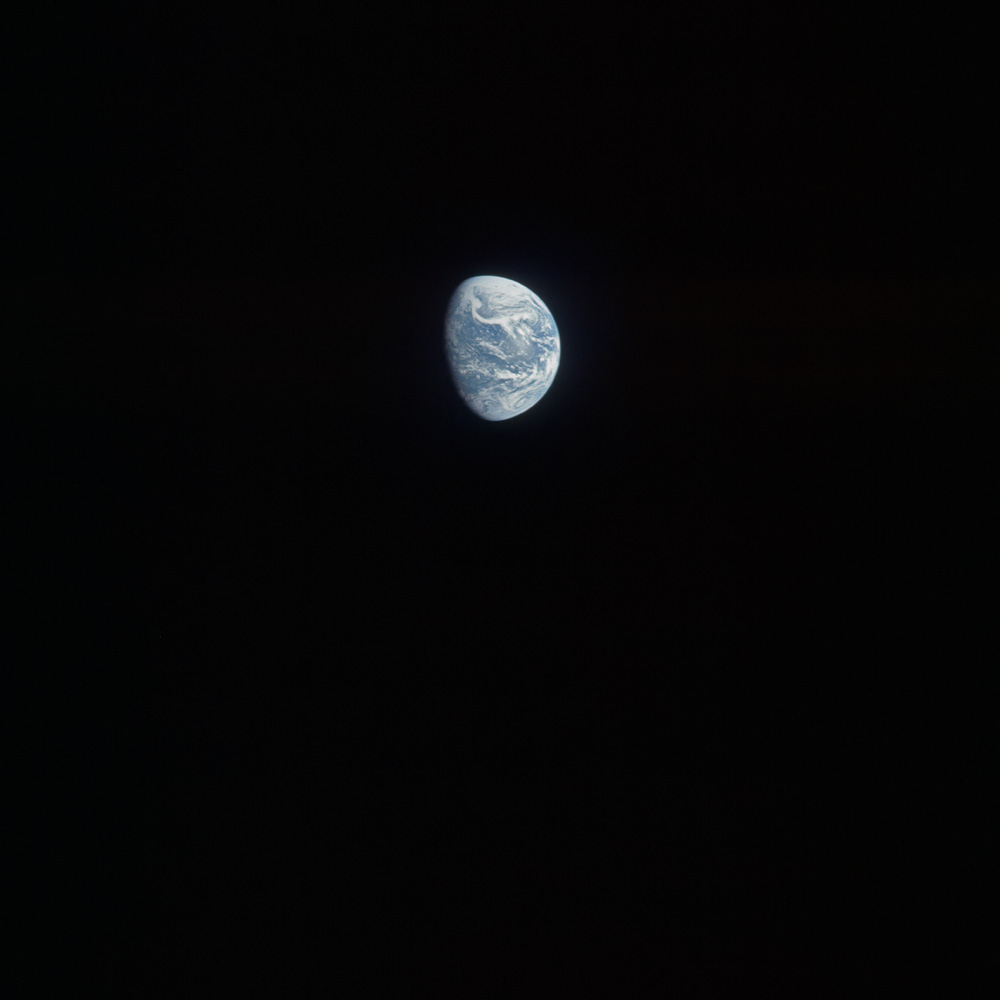
AS17-151-23173 - Earth at 092:40, just prior to setting behind the Moon's night-time limb - JSC scan
092:40:53 Overmyer: Roger, Jack; we've got that.
092:40:59 Schmitt: You've got a lot of healthy weather out there in the Pacific today. Looks like most of those things we talked about yesterday, up in the Hawaii region and also in the south, have intensified.
092:41:17 Overmyer: Roger.
092:45:37 Overmyer: America, Houston. We're about 3 minutes until LOS and everything is looking great. No changes since our Go for DOI. We'll expect to see you at 93:34:24.
092:45:53 Cernan: We'll see you at 93:34:24, Bob.
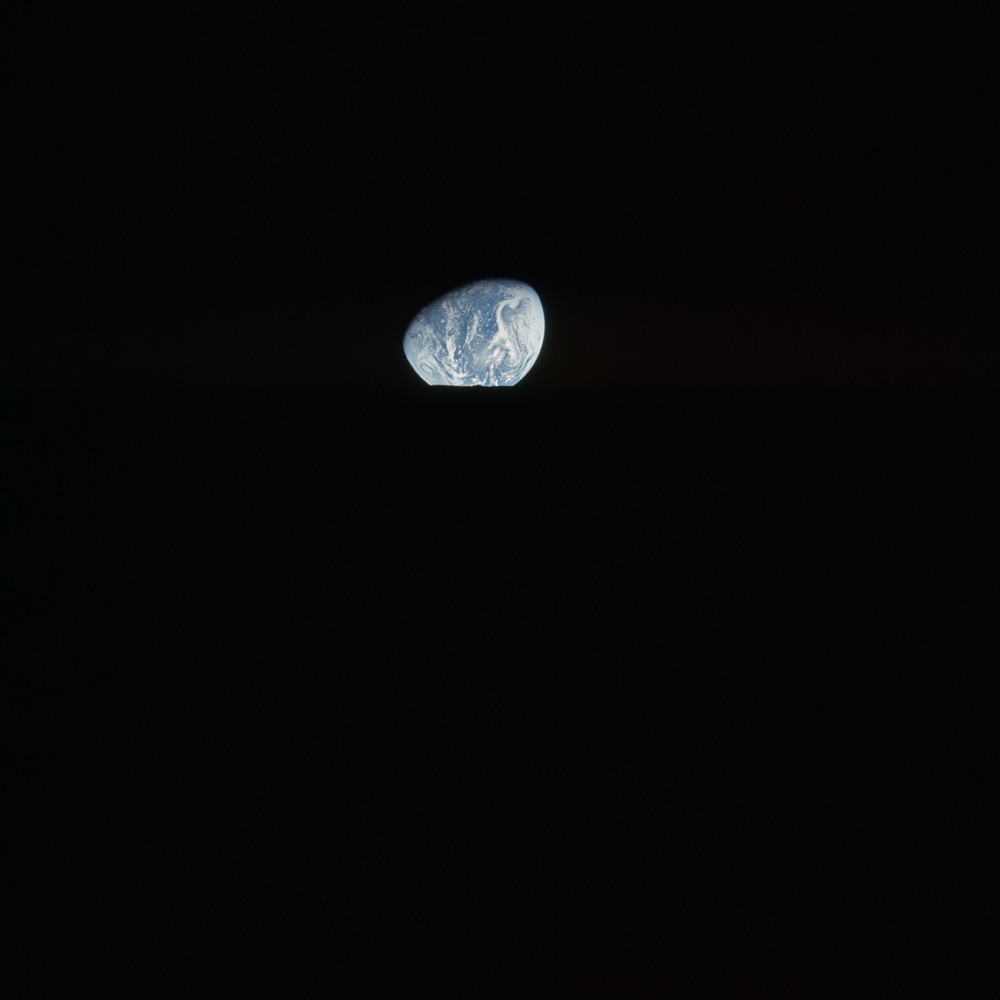
AS17-151-23174 - Earth setting behind the Moon's night-time limb - JSC scan
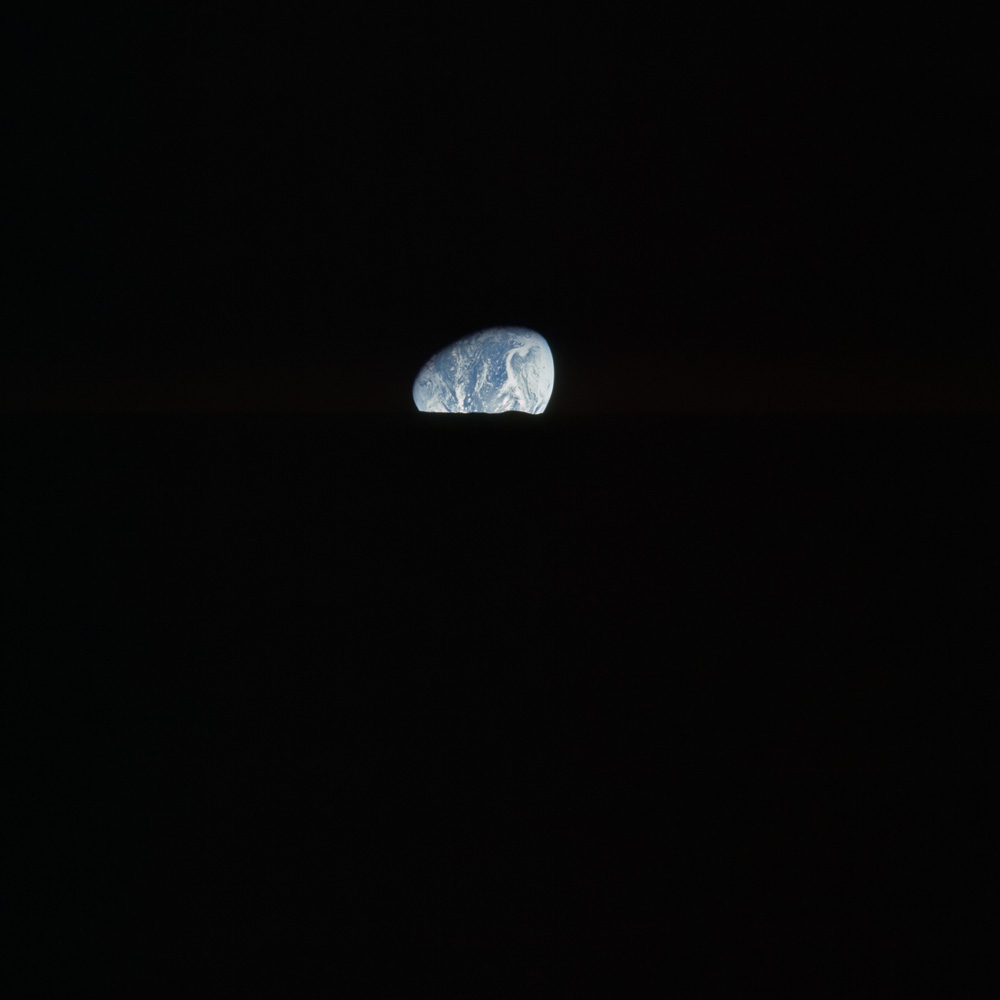
AS17-151-23175 - Earth setting behind the Moon's night-time limb - JSC scan
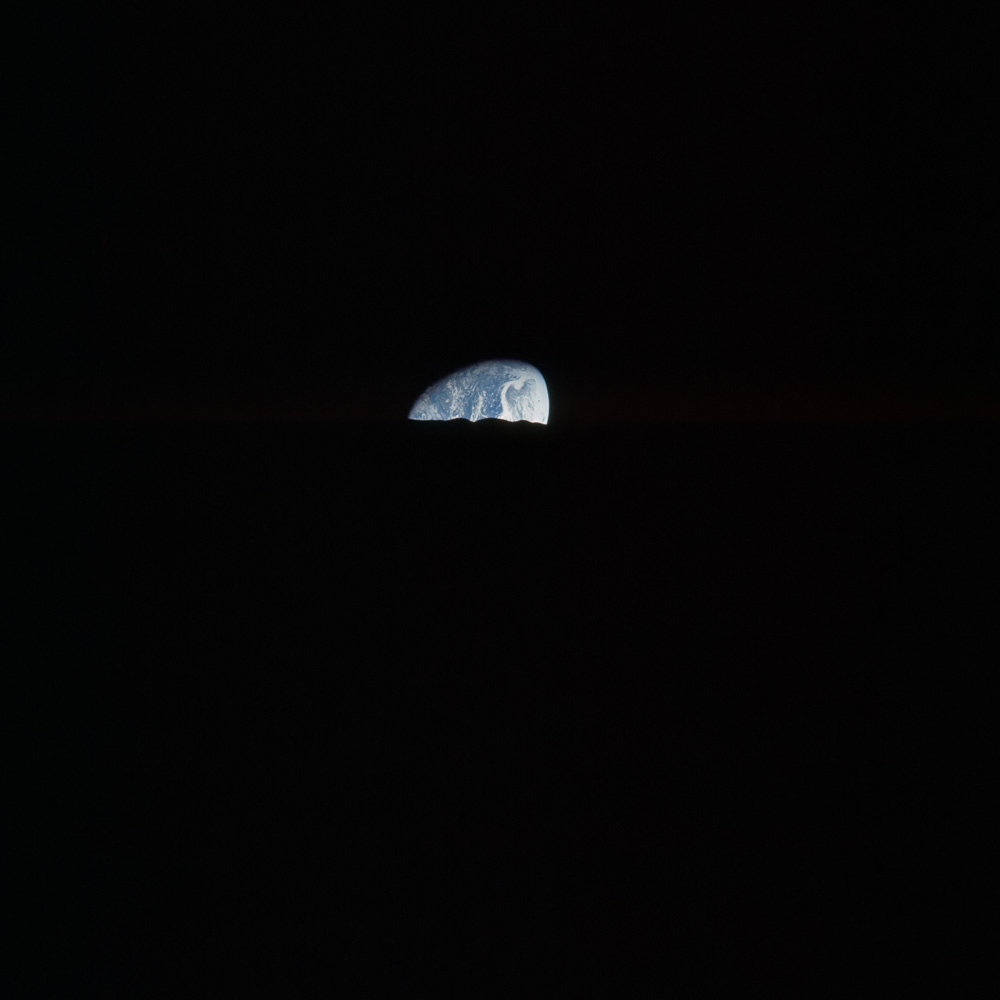
AS17-151-23176 - Earth setting behind the Moon's night-time limb - JSC scan
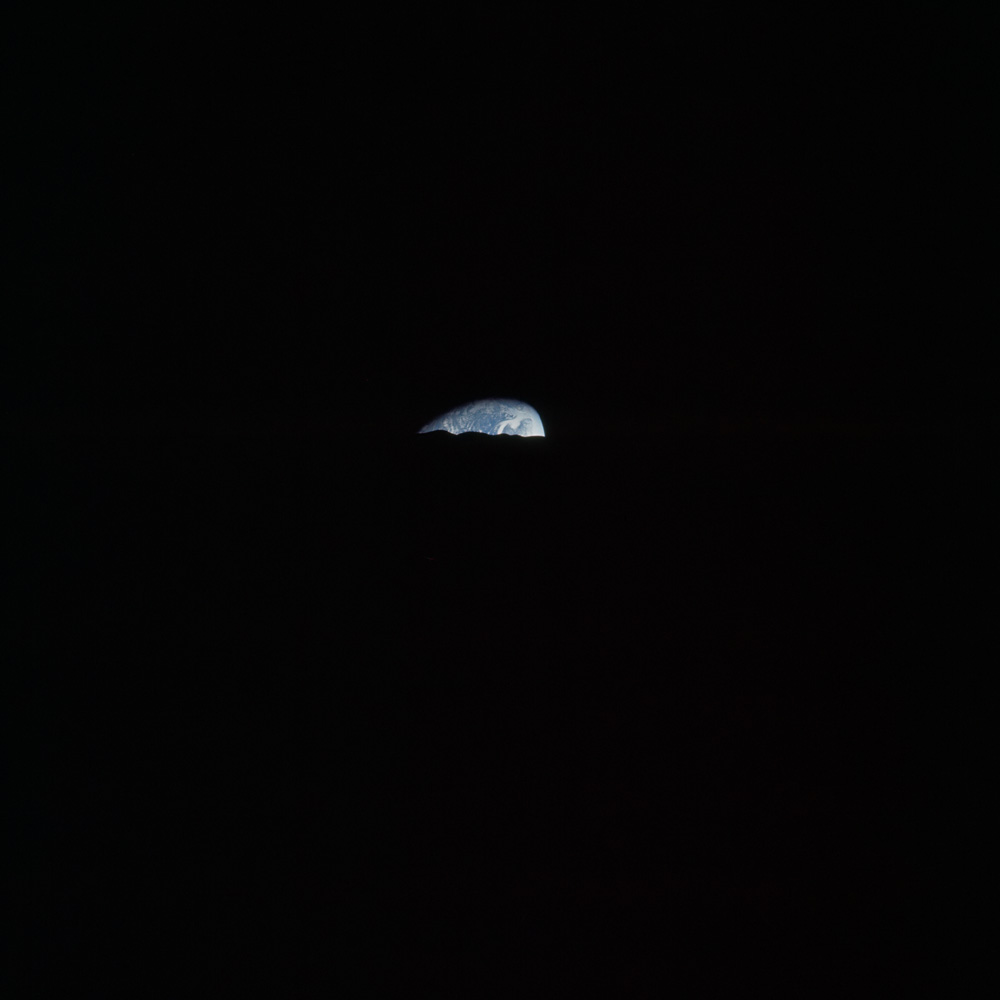
AS17-151-23177 - Earth setting behind the Moon's night-time limb - JSC scan
092:49:03 - This is Apollo Control at 92 hours, 49 minutes. And, we've had Loss Of Signal as Apollo 17 goes behind the Moon. During this pass [means the previous pass], Jack Schmitt saw a flash just north of the crater Grimaldi at an elapsed time of 90 hours, 18 minutes and thought it might be a meteor impact. We could not confirm that; however, the Moon was still ringing from the S-IVB impact and would mask out other activity on seismometer recorders in the science support room here. Apollo 17 will perform the Descent Orbit Insertion maneuver behind the Moon just after the start of the third revolution and at a point near perilune, the low point in that revolution. Ignition time for that maneuver is 93 hours, 11 minutes, 36 seconds. Delta-V, change of velocity of 197.4 feet per second [60.2 m/s]. Duration of the burn, 22 seconds, and we anticipate a result orbit of 58.9 by 14.5 nautical miles [109.1 by 26.9 km]. If the burn is performed as expected, we'll next acquire Apollo 17 at 93 hours, 34 minutes, 24 seconds. If Apollo 17 is unable to perform the burn, acquisition time will be 93 hours, 31 minutes, 37 seconds. We'll come back up just prior to the no-burn acquisition time and stand by through that period of several minutes. At 92 hours, 51 minutes; this is Mission Control, Houston.
092:50:49 Cernan: [Garble] the burn. [yawn] Well, there comes the Sun up already?. Probably. That'll be on our [garble]...
092:XX:XX Schmitt: No. [Garble] That's - Besides, it's out the other way.
092:XX:XX Cernan: Yes. [Garble] Right on the side of the LM. Look at it.
092:XX:XX Schmitt: Yes. Sun's behind it. [Garble].
092:XX:XX Evans: Okay. The burn time is 22.1, bank A open. [Garble]. [Garble]. overburn it 2 seconds. That's a [garble].
092:XX:XX Evans: [Garble] sextant star check. Okay. P40 to 50 18, and bring that beauty behind.
092:XX:XX Cernan: Okay. Check your breakers on panel 8 and your SPS breakers.
092:XX:XX Evans: Direct Ullage. [Garble] right here.
092:XX:XX Evans: Okay, Direct Ullage...
092:XX:XX Schmitt: Oh, you've got that. Okay. I can put it in here.
092:XX:XX Cernan: [Garble].
092:XX:XX Evans: Pilot Valves; okay, they're ail set.
092:XX:XX Cernan: [Garble] you can pull a [garble], but it feels like it.
092:XX:XX Schmitt: [Garble].
092:XX:XX Cernan: Yes.
092:52:51 Schmitt: [Garble] like it?
092:XX:XX Cernan: Yes. No, it's - it's not so bad. It just feels like I pulled a [garble] or something. EPS is doing nothing.
092:XX:XX Schmitt: [Garble] clear. [Garble] the handle.
092:XX:XX Cernan: Yes. Make sure that it's down good.
092:XX:XX Schmitt: [Garble].
092:XX:XX Cernan: Okay. You got all your breakers - Stab Control, panel 8? (Yawn) SPS, 12 Closed?
092:53:20 Evans: Okay. Stab Control; they're all Closed. [Garble].
092:XX:XX Cernan: Okay. SPS, 12 Closed?
092:53:23 Evans: SPS are Closed.
092:XX:XX Cernan: 0kay. Manual Att, three, Rate Command?
092:53:26 Evans: Okay, we're Rate Command.
092:XX:XX Cernan: Attitude Dead Band, Min; Rate, Low.
092:53:31 Evans: Dead Band, Min; Rate to Low.
092:XX:XX Cernan: SCS TVC, two to Rate Command.
092:53:35 Evans: TVCs in Rate Command.
092:XX:XX Cernan: CG switch, LM/CSM.
092:53:39 Evans: Okay. We're in LM/CSM.
092:XX:XX Cernan: Okay. TVC Gimbal Drive Pitch and Yaw, Auto.
092:53:45 Evans: Pitch and Yaw's in Auto.
092:XX:XX Cernan: Okay. We'll stand by for about 6 or 7 minutes.
092:XX:XX Evans: Okay. Should be in good shape.
092:XX:XX Cernan: Okay. If overburn is greater than 2.2 feet per second and less than 10. Well, first of all, if it's less than 2.2, we'll take it out - to 1 foot per second. See then we - If it's between 2.2 and 10, we'll pitch 180 and take it out with the plus-X thrusters.
092:XX:XX Evans: Okay.
092:XX:XX Cernan: If it's greater than 10, we'll use the SPS.
092:54:18 Evans: Okay. 25, Noun [garble] and the...
092:XX:XX Cernan: What are you doing?
092:54:26 Evans: Plus, Enter, plus 228...
092:XX:XX Cernan: Oh, Noun [garble].
092:XX:XX Evans: ...from 180 is - 180 from that is what?
092:XX:XX Cernan: 48.
092:XX:XX Evans: From 228 is - 048.0, right?
092:XX:XX Cernan: What attitude did you put in there?
092:XX:XX Evans: 180 degrees.
092:XX:XX Cernan: Oh.
092:XX:XX Evans: See, that's okay. Then call Verb [garble] and [garble] around. Could have loaded Noun 22, I guess.
092:XX:XX Evans: What are we supposed to be in to acquire ground?
092:XX:XX Cernan: See, you were supposed to be in an omni when you left it, so that has to be High Gain, so how about Omni Charlie?
092:XX:XX Evans: Okay. [Garble] it in Omni Charlie. No. Wait a minute. This says AOS.
092:XX:XX Cernan: Yes, but that's where they - We didn't go to Omni Charlie. We stayed in High Gain.
092:XX:XX Evans: Well, but AOS - We [garble] for the call [garble] change that.
092:XX:XX Cernan: Yes.
092:XX:XX Evans: I'll change it. [Garble] LOS to AOS.
092:XX:XX Cernan: High Gain, plus 9 and 338.
092:XX:XX Evans: Okay. [Garble]...
092:XX:XX Cernan: ...[garble] lock up in the High Gain, go to Omni Charlie.
092:56:24 Evans: Okay. Plus 9?
092:XX:XX Cernan: Plus 9 and 338.
092:XX:XX Evans: That'll be Manual Wide or...
092:XX:XX Schmitt: [Garble].
092:XX:XX Evans: [Garble].
092:XX:XX Cernan: [Garble]. Here it is, right here. Okay. Verb 49 to landmark observation attitude - or bailout attitude. Okay, set High Gain for plus 9 and plus 338, Reacq and Narrow for AOS.
092:XX:XX Evans: For AOS.
092:XX:XX Cernan: Yes. Narrow for AOS.
092:57:08 Evans: Reacq and Narrow. Okay. [Garble].
092:XX:XX Cernan: We want to make sure we get things cleaned up tonight so we can go to bed on time, because tomorrow is one beck of a long day.
092:XX:XX Evans: Yes, it sure is.
092:XX:XX Cernan: We want to get done eating, and get any other cleaning up we want to do or whatever else we want to do and get it out of the way because...
092:XX:XX Evans: I think you guys may want to put your sensors on tonight, too.
092:XX:XX Cernan: ...because sleeping time - Well, I'm going to leave mine on - sleeping time, we want to be ready to go to bed, either by then or before then [garble] at this point [garble]...
092:XX:XX Schmitt: Is that - what's your - [garble] go around in a strange attitude [garble]?
092:XX:XX Evans: Jack, have you got VHBW on that camera?
092:XX:XX Schmitt: No. You want VHB...
092:XX:XX Evans: If you had one quick one, I'd start it at - what, f/4 at 1/250? Right at the terminator?
092:XX:XX Schmitt: Well, stand by 1.
092:XX:XX Evans: I'm sure. It's - pretty much black mare - in - in - Korolev there. I think that's Korolev.
092:XX:XX Schmitt: How am I doing here? Have I still got time?
092:59:03 Cernan: You've got 12 minutes.
092:XX:XX Schmitt: No, I mean for Ron.
09X:XX:XX Evans: Twelve minutes, Jack?
093:XX:XX Schmitt: No. Time for your picture.
093:XX:XX Evans: Yes. [Garble].
093:XX:XX Schmitt: Okay, VHBW. You want - and the - What - what lens?
093:XX:XX Cernan: That one won't be any good.
093:XX:XX Schmitt: Huh ?
093:XX:XX Cernan: Get the other.
093:XX:XX Schmitt: [Garble]. Lit it?
093:XX:XX Cernan: It won't be any good to get what you want, though.
093:XX:XX Evans: Yes, the 80, if you've got one. Otherwise, [garble].
093:XX:XX Schmitt: Well, I'll put it on.
093:XX:XX Schmitt: Here you go.
093:XX:XX Evans: Okay.
093:XX:XX Schmitt: The slide's pulled.
093:XX:XX Cernan: You got it set with the slides pulled?
093:XX:XX Schmitt: No.
093:XX:XX Evans: Okay. [Garble].
093:XX:XX Schmitt: Just a little beyond the terminator, I think.
093:XX:XX Cernan: Well, let's see what [garble] here. [Garble].
093:XX:XX Evans: No manual start; no restart.
093:XX:XX Cernan: No.
093:01:08 Evans: Okay, G&N, do your stuff.
093:XX:XX Cernan: [Garble].
093:XX:XX Evans: Four jets, 15 seconds, isn't it?
093:XX:XX Schmitt: Huh?
093:XX:XX Cernan: Ullage. Ullage is four jets [garble].
093:XX:XX Evans: Four jets, 15 seconds. I think I'm going to have to [garble] these crazy things to make them work.
093:XX:XX Cernan: Have you got DSE?
093:02:02 Evans: There's a couple of places of floating urine on the window.
093:02:33 Evans: That one right over there.
093:XX:XX Schmitt: What one? [Garble]...
093:XX:XX Cernan: That's Galois, isn't it? That one right down there?
093:XX:XX Schmitt: [Garble].
093:XX:XX Cernan: Korolev is - off to your left a little way. There.
093:02:55 Evans: Okay; 8½ minutes.
093:03:26 Cernan: Okay. Tight limits, [garble] over at 10 degrees a second, [garble] 10 degrees. That's the attitude deviation, plus or minus 10. Shutdown is burn time; that's the most critical thing. Trim X to within 1 foot per second. No manual start; no restart.
093:XX:XX Evans: Okay. We'll go 5, 4, 3, 2, 1, shutdown. Right?
093:XX:XX Cernan: That's the [garble] burn time.
093:XX:XX Schmitt: Okay.
093:XX:XX Cernan: Starting at 18?
093:XX:XX Evans: Yes.
093:XX:XX Schmitt: 2 [garble] right?
093:XX:XX Cernan: Starting it at 18.
093:XX:XX Evans: Right. 5, 4, 3, 2, 1.
093:XX:XX Cernan: 18, 19, 20, 21, 22. I'm going to start at 18. 5, 4, 3, 2, 1; that's 18, 19, 20, 21, 22. Because I don't want it to shut it down early; start on 18 to get your 5.
093:XX:XX Schmitt: Gene, it will be late.
093:XX:XX Evans: Late to give you [garble] shutdown. Start on 17: 5, 4, 3, 2, l, shutdown.
093:XX:XX Cernan: Oh, you're going to yell shutdown, I'm sorry.
093:XX:XX Evans: Yes.
093:XX:XX Cernan: I'm sorry. Okay. You're right.
093:XX:XX Schmitt: I'm going to shut it - shut it down on [garble]...
093:XX:XX Cernan: Okay.
093:XX:XX Schmitt: ...[garble].
093:XX:XX Cernan: Okay. Main Bus Ties, On.
093:05:03 Schmitt: Okay. They're going on. A/C's On, and it's good; B/C's On, and it's good.
093:05:XX Cernan: Okay. Tape Recorder; High Bit Rate, Record, Forward, Command Reset.
093:05:17 Schmitt: Okay. High Bit Rate, Record, Forward, Command...
093:05:28 Evans: [Garble]. Check; it's good.
093:05:XX Cernan: Okay. Servo Power; AC 1/Main A?
093:05:31 Evans: Okay. AC 1...
093:05:XX Cernan: And AC 2/Main B.
093:05:33 Evans: ...2. There they are.
093:05:XX Cernan: Okay. Let me get my [garble] Rot Control Power, two, to AC.
093:05:XX Cernan: Directs Off?
093:05:42 Evans: Directs are Off.
093:05:XX Cernan: Okay. BMAGs, 1/2.
093:05:46 Evans: BMAGs are uncaged.
093:05:XX Cernan: Spacecraft Control, SCS.
093:05:50 Evans: Going over; says SCS.
093:05:XX Cernan: Okay. Rot Control; two are Armed.
093:05:55 Evans: Okay; Armed.
093:05:XX Cernan: Pitch 1 and Yaw 1.
093:05:XX Evans: Okay, Pitch 1.
093:05:57 Evans: Mark it.
093:XX:XX Cernan: Got it.
093:XX:XX Evans: Yaw 1.
093:06:00 Evans: Mark it.
093:06:XX Cernan: Got it.
093:06:XX Cernan: Verify trim and set.
093:06:04 Evans: Okay, 1.9. And right there at a minus 0.6 [garble] 4.
093:06:XX Cernan: Minus 0.64, Ron.
093:06:XX Evans: Minus 0.647 Thank you. Minus 0.64...
093:06:XX Cernan: Okay. Verify MTVC.
093:06:22 Evans: MTVC; MTVC. Okay.
093:06:XX Cernan: Okay. Spacecraft Control, CMC.
093:06:XX Cernan: Clockwise?
093:06:29 Evans: Returns to zero, Clockwise.
093:06:XX Cernan: No MTVC?
093:06:31 Evans: No MTVC.
093:06:XX Cernan: Okay, Pitch 2...
093:06:XX Evans: Pitch 2.
093:06:XX Cernan: ...and Yaw 2.
093:06:34 Evans: Mark it.
093:06:XX Cernan: Got it.
093:06:XX Evans: Yaw 2.
093:06:36 Evans: Mark it.
093:06:XX Cernan: Got it.
093:06:XX Cernan: Set GPI trim.
093:06:39 Evans: Okay. 1.9...
093:06:XX Cernan: 1.9 plus.
093:06:42 Cernan/Evans: And minus 0.64.
093:06:XX Evans: Okay; it's [garble].
093:06:XX Cernan: Verify MTVC.
093:06:48 Evans: Minus, plus, plus, minus [garble] Okay. Try yours.
093:06:XX Cernan: Okay; mine's good.
093:06:XX Evans: Okay.
093:06:XX Cernan: Hand Controller, Neutral?
093:07:00 Evans: Neutral; returns to...
093:07:XX Cernan: Verify...
093:07:XX Evans: ...zero.
093:07:XX Cernan: ...no MTVC?
093:07:03 Evans: No MTVC.
093:07:XX Cernan: Okay. Verify returns to zero; it did.
093:07:XX Evans: It did.
093:07:XX Cernan: Rot Control Power, two, AC to [sic] DC.
093:07:XX Cernan: Okay. Directs, Main A/Main B.
093:07:12 Evans: Directs are Main A and Main B.
093:07:XX Cernan: Okay. BMAGs, Rate 2.
093:07:16 Evans: BMAGs are caged.
093:07:XX Evans: [Garble].
093:07:XX Cernan: Okay. That's [garble].
093:07:XX Evans: Okay. It looks like we're there.
093:07:XX Schmitt: Looks like it liked you, didn't it?
093:07:XX Evans: Yes. Try it one more time and see if you [garble].
093:07:XX Cernan: Yes.
093:07:XX Evans: Okay. [Garble] for [garble] control.
093:07:XX Cernan: Okay. You've got a half?
093:07:40 Evans: MAGs, 1/2.
093:07:XX Cernan: Okay. Ready for a gimbal drive?
093:07:XX Evans: Okay.
093:07:48 Cernan: Okay. PRO.
093:07:49 Evans: Plus, 2, minus 2, 0, plus 2, minus 2, 0. Ta - ta-tum-tum.
093:08:06 Evans: There's the trim.
093:08:XX Cernan: Saw it all over here. Plus 1.9 and minus 0.6.
093:08:12 Evans: Okay; 3 minutes to go.
093:08:XX Cernan: Okay. Scale 5/1?
093:08:16 Evans: Scale 5/1.
093:08:XX Cernan: Rate, High.
093:08:20 Evans: Rate to High.
093:08:XX Cernan: Okay. At 59, we go EMS, Normal.
093:08:25 Evans: Okay. Let's go EMS Normal in 30 seconds or so.
093:XX:XX Cernan: Okay.
093:XX:XX Evans: Trans Control Power - We go Normal, Trans Control Power, and Delta-V Thrust all at the same time in 30 seconds.
093:XX:XX Cernan: Okay; and you want four-jet ullage at 15 seconds. You've got a four jet there, don't you?
093:XX:XX Evans: Ah - I think so. Yes. [Garble] four - 946 four jets. Okay.
093:XX:XX Cernan: Think we'll be in in a 14 [garble]? l4½ miles; we is really going to be coming down among them; whoo.
093:XX:XX Schmitt: Fourteen and a half, huh?
093:XX:XX Cernan: From 170 to l4½.
093:XX:XX Schmitt: My gosh! Look at that hill there.
093:XX:XX Evans: [Chuckle] Looks [garble] again. Everything's backwards. There's a big chunk of stuff out there, rolling around. See it?
093:XX:XX Cernan: Rolling around?
093:XX:XX Evans: Out the left window over here.
093:09:31 Cernan: Two minutes.
093:XX:XX Evans: Two minutes.
093:XX:XX Schmitt: I really like this [garble].
093:XX:XX Evans: [Garble].
093:XX:XX Evans: [Garble] armed. All the switches. Good.
093:10:XX Evans: 01:30.
093:10:XX Cernan: Okay. You'll shut down on Jack's burn time, regardless.
093:10:XX Evans: Yes.
093:10:XX Cernan: Make sure you listen, so we - so you get the right lead.
093:10:XX Evans: I will.
093:10:XX Evans: Did you start your watch [garble]?
093:10:XX Cernan: Yes.
093:10:38 Cernan: Okay; 1 minute.
093:XX:XX Evans: Okay.
093:XX:XX Spacecraft: [Whistling]
093:XX:XX Cernan: Okay, [garble] 17 feet per second [garble] 2 seconds. Yes, should have [garble] seconds.
093:XX:XX Cernan: Okay. DSKY blanks.
093:11:04 Evans: [Garble] EMS to Normal; Trans Control Power, On; Delta-V Thrust A is On.
093:11:XX Cernan: Okay, at 15 seconds, you can start thrusting.
093:11:XX Evans: Okay.
093:11:XX Cernan: I'll get the PRO.
093:11:XX Evans: You'll get the PRO.
093:11:22 Cernan: 16, 15 - Okay, there's ullage.
093:11:XX Evans: Got the ullage coming?
093:11:XX Cernan: See it on EMS.
093:11:XX Evans: Yes.
093:11:XX Cernan: See it on the DSKY.
093:11:XX Evans: On the DSKY.
093:11:XX Cernan: 7, 6, - 99...
093:11:XX Evans: Okay.
093:11:XX Cernan: 3, 2...
093:11:XX Evans/Cernan: 1...
093:11:37 Cernan: Mark it.
093:11:XX Schmitt: Got it.
093:11:XX Evans: Okay.
093:11:38 Cernan: Ignition.
093:11:XX Evans: ...[garble] the thrusters? Pitch [garble] Looks good over here.
093:11:XX Cernan: Okay.
093:11:XX Evans: Looks good. Okay, it's coming up...
093:11:XX Schmitt: Fifteen seconds to burn. Computer looks good, like it's going to be on. It says 10 to burn. I think computer's going to shut you down on time.
093:11:XX Schmitt: Stand by.
093:11:59 Schmitt: Fa - Shutdown. I'm sorry.
093:XX:XX Evans: Okay.
093:XX:XX Cernan: That's all right. Computer shut you down. That's all right.
093:XX:XX Evans: Computer shut it down; that's all right.
093:XX:XX Cernan: It was on time.
093:XX:XX Schmitt: I did this same darn thing in the simulator the other day.
093:XX:XX Evans: Okay.
093:XX:XX Cernan: Okay.
093:XX:XX Evans/Cernan: That's all right...
093:XX:XX Evans: We had [garble] one time.
093:XX:XX Cernan: 22 seconds...
093:XX:XX Evans: 198.2.
093:XX:XX Cernan: Let me - let me get them. It was right on time.
093:XX:XX Evans: Right on time.
093:XX:XX Cernan: Good over here.
093:XX:XX Evans: Okay. Pitch 2, Jack?
093:XX:XX Schmitt: Go ahead.
093:12:20 Evans: Mark it.
093:12:XX Schmitt: Got it.
093:12:XX Evans: Yaw 2.
093:12:22 Evans: Mark it.
093:12:XX Schmitt: Got it.
093:12:XX Evans: Okay, once.
093:12:25 Evans: Mark it.
093:12:XX Schmitt: There's a zip. That was beautiful.
093:12:XX Evans: [Garble] once.
093:12:28 Evans: Mark it.
093:12:XX Schmitt: Got it; 0.1.
093:12:XX Evans: Okay, let's see. It's just - picking up attitude again. All right.
093:12:42 Evans: Okay. Delta-V Thrust - are Off; Gimbal Motors, Off; Servo Power 1 and 2 is Off. Okay, residuals - you got those? Okay, Trans Control, Locked; Locked. And let's see, Directs are Off. Direct Ullage circuit breakers, two are Open; Pitch 1; that one is Open; record the Delta-V counter and the residuals.
093:XX:XX Schmitt: What was it? Plus or minus?
093:XX:XX Evans: Plus 0.1. And I - it went on at 30 seconds [garble].
093:13:27 Evans: Okay. EMS Function, Off; Attitude Dead Band to MAX; BMAGs caged. Okay, Bus Ties?
093:13:XX Schmitt: Okay. Coming off.
093:13:XX Evans: Okay.
093:13:40 Schmitt: There's one, Off; two went Off.
093:13:44 Evans: Okay; Bit Rate to Low?
093:XX:XX Cernan: No, no. You delay that until...
093:XX:XX Evans: Oh, that's...
093:XX:XX Cernan: ...94:10.
093:XX:XX Evans: Oh. Okay. Delay that until 94:10.
093:XX:XX Evans: [Garble] look [garble].
093:XX:XX Cernan: Okay.
093:XX:XX Evans: Okay. Let's see. You got a Verb 66?
093:XX:XX Cernan: Yes. [Garble] anyhow, it looks like. Okay. Verb 49. Go to 020.
093:14:13 Cernan: Okay. Plus 20.00.
093:14:XX Schmitt: Okay. And 293 and zero.
093:14:XX Cernan: [Garble].
093:14:XX Evans: Okay. And then you got the [garble] DAP. 50 18 [garble] chamber pressure got up to 95 that time.
093:14:XX Cernan: Still got a bias there.
093:14:XX Evans: Still got the bias, but...
093:14:XX Cernan: It may have been a [garble].
093:14:XX Evans: Yes. It's...
093:14:XX Schmitt: [Garble] bias.
093:14:XX Evans: Yes.
093:14:42 Schmitt: Yes. It could have been [garble]. Okay. Oxidizer is 30.5; fuel is 31.1. And I'm now 150 decrease.
093:XX:XX Cernan: [Garble].
093:XX:XX Schmitt: That's right. [Garble] Ox [garble]?
093:XX:XX Cernan: Yes.
093:XX:XX Schmitt: [Garble] wondered - Okay, good. I was just wondering if we were in there.
093:XX:XX Cernan: Yes. You know, it used to be...
093:XX:XX Schmitt: ...[garble].
093:XX:XX Cernan: It used to be the other way. It used to be the opposite of what he gave you.
093:XX:XX Schmitt: What he gave you. Yes.
093:XX:XX Cernan: Somebody changed it [garble].
093:XX:XX Evans: That somebody is your CMP.
093:XX:XX Schmitt: Could be confusing.
093:XX:XX Evans: (Laughing) Yes, I guess it is.
093:XX:XX Schmitt: Okay. Let's see.
093:XX:XX Cernan: I want to find out what kind of...
093:XX:XX Schmitt: Get your landmark tracking.
093:XX:XX Cernan: ...[garble] is.
093:XX:XX Schmitt: Set High Gain. Okay.
093:15:36 Cernan: Okay. High Gain is plus 9 and plus 338, I guess.
093:XX:XX Schmitt: Okay.
093:XX:XX Evans: Okay.
093:XX:XX Cernan: Okay, we'll pick up that SIM prep [garble] in about an hour, Jack, postburn SIM prep.
093:XX:XX Schmitt: Okay.
093:XX:XX Cernan: Well, that should be about a couple of minutes.
093:XX:XX Evans: Gosh dang-it, I wish those craters would turn around the other way.
093:XX:XX Schmitt: Okay. What else?
093:XX:XX Cernan: Ron, go to - Well, when we pick it up, we've got our - the big thing is Noun 89.
093:XX:XX Evans: Look at that big scarp going [garble] over there...
093:XX:XX Cernan: P24. Hey, Ron.
093:XX:XX Evans: Huh?
093:XX:XX Cernan: Put your switches in Accel. I want to call up Verb 82 in a minute. And then I'll switch you back over.
093:XX:XX Evans: Okay.
093:XX:XX Evans: 59.1 by 14.9. That'll be pretty close to what we figured, huh?
093:XX:XX Cernan: Yes.
093:XX:XX Evans: Okay.
093:XX:XX Cernan: Ready?
093:XX:XX Evans: [Garble] 10 degrees [garble] I wish I could look out there and recognize a crater right off the bat, but I can't do that yet.
093:XX:XX Schmitt: Well, you're right over Chaplygin, I believe.
093:17:04 Evans: Right over Chaplygin?
093:XX:XX Schmitt: Yes.
093:XX:XX Cernan: Just passed it.
093:XX:XX Evans: We must be past it. I don't see it.
093:XX:XX Schmitt: No. It's down over there.
093:XX:XX Evans: Oh, there it is over there.
093:XX:XX Cernan: There's those - turtle...
093:XX:XX Schmitt: Yes.
093:XX:XX Evans: Okay. There's the lovelets.
093:XX:XX Cernan: ...[garble]. Yes.
093:XX:XX Evans: There's the lovelets. Okay, so that's south of that - What's that big one south of the - the lovelets?
093:XX:XX Schmitt: That's got to be...
093:XX:XX Evans: Marconi. This is Marconi over here.
093:XX:XX Cernan: I can't see too much from down under this...
093:XX:XX Schmitt: Marconi.
093:XX:XX Evans: What time do I have to do that landmark tracking?
093:XX:XX Schmitt: [Garble].
093:XX:XX Cernan: Yes, you...
093:XX:XX Schmitt: [Garble].
093:XX:XX Cernan: Load Noun 89. What are the numbers for loading Noun 89?
093:XX:XX Schmitt: Hand me your orbital chart...
093:XX:XX Evans: It's [garble].
093:XX:XX Cernan: [Garble] Noun 89 [garble].
093:XX:XX Evans: J-3.
093:XX:XX Cernan: I have the numbers for J-3. [Garble].
093:XX:XX Cernan: Plus 9 - plus 19.948, plus 20.051, plus all balls.
093:XX:XX Evans: Okay.
093:XX:XX Cernan: Okay.
093:XX:XX Evans: Maybe I'd better get some [garble] on [garble], just in case.
093:XX:XX Cernan: Oh heck, we've got - What'd I say? Nine - We're at 93:18. We've got a long time before AOS.
093:XX:XX Evans: Oh, yes, before AOS gets here.
093:XX:XX Schmitt: Yes. Marconi was the one [garble]...
093:XX:XX Evans: Marconi is the one south of it.
093:XX:XX Cernan: Yes?
093:XX:XX Evans: That's the one I ought to recognize because that's...
093:18:53 Evans: Okay. [Garble] is norm, 1 frame per second, f/60. Let's see, it's pretty high Sun in here.
093:19:04 Cernan: Pannekoek or something like that, isn't it?
093:XX:XX Cernan: And there's old Mendeleev.
093:XX:XX Evans: [Garble] screwed up the focus.
093:XX:XX Evans: Yes, there she is.
093:XX:XX Cernan: The albedo changed on the inside of that crater right there, Jack. It's probably the same thing that gives the albedo change on - on the - this little one right here. The white albedo; it's probably the same albedo - type albedo change you get on the - on the - slide.
093:20:06 Schmitt: Yes. I don't know what produces it. You get this...
093:XX:XX Cernan: Well, even on the inside of all these walls...
093:XX:XX Schmitt: ...this particular exposure, it just never darkens.
093:XX:XX Cernan: See, you can - see it on all those walls. Any time there's movement, there's a darkening effect that has to do with - the sitting - you know, the varnishing or whatever you want to call it.
093:XX:XX Evans: Boy - have we got - a picture right there.
093:XX:XX Cernan/Schmitt: Oh, yes.
093:XX:XX Evans: Get that.
093:XX:XX Cernan: We are coming down, friend.
093:XX:XX Schmitt: [Garble] high. What the heck is that?
093:XX:XX Cernan: The right attitude.
093:XX:XX Schmitt: The right attitude? What are we, about subsolar on there?
093:XX:XX Cernan: Subsolar at - 27.
093:XX:XX Schmitt: About 5 minutes?
093:XX:XX Evans: Sure gets bright through this telescope.
093:XX:XX Cernan: Did you hit Enter?
093:XX:XX Schmitt: Yes, I hit Enter.
093:XX:XX Cernan: Okay, next thing around is - is, after AOS, burn report, and then Noun 89. Let me doublecheck those.
093:21:34 Evans: 19.948 and 20.051. Boy, it's going to be bright. Whew.
093:XX:XX Cernan: Okay, and then - P2H.
093:XX:XX Evans: Okay.
093:XX:XX Cernan: Well, you're going to have - have to tell me how I can help you with that one.
093:XX:XX Evans: I just hope I can recognize Macrobius A and B. I think I can.
093:XX:XX Cernan: Oh, yes.
093:XX:XX Evans: I had a good look...
093:XX:XX Cernan: I think you had a good look at it before...
093:XX:XX Evans: I had a good look at it the last time. Then I've got to know...
093:XX:XX Cernan: Your - your land - J-3 is right between them. Closer to...
093:22:13 Evans: Yes, but there's a whole bunch of them right between there, and I want - Let me take one more look at that now.
093:22:XX Schmitt: Yes, we got a mapping camera pass of that, too.
093:22:XX Evans: We do?
093:22:XX Schmitt: Don't we? Didn't we pass - didn't we take a mapping camera...
093:22:XX Evans: Oh, yes.
093:22:XX Schmitt: [Garble]. When you [garble].
093:22:XX Cernan: Yes, we - we...
093:22:XX Evans: Oh, with the pan?
093:22:XX Schmitt: Yes.
093:22:XX Evans: No, those - those only - See, I've got a strip across here, too. Right now, we should be going across Arabia aren't we?
093:22:XX Schmitt: You want that picture, Ron?
093:22:44 Evans: Yes. I've got the whole back side, essentially.
093:XX:XX Schmitt: Have you got that [garble] somewhere?
093:XX:XX Cernan: There it is...
093:XX:XX Schmitt: Which way?
093:XX:XX Cernan: ...There with the [garble].
093:XX:XX Schmitt: Okay.
093:XX:XX Evans: Take a look at J-3 again. It says Farouk Crater.
093:XX:XX Cernan: [Garble].
093:XX:XX Evans: What is it?
093:XX:XX Schmitt: Well, it's - I guess it's...
093:XX:XX Cernan: They got this listed wrong. I guess it's Arabia.
093:XX:XX Evans: [Garble] J-3...
093:XX:XX Schmitt: They've got ... listed up with - I guess it's ..., but look at that perspective as we get lower.
093:XX:XX Cernan: What? Yes (chuckle). We're getting down.
093:XX:XX Evans: Man, I've got to have something to [garble] brightness.
093:XX:XX Cernan: We're getting down.
093:XX:XX Cernan: Man, are we getting down.
093:XX:XX Schmitt: Is that King? Is that what you...
093:XX:XX Cernan: Yes, that's King, because that's where that - gray from - whatever the heck that one is over there - up through there, on the north there.
093:XX:XX Evans: Giordano Bruno.
093:XX:XX Cernan: Yes. Giordano Bruno. Let me see, I've got a couple of buddies that are named Giordano and Bruno.
093:XX:XX Schmitt: They're Grecian, aren't they?
093:24:00 Cernan: These guys are Italian. How high are those mountains in that central peak?
093:XX:XX Evans: I don't know.
093:XX:XX Cernan: Ten thousand feet, maybe?
093:XX:XX Schmitt: Oh, they're probably - Well, we're still...
093:XX:XX Cernan: No, I don't think they're that high.
093:XX:XX Schmitt: Let's see, we're still - we're still close to 100,000 miles - 100,000 feet.
093:XX:XX Evans: Hey, Jack, do you have that circle thing on here? Does it have anything for landmark tracking?
093:XX:XX Schmitt: Circle?
093:XX:XX Evans: Yes, you know, that - photography thing? Versus latitude? Is there a scale on there for landmark tracking?
093:XX:XX Schmitt: [Garble] photography shutter rate.
093:XX:XX Evans: Yes. For J-3, which is going to be about - the other side of Crisium.
093:XX:XX Schmitt: Looks like you want 1/60.
093:XX:XX Evans: 1/60?
093:XX:XX Schmitt: Do you buy that?
093:XX:XX Evans: J-3; it's about 40 degrees longitude?
093:XX:XX Schmitt: Yes.
093:XX:XX Evans: Yes. 1/60 sounds good then.
093:XX:XX Cernan: Look at that. Isn't that impressive?
093:25:14 Evans: Okay. There's a dark halo, and then there's a bright one.
093:XX:XX Schmitt: It looks like something just rolled over - rolled over that scarp or the...
093:XX:XX Cernan: There's a collection of blocks out there on the peak.
093:XX:XX Schmitt: Hey.
093:XX:XX Evans: There's a black flow.
093:XX:XX Cernan: Boy, does it ever...
093:XX:XX Schmitt: Now, here's that - here's some more of that - maybe some of those light albedo scarps. See it coming up in here? The gray - the gray and the dark mixed. The gray's sort of [garble].
093:27:15 Evans: Okay, Gene, as soon as I finish this P24, you can give me those - those new Noun 89s to load up.
093:XX:XX Cernan: Okay.
093:XX:XX Evans: Optics; Speed to High, Resolve, Slave to Sextant.
093:XX:XX Cernan: The view is north. [Garble].
093:XX:XX Cernan: That black stuff farther up - It looks like there's a crater that hit the side over here - but that black stuff - it may be glass, but it sure flowed down that hill.
093:XX:XX Schmitt: Just ahead?
093:XX:XX Schmitt: Big crater out here to the...
093:XX:XX Cernan: One right under you?
093:XX:XX Schmitt: Whatever direction I'm looking now.
093:XX:XX Schmitt: Who took the Flight Plan from me?
093:28:57 Evans: I've got it right here. You want it? No, this is not the Flight Plan; this is...
093:XX:XX Schmitt: Just want to make sure no mention - Let's see, we don't have anything until AOS.
093:XX:XX Cernan: I don't know, Jack. I don't - I don't remember. Remember we're looking at - that's the one that...
093:XX:XX Schmitt: I'm looking.
093:XX:XX Cernan: I was just talking about now where that - it looks like a - something hit the side, and glass flowed over the...
093:XX:XX Schmitt: Yes.
093:XX:XX Cernan: It looks like a crater on an angle, a crater on an angle - or in the wall of the big crater.
093:XX:XX Schmitt: Looks like it's a flow out of the side of the crater...
093:XX:XX Cernan: Yes.
093:XX:XX Schmitt: ...at that.
093:XX:XX Cernan: Well, yes, but it looks - there's such a big hole there, it looks like something must have hit it, and - and then caused something to flow out.
093:30:00 - This is Apollo Control at 93 hours, 30 minutes. We're a minute and a half away from acquisition without a burn; 4 minutes, 10 seconds away from acquisition given a nominal Descent Orbit Insertion burn. Acquisition between those two times would indicate a partial burn of some kind. We'll leave the line up now.
093:XX:XX Schmitt: Boy, there's a lot of that swirl out in here when you start looking for it.
093:30:36 Cernan: Whereabouts are we, Jack? I don't have a map.
093:XX:XX Schmitt: Okay, about where we - Let's try to figure that one out.
093:XX:XX Cernan: Okay.
093:XX:XX Cernan: It's about AOS time. We're coming up on AOS.
093:XX:XX Schmitt: Okay.
093:31:10 Schmitt: We're 107 degrees west now - east, 107 east. And AOS is like - [garble] - like in 1 minute. I'm sorry, like in 3 minutes - 3 minutes.
093:XX:XX Evans: Okay, Gene, you ought to be looking at Moiseev. That one, that one, and right under us is Moiseev. [Garble] got [garble] there.
093:XX:XX Cernan: Hey, you know, we're lower. We're not going to have the same perspective we had.
093:31:55 - We've passed the no-burn AOS time and do not have a signal. That's an encouraging sign that we did perform a maneuver.
093:XX:XX Evans: What's that big thing we're going over now - coming up?
093:XX:XX Cernan: I don't know, Ron, we're already past it.
093:XX:XX Evans: We've past it?
093:32:05 Cernan: Well, we are - our field of view is.
093:XX:XX Evans: Why that - should be going that way.
093:XX:XX Cernan: Yes, but we've got to look over the LM. We're looking - [garble]...
093:XX:XX Evans: Oh, you're looking over the LM? Oh, okay.
093:XX:XX Cernan: Looking way out in front right now.
093:XX:XX Evans: Oh, that's right, you can't look down.
093:XX:XX Schmitt: Well, Dreyer ought to be off to the - left over here.
093:XX:XX Evans: [Garble] 250 on [garble].
093:XX:XX Schmitt: [Garble] to get in there, but [garble].
093:XX:XX Cernan: Okay, there's Marginis coming up.
093:XX:XX Schmitt: Yes.
093:XX:XX Cernan: Okay, well, this one right here is - I think - Yes. I'm looking right here. I'm looking at Mor - Macrobius right here.
093:XX:XX Schmitt: [Garble]?
093:XX:XX Cernan: No, I'm sorry, I'm not. I'm not. I can't...
093:XX:XX Evans: What...
093:XX:XX Schmitt: [Garble] Macrobius is right over here.
093:33:26 Evans: What - Noun 89, Gene?
093:XX:XX Cernan: For what?
093:XX:XX Evans: For that J-3.
093:XX:XX Cernan: J-3, 19 - You want a new one?
093:XX:XX Evans: Yes. Darned thing changed, didn't it?
093:XX:XX Cernan: Yes. Okay, better load it. 19.948. You ready?
093:XX:XX Evans: Okay.
093:XX:XX Cernan: 19.948, 20.051, 0. That looks good.
093:XX:XX Evans: Okay.
093:34:12 Cernan: There's Al-Biruni, isn't it?
093:34:XX Cernan: Yes, there's Al-Biruni, Jack, right out there.
093:33:24 - One minute to nominal AOS.
093:34:XX Cernan: Okay, here comes AOS. [Garble] have them.
093:34:XX Evans: Yes, it is.
093:34:25 - We have a signal, right on the money.
093:34:50 Cernan: Hello, Houston; America.
093:34:54 Overmyer: America, Houston. Go ahead.
093:35:00 Cernan: Okay. And the burn was good on all counts, 22-second burn. It was on time, V
GX, 1982; roll after the burn, 357, 225, and 003. Residuals were plus 0, plus 0.2, and plus 0.1. Delta-V
C is 0.1, and that was with Delta-V total set into the EMS. Should have been - should been zero and the residual on the EMS was plus 0.1. Oxidizer's 305, and Fuel is 311 and an Unbalance of 150 Decrease. We're in a 59.1 by 14.9 [nautical-mile orbit, 109.5 by 27.6 km].
093:35:55 Overmyer: Okay, America; sounds great.
093:36:01 Cernan: It looks pretty great.
093:36:14 Cernan: We're getting back down among us where us plain folks belong.
093:36:20 Overmyer: Roger.
093:36:45 - Those orbital numbers are an on-board readout, we'll confirm those in a few minutes after some tracking.

